
JANUARY/FEBRUARY 2024 www.bmwmoa.org
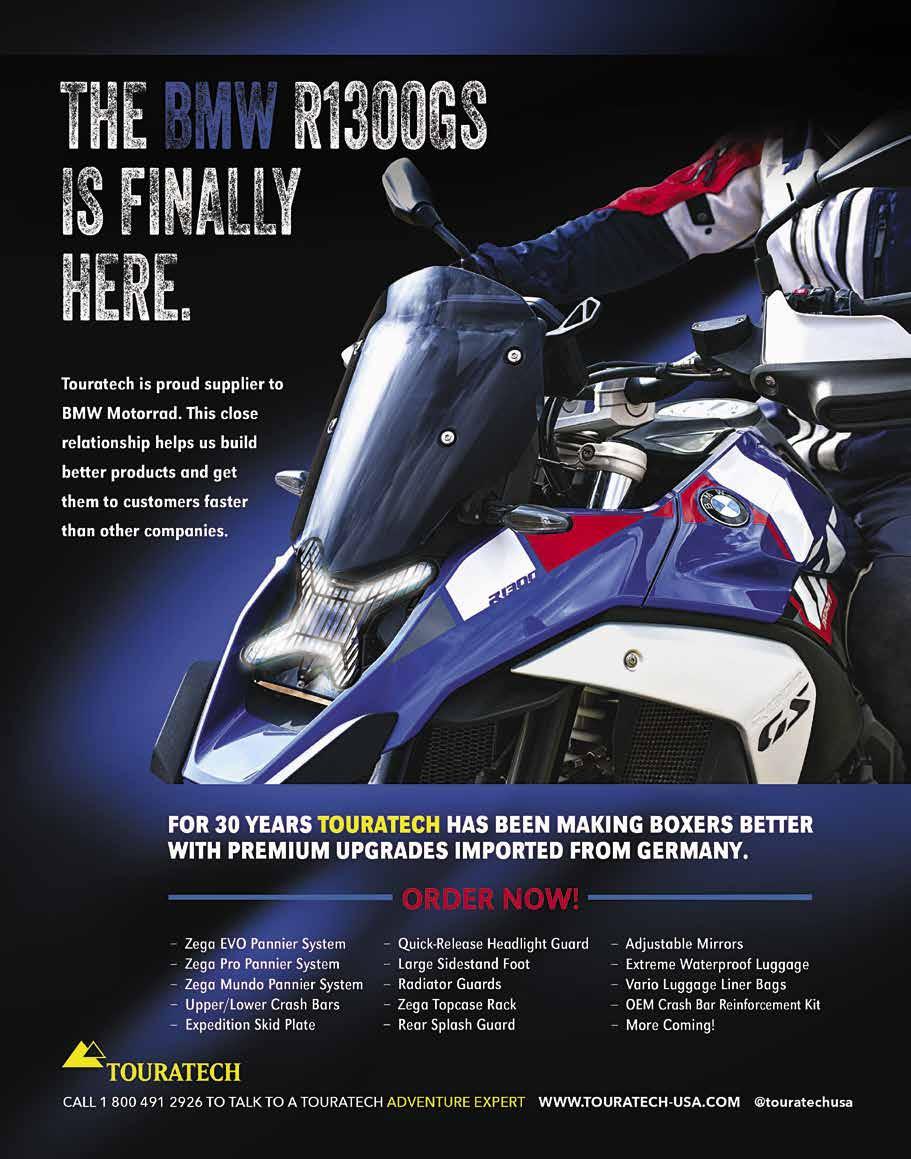

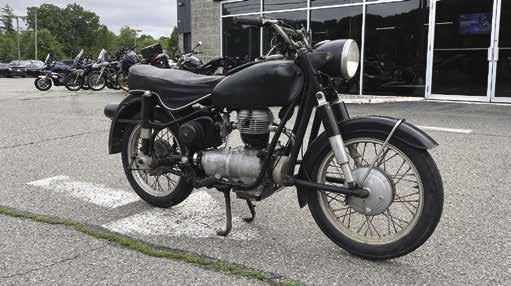
When this R26 came to us for an evaluation, it was obvious from the included photos that this bike was the customer’s loyal old friend.
After dropping a valve almost 50 years ago, it was time to get it running again. Our team rebuilt the motor with a full crank service and then the customer took over for the wiring and final details needed to get the bike back on the road. We’re always happy to lend a hand, provide advice, and source parts for the work you want to do yourself, and we’re also here for the bigger mechanical challenges and painting in our enclosed booth.
If you have a project that’s been sitting in the garage for a while, give us a call to see how we can help!
it comes to your winter project, we’ll help as much or as little as you want. Have a project you need help with or have other questions? Call us at 203-740-1270 Shop our parts catalog at maxbmw.com or send an e-mail to francis@maxbmw.com
When
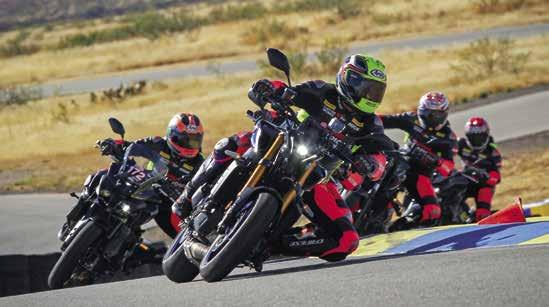


FEATURES
54 ATGATT: TO NECK BRACE OR NOT TO NECK BRACE
BY DUSTIN SILVEY #224778
62 MASTERING YOUR MACHINE: SMALL CHANGES OFTEN MAKE THE BIGGEST IMPACT
BY KANDI SPANGLER #220021
68 NICK IENATSCH: TEACHING SKILLS TO DIMINISH RISK
BY ED HOUSEWRIGHT #234070
74 YAMAHA CHAMPIONS RIDING SCHOOL
BY ED HOUSEWRIGHT #234070
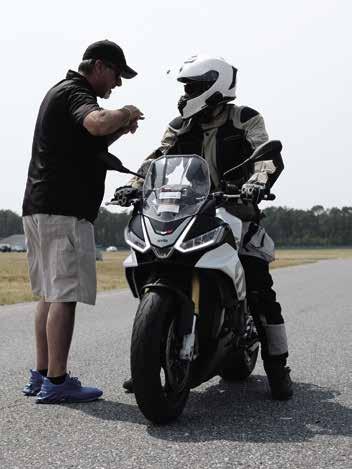
80 CHAMPU ONLINE COURSES
BY MARK BARNES #222400
84 CHAMPBODY: HOW IS YOUR RIDING FITNESS?
BY TAMI BAKKE #222479
86 MOTORCYCLE REVIVAL AT DUKE UNIVERSITY
BY WES FLEMING #87301 & SCOTT LINDROTH #222922
90 A BMW LOVE CONNECTION
BY MARK THOMPSON #218859
96 PRESERVING THE PAST WITH AN EYE ON THE FUTURE
BY BILL WIEGAND #180564
ON THE COVER Training at the Yamaha Champions Riding School. Photo courtesy YCRS.
IN THIS ISSUE
BMW OWNERS NEWS | January/February 2024 2




4 HEADLIGHT A Glorious Past, A Promising Future by Bill Wiegand
8 FROM THE BOARD Strong and Poised for a Great Future by Tom
Gary
10 POSTCARDS FROM THE ROAD
12 RIDER TO RIDER Letters from our Members
16 NEWS Tourstart app Free to MOA members, CHAMPU Online learning free for MOA members, Education Credit for Law Enforcement riders at M’Fest, Win the Completely Vintage ST for MRP, A Call for National Rally Seminar presenters, Help Celebrate 50 years with IMTBIKE, 2024 Brings Improvements to MOA’s Tire Hazard Protection Program, Reserve Your Spot on the Smoky Mountain Magic Tour, Experience BMW MOA Premier Training, Don Cameron receives BMW MOA Exemplary Service Award, Norm Phoenix recognized as a Friend of the Marque, BMW Motorrad updates the R 12 nineT and R 12 Classic Roadster and Cruiser, 2023 Grand Coddiwomple: A Grand Success, 2024 ChampSchool Schedule.
44 GEAR Schuberth C5 Helmet by Wes Fleming
48
98
National Rally, Setting the Stage in Redmond by Reece Mullins
and SafeMiles Endowment
GEAR Helmet Head by
Fleming 32 GEAR Heated Jacket Liners 34 GEAR Tackform’s Adventure Motorcycle Mount by Mark Novack 38 GEAR Fixing a Flat on the Go, Part One: Tubeless Repair Kits 40 GEAR Clearwater’s Darla Lights by Mark Barnes
30
Wes
2024
A
100 SafeMiles Champions Profiles 110 Chartered Club Giving 114 About the Paul B. Rider Training Grant 116 Donations Make the Difference 120 Meet the MOA Foundation Board of Directors 124 A Time to Quit? By Jon DelVecchio 126 Training Success Stories 130 THE RIDE INSIDE Are You Crusty by Mark Barnes 134 Safety Tips for Riders 136 Welcome out Newest MOA Members 138 Saved by the BMW Owners Anonymous book! 140 WHEN AND WHERE 143 ADVERTISING INDEX 144 TAILIGHT January/February 2024 | BMW OWNERS NEWS 3
Brief History of the MOA Foundation

A GLORIOUS PAST, A PROMISING FUTURE
As we cruise down the road, our eyes soak in the scenery, yet continually survey the ever-changing scene for potential dangers hiding in ditches, at each intersection, and beyond the next curve. Eventually, we arrive at our destination safely and welcome the end of another great day of riding. Though taxing both physically and mentally, this high level of focus is necessary.
I believe that almost as important as maintaining a high level of vigilance on the road, is knowing where we’ve come from and understanding the path we’ve chosen en route to our destination. Once there, reflecting on our ride can almost be as satisfying as the ride itself.
Changing calendars and welcoming another new year, I’m amazed at how quickly the last ten years have flown by. It was February of 2012 when I assumed the role of editor of BMW Owners News, a position I continue to be honored to fill.
Much has changed over the last decade, not only with BMW Motorrad, the BMW Motorcycle Owners of America, and BMW Owners News, but with the BMW MOA Foundation as well. This issue marks our third special issue highlighting the efforts of the MOA Foundation and its work toward advancing rider skills, education, and training. Soon, another element of the Foundation’s mission–preserving the rich heritage of motorcycling–will come to fruition when the Foundation opens its new Historical Archive above MOA headquarters in Greer, South Carolina.
Though I wasn’t here in 2000 when the Foundation was established, I have been privileged to see fantastic growth during my tenure. As Clark Luster mentions in his Foundation Champions profile written by Wes Fleming in this issue, Foundation fundraising has come a long way.
Back then, at the Midland, Michigan, National Rally that year, Michigan native and MOA Ambassador number one collected beer cans around the rally grounds–a valuable resource at a nickel each! After the rally, Dick presented $75 to the Foundation–humble beginnings indeed.
In 2010, the first Superbike Superstakes fired up, offering chances to win a new S 1000 RR. With the Foundation’s goal of selling 1,000 tickets, MOA members jumped on the opportunity to win the bike and responded overwhelmingly.
By the end of that year’s rally, 8,000 tickets were sold, and once expenses were paid, the remaining funds went to Foundation. Our raffle enterprise was off and running!
The 2012 National Rally in Sedalia, Missouri, saw one of the first organized efforts to raise awareness for the Foundation when the late Don Braasch stood at the Foundation booth and, for three days, delivered his pitch to anyone who would listen. By the end of that rally, Don delivered $446 to the Foundation’s coffer.
Foundation bike raffles continue to be highly successful today with the net proceeds sustaining the Foundation’s operating budget and all program expenses. From 2017 to date, the Foundation has received more than 40,000 raffle donations, with each averaging close to $100. This money has allowed the Foundation to follow their mission, and between 2021 and 2023, the Foundation has spent more than a half million dollars funding rider training.
At the 2019 National Rally in Lebanon, Tennessee, the Foundation unveiled its new SafeMiles Endowment Campaign–a long-term initiative to permanently fund rider training activities for MOA members. The goal was to build a $1,000,000 fund to guarantee rider safety, education, and training forever. To date, SafeMiles Champions, 40 MOA members and two Chartered Clubs have pledged $10,000 or more to the SafeMiles Endowment, with more members and clubs giving at the SafeMiles Donor and Supporter levels. Currently, pledges to the SafeMiles Endowment total approximately $600,000.
The new year promises to be another exciting one for the MOA Foundation as it realizes another goal with the opening of the Historical Archive this spring.
Looking back at where the Foundation began its journey more than 20 years ago, I’m humbled to rub shoulders with some incredible BMW-riding visionaries who worked to make motorcycling safer for all of us.
Looking ahead at the road before us, I can’t help but anticipate all the great things waiting around the next curve and over the horizon.

Managing Editor
Bill Wiegand #180584
HEADLIGHT BMW OWNERS NEWS | January/February 2024 4


January/February 2024 | BMW OWNERS NEWS 5
Morning Bliss
The sun was just rising as I left Red Lodge, Montana, when I stopped to enjoy the view. My '02 R 1150 RT performed so well and this image captures my feelings about the whole experience. Beautiful!

BMW OWNERS NEWS | January/February 2024 6
Photo by Bernie Stukenborg #226974

January/February 2024 | BMW OWNERS NEWS 7
Your MOA Foundation is Strong and Poised for a Great Future
When I introduce myself to other riders at the National Rally or other rider events, I’ll often mention my volunteer activities with the MOA Foundation. Just as often I’ll get a handshake and a thank you for a Paul B. or Luster Training Grant that the rider has benefitted from. While I’m always thankful for the compliment, I will actually extend a thank you back to them because in reality, all the thanks should really be directed to MOA members and supporters.
Supporters of the MOA Foundation make training skills development possible through their purchase of raffle tickets or by making SafeMiles donations. The fundamental truth is that the MOA Foundation exists because of MOA members. All of this support through donations, while important, means little if Foundation leaders don’t equally respond by embracing our mission statement: “The MOA Foundation preserves the rich heritage of motorcycling by advancing rider skills, education, and training.” Additionally, beginning in 2021, the Foundation board has been committed to a Strategic Plan embracing our mission statement through four key pillars; Creating Legacies for Donors, Advocate to Educate, Accelerate Programs for Partnerships, Historical Archive to Preserve the Rich Heritage of Motorcycling.
Since the beginning of the Foundation, our mission has been to support, with time and money, the advancement of motorcycle safety education and skills training. This focus in our mission has resulted in significant growth in our key metrics. It is indeed gratifying to see our Foundation succeed in the major areas of supporter interest.
As an example, since 2017 our program expenditure for Paul B. and Clark Luster Grants applicants has increased 380%. During that time, we have seen a 150% increase in the number of individual requests for training from the Paul B. Individual Grant Program. From 2021 to 2023 these programs have provided skills development in total gross dollars of over $550,000. This improvement speaks to the base of our Mission “...by advancing rider skills, education, and training.”
At its inception a decade ago, the Paul B. program had one grant. Today, more than 400 grants have been approved in 2023 alone. While the Paul B. program has become a success, we look toward our Clark Luster Group Grants as a means of reaching even a greater number of riders. We envision our Luster Group Grants as both a social and skills development opportunity. We are hoping for increased acceptance by the MOA Charter clubs to make this program grow.
Our bike raffle program has proven to be equally successful. The net proceeds of our yearly raffles sustain our operating budget by funding all our program expenses. From 2017 to date, we have
received more than 40,000 individual raffle donations each, averaging close to $100. We all want to win one of our raffles, but if you’re not the lucky winner, it’s a worthwhile donation that supports our mission.
One of the highlights of the past four years has been the acceptance and growth of our SafeMiles Endowment. Our Foundation Board created a goal in 2019 to fund a training program in perpetuity. We believe one million dollars invested prudently would provide enough investment income to provide training funding. Beginning with our first SafeMiles donation in 2019, we are now more than halfway to our goal. Many thanks to this success go to our Champions Donors who have pledged or given at the $10,000 level or above.
Currently a total of 40 members and clubs, including both the MOA and Foundation, have donated at the Champion level. Additional member support has come through a Charter Clubs matching Donor program. To date, 14 Charter Clubs have made donations to our endowment and received a dollar-for-dollar donation match from the MOA Foundation and the MOA. This initiative has reached almost $50,000 of SafeMiles Endowment donations.
One of the Foundation’s long-term visions as stated in our mission statement has been the preservation of the "rich heritage of motorcycling” Beginning in 2022, the Foundation Directors and Historical Archive subcommittee have been working to create a Historical Archive at our campus location in Greer, South Carolina, that will showcase the history of the MOA and its members through displays of memorabilia and motorcycles. Look forward to our initial opening in 2024. We are planning some interesting exhibits highlighting our extraordinary members and their experiences.
As you can see, the MOA Foundation has shown significant growth in the last six years. The result of this growth benefits not only MOA members, but the greater rider community as well. It has been my honor to play a part in this success. Your MOA Foundation is strong, growing, and poised for a great future.
It is my hope that you find this special Foundation issue of BMW Owners News both informative and motivational. It is my further hope that each of you, either individually or through your Charter Club, will continue your support of our mission.
I extend a sincere thank you to all MOA Foundation supporters. We wouldn’t exist without you!
Ride Safe!
Tom Gary BMW MOA Foundation President
Tom
FROM THE BOARD
BMW OWNERS NEWS | January/February 2024 8
Win the Completely Vintage ST for MRP
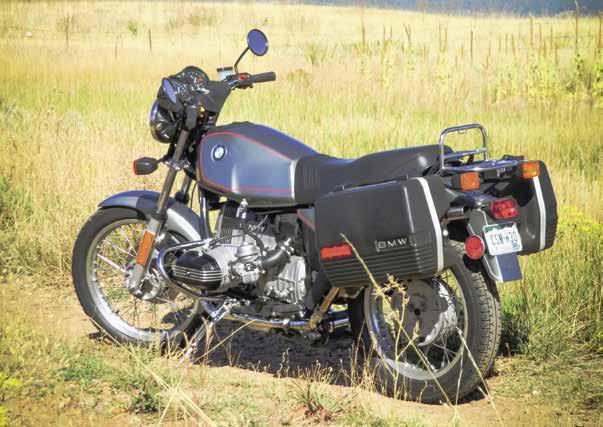
The 1983 BMW R 80 ST. A rare and unique motorcycle in BMW history. One of less than 2,000 units ever sold and the perfect centerpiece for the MOA Foundation’s Completely Vintage fundraiser. This one is special because it was expertly restored and lovingly donated by MOA member Brook Reams to benefit the Motorcycle Relief Project.

Tickets are on sale now through March 10 for $25 each or buy five for $100. A winner will be announced March 16. Scan the QR code for easy ordering or visit mrp.bmwmoaf.org.
Proceeds benefit Motorcycle Relief Project. See details of the bike and the story of the build at bmwmoaf.org


Proceeds from the Completely Vintage raffle benefit the BMW MOA Foundation and Motorcycle Relief Project. See bmwmoaf.org for official rules and details.
WIN R80ST
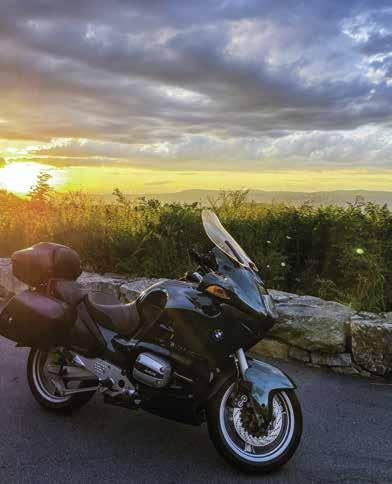
POSTCARDS FROM THE ROAD


Each month we publish the great images sent to us by BMW MOA members from their travels around the globe. Send us your best images and you could have your work published in our Postcards from the Road pages. Email your high resolution images, image description and contact information to editor@bmwmoa.org.
 Above, An early fall sunset along Skyline Drive in the Blue Ridge Mountains of Virginia. Photo by Joe Marsala #233942.
Top right, My '01 R 1150 GS overlooking Shadow Mountain Resort in Estes Park, Colorado. Photo by Joe Lusso #121441.
Middle right, A stop along the road while riding near San Francisco Cahuacua, Oaxaca, in southwestern Mexico. Photo by Gary Loomis #193651.
Bottom right , Maclaren Summit on Alaska's Denali Highway as the first snow of the season sticks to the ground. Photo by Matt Rowe #220161.
Opposite page top left, Camping in Canada's Gros Morne National Park in Newfoundland. Photo by Sammy Turner #233782.
Opposite page top right, A shot from the Valley of the Gods near Mexican Hat in southeastern Utah. Photo by Bruce Booth #198658.
Opposite page lower left, Spoiled by my heated grips during one of my last rides of the season here in Wisconsin. Photo by Riley Armstrong #233520.
Above, An early fall sunset along Skyline Drive in the Blue Ridge Mountains of Virginia. Photo by Joe Marsala #233942.
Top right, My '01 R 1150 GS overlooking Shadow Mountain Resort in Estes Park, Colorado. Photo by Joe Lusso #121441.
Middle right, A stop along the road while riding near San Francisco Cahuacua, Oaxaca, in southwestern Mexico. Photo by Gary Loomis #193651.
Bottom right , Maclaren Summit on Alaska's Denali Highway as the first snow of the season sticks to the ground. Photo by Matt Rowe #220161.
Opposite page top left, Camping in Canada's Gros Morne National Park in Newfoundland. Photo by Sammy Turner #233782.
Opposite page top right, A shot from the Valley of the Gods near Mexican Hat in southeastern Utah. Photo by Bruce Booth #198658.
Opposite page lower left, Spoiled by my heated grips during one of my last rides of the season here in Wisconsin. Photo by Riley Armstrong #233520.

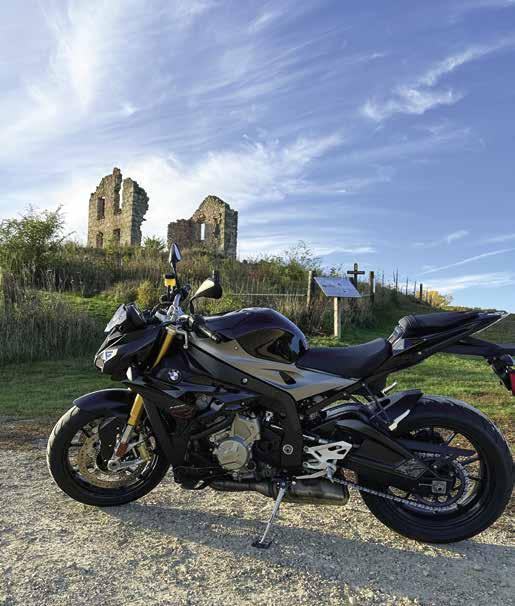

January/February 2024 | BMW OWNERS NEWS 11
RIDER RIDER TO
90 Minutes with Jack
I believe I share a pastime with most BMW MOA members–the continuous search for the ultimate ride journal.
Ted Simon spoiled us all with Jupiter’s Travels. Our shelves and Kindles are stuffed with the stories of “the road.” Many of us have even tried our hand at recording our own bike trips. Personally, I ran out of adjectives almost immediately. The soaring mountains are majestic. The cobalt ocean is angry. The steel gray sky is threatening. You get what I mean.
For me the ride can be quite lonely. Podcasts, audiobooks, music and talk radio only fill so much time, but without them, my inner voice can be a cruel critic, but also an honest and funny narrator. That puckish voice that rattles around inside my helmet, sounds a lot like the writing of Jack Riepe.
Years ago, a friend gifted me with Jack’s book, Motorcycles Speak Louder Than Words. It came in the mail from New Jersey and was inscribed by Jack, “Happy Birthday to my 2nd favorite asshole.” I was hooked instantly. Later, I learned that my friend Michael, after buying the book online, had received a call from Jack to discuss the bawdy inscription. Michael recalls Jack being very appreciative that his book was being shared as a gift and wanted to be sure he got the signature right.
As the years past, I stayed current with Jack’s work and appearances. When he became ill, Michael suggested we send a care package. We sent a note via Facebook Messenger asking for his mailing address and got a response. He was cordial, but scam wary. He asked which of his books was our favorite and which passages spoke to us the most. I quickly fired off a ribald note that questioned his handling of the relationships that he bungled in his book, specifically, Alex, the equestrian, and the “dark secret.” Jack wrote back! He gave us his address and suggested a conference call. We bundled our booty, which eventually included a box of his favorite maduros, a bottle of single malt, a logo coffee mug from our gang, and a Celtic ride bell. At the last minute and on a lark, we included our own writing samples and shipped it all off to New Jersey.
Two weeks later, we shared an evening on the phone with Jack. He loved our gifts, especially the ride bell. He said he was between bikes but would soon have a new K-bike and looked forward to dangling the new bell from the center stand for good fortune and protection from mechanical gremlins.
Ever the multitasker, Jack was making dinner and futzing
about the kitchen during most of our call. We even discussed the flavored rice recipe he was making. Jack told stories of his reporting days and his time in politics. He told us of the details of typesetting his most recent book. He shared a long story that he had removed from his current book about an ex-girlfriend but wanted our feedback. Looking back, I think maybe he had already put it back in the book but wanted two more fanboys to agree.
We’d chatted for over an hour when he brought up our writing samples. He started with mine, which was the story of crashing my GS in the woods of the Upper Peninsula of Michigan during a month-long solo ride. Although Jack was appreciative of our admiration and attention, he found my writing style to be dense and my sentences overly complicated. It stung. But for 30 years, I’ve made my living in construction, and I only ever journal at the campfire during bike trips. Michael’s piece told the story of repurchasing a vintage airhead that he’d sold two years prior. Jack thought it was ready for publishing and suggested he should send it to BMW Owners News. I set aside my bruised ego to be happy for Michael but was dying inside. I’m not sure what I expected. Did I really think he would herald my work as a Pulitzer worthy? That he’d assume I was a plagiarist who found a lost Steinbeck in my attic? Much later, I reread my pages and thought, wow, that’s really dense and complicated. Jack was right.
I’ll miss his columns and Facebook posts. I’ll miss finding videos of him joking and laughing with riding clubs. I’ll miss his dead-on satire of us GS riders. And I’ll miss the excitement of opening the magazine to read his most recent wonderful nonsense. But most of all I’ll miss knowing he’s out there riding and collecting adventures for us.
I’ll forever be grateful that I got to spend 90 minutes with Jack.
Greg Snow #223609 Golden Valley, Minnesota
About the R 80 ST
You are giving away an R 80 ST that was an interesting and underappreciated model back in the day, in my opinion.
It came after the GS version was introduced in 1981
Send your letters and comments to: editor@bmwmoa.org
BMW OWNERS NEWS | January/February 2024 12
and, of course, now we often think of that R 80 GS as the prototype ADV bike. Today the adventure bike genre seems to have divided; there are the “true” ADV bikes, those with a 21” front wheel, long suspension, wire wheels, and tires actually suitable for some off road. Then there are the not quite adventure bikes, usually with a bit shorter seat height and with a 19” front wheel. In fact, those bikes are in reality what is best for many riders that will rarely go off road!
I see the 1982 ST as the original of that genre, and yes, the biggest change back then from the GS was having a 19” front wheel and street tires. Back then, nothing had what we now consider to be the long travel suspension leading to tall seats, so no lowering was necessary.
I will add another fact: back then, the dual-purpose tires the GS wore had a lot less street traction than what has come since! I don’t think there were any great street tires then in the 21” size. I later bought a 1988 R 100 GS and the original tires were still not great. Sixteen years later, I bought a KTM 950 ADV and the Pirelli Scorpions it came with did impress me though for their street cornering ability!
Let’s hear it for modern tire technology!
Stephen Bogert #43279 Selden, New York
A Great Experience in Greer
In September 2023, I attended the BMW U.S. Rider Academy in Greer, South Carolina, for a two-day Adventure Off-Road class. My wife purchased this class for my 60th birthday as it has been on my bucket list for several years since getting back into motorcycling in 2015. I currently ride a 2015 R 1200 GS, which I love and ride off-road most of the time near my home outside Denver, Colorado.
The Adventure Off-Road class didn’t disappoint, but rather exceeded my expectations. From the time I arrived, this was first class–the facility is amazing, the greeting I received was welcoming, and the overall experience was great.
My class consisted of 10 students, four instructors, and
support staff. We started out in the classroom and shortly went to the bikes where riders had a choice of what model they wanted–I opted for the R 1250 GS. The bikes were new and in great shape, and the support staff set up the bikes for you—handlebar adjustment/risers, seat adjustment, or whatever else you needed, including the occasional repair after a drop (which I had several, but all came with some smiles and a few laughs).
The training grounds were the best and we had access to every kind of training imaginable. The instructors were patient, clear in the directions, and worked with us one-on-one. I gained a lot of new skills and gained confidence in the skills I already “thought” I had. They supplied us with water/drinks and power bars in the field along with lunch every day in the training center.
Being a person who enjoys a good meal, I can tell you each lunch was amazing–a full buffet with all the sides. If you attend be careful not to overindulge because the afternoon training will push you, but what a blast.
I have been a MOA member for a few years now and I received a discount on the cost of the class. I applied for and was granted the MOA Foundation’s Paul Bachorz Safety Training Grant, which reimbursed me $250 toward the cost of the class.
This was a great overall experience. If you ever have the opportunity to attend, I recommend you do it, it will not disappoint.
Thanks to the BMW MOA, the Paul Bachorz Grant, and the staff at the BMW U.S. Rider Academy who made this experience one I will never forget. The other students have become friends, and I look forward to riding with them in the future.
Jack Riepe
I was saddened to hear of the passing of Jack Riepe from his daughter’s tribute (December 2023 BMW Owners News.) I have always enjoyed his writings in the MOA and will miss them even more. Just a great sense of humor each month, often on page 62. My only thought would be to retire page 62.
Please reread if you haven’t read it yet “The Empty Table at the Club Breakfast,” July 2023, Page 62. It will make you think.
WE WANT TO HEAR FROM YOU!
Each month, the Rider to Rider pages of BMW Owners News detail the successes, failures, wishes and frustrations we all face as riders, BMW motorcycle owners, customers and individuals. As a BMW MOA member, these are your pages and we want to know what’s on your mind.
Got something to get off your chest? Tell us about it. Know a business that deserves to be recognized? Tell us about it. Got a riding or tech tip that we could all benefit from? Tell us about it. Got a suggestion for BMW Motorrad? You know the drill–Tell us about it! There’s only one rule and that’s to stick to the subject that brings us all here–motorcycling, so save political rants for Facebook! Send your thoughts to editor@bmwmoa.org and lets all work to build a better community.
Mark Spurgeon #218322 Brighton, Colorado
January/February 2024 | BMW OWNERS NEWS 13
Preston Shultz #77102 Woodstock, Connecticut
GETWEISER
CLASS LEADING TRIPLE FUNCTION REAR TURN SIGNALS - FOR BMW MOTORCYCLES
AVAILABLE FOR ALL R, S, G & S SERIES FROM 2004 ONWARDS


2017 R 1200 GS HIGH INTENSITY TRIPLE FUNCTION
2021 2017 R 1200 GS HIGH INTENSITY TRIPLE FUNCTION 2017 R 1200 GS HIGH INTENSITY TRIPLE FUNCTION

SMARTER - BRIGHTER - SAFER!
Weiser’s products are jointly designed & manufactured in the USA and UK
NEW FOR 2024
AVAILABLE SOON - OUR INNOVATIVE MULTI-FUNCTION UPGRADES FOR THE NEW BMW R 1300 GS /A

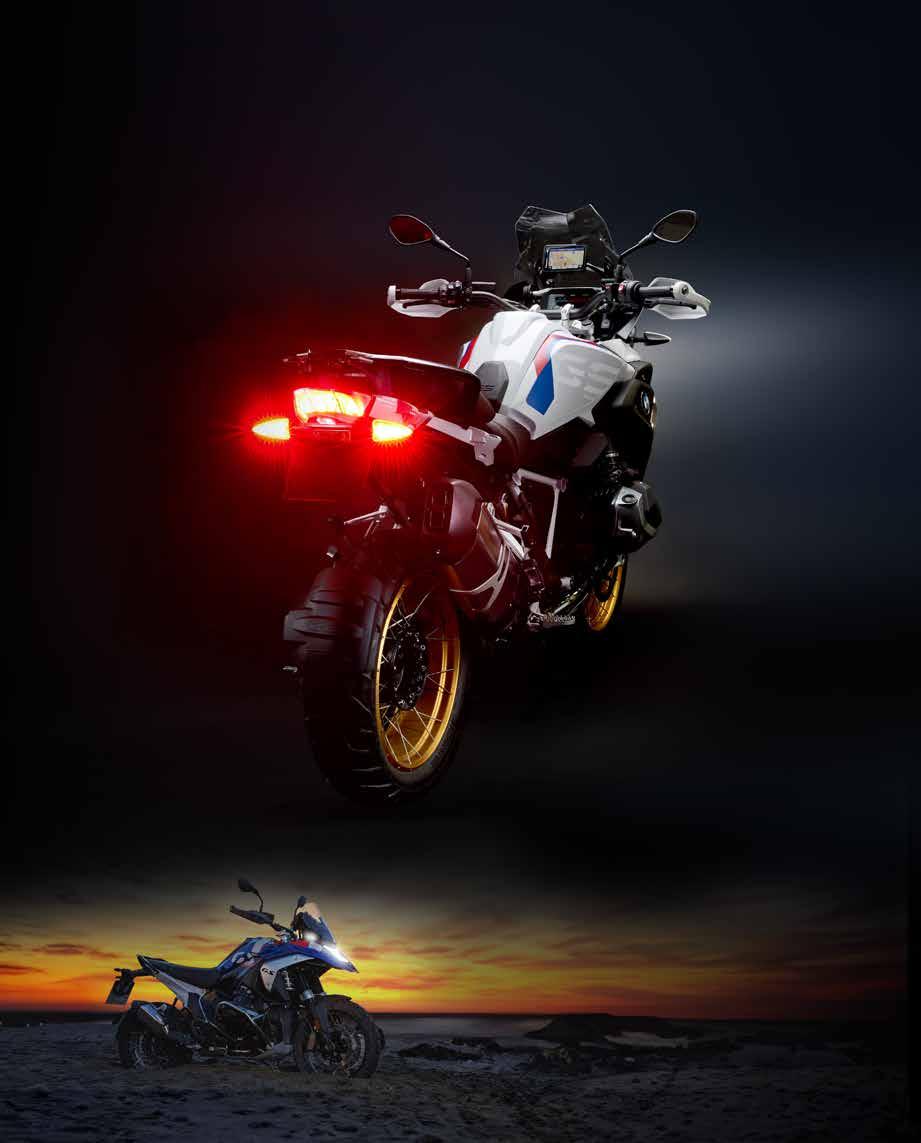
INTELLIGENT MULTI-FUNCTION LED LIGHTS FOR BMW BIKES R NINE T URBAN GS HIGH INTENSITY TRIPLE FUNCTION

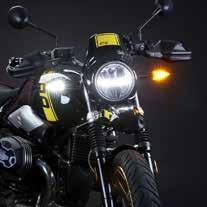


ANIGHT&DAYDIFFERENCE OUR BRIGHTEST & BEST PERFORMING MULTI-FUNCTION TURN SIGNALS EVER! WEISERTECHNIK.COM (831) 713-4365 INFO@WEISERTECHNIQ.COM 2021 R NINE T URBAN GS HIGH INTENSITY DUAL FUNCTION 2023 R 1250 GS HIGH INTENSITY DUAL FUNCTION 2017 R 1200 GS HIGH INTENSITY DUAL FUNCTION IF YOU HAVE A BMW GS MODEL BUILT BETWEEN 1980 - 2024, THEN WE HAVE HIGH INTENSITY MULTI-FUNCTION TURN SIGNALS FOR BOTH FRONT & REAR OF YOUR MOTORCYCLE Key Features: 100% Canbus Compatible (no fault codes) Simple installation OSRAM Automotive LEDs HEX ezCAN & DENALI CANsmart Compatible 4 year manufacturing warranty
Tourstart App Free to MOA Members
Tourstart, a handy route mapping application, is free for MOA members in 2024! The newly launched version of the app contains the unique “RideTwister” algorithm which can create unlimited numbers of twisted tours in “Destination” or “RoundTrip” modes. Users can also use the “FingerDraw” to create routes directly on the map or the traditional way by entering waypoints.
Tourstart is a web and app solution where users can instantly see a tour on both platforms. In addition, users can transfer routes to the BMW Connected app or download a .gpx file to share with fellow riders. Tourstart Transfer software is also available for easy transfer to any other GPS device. No matter how you prefer to create a route, the new app contains an option to meet your needs.
To claim your free access to the web and app, go to tourstart.org/pro and use the voucher code MOA24x. (The voucher code box is in the lower right portion of the screen below the Terms & Conditions box). All tours previously created in the Tourstart app are available in the new version, and the creators of Tourstart are available to help users by email at jap@tourstart.org.
Enjoy the twisted rides!

champu online learning free for moa members
A partnership between the MOA Foundation and Champions Riding School provides MOA members the opportunity to train online to improve their riding skills for free! A special discount on the popular online training course, “Champion Habits: The Core Curriculum,” reduces the standard $99.95 cost for the online learning program to only $39.95 for MOA members. A guaranteed rebate from the MOA Foundation upon completion of the program allows MOA members to gain online learning and improve riding skills at no cost!
Champion Habits: The Core Curriculum is an online, immersive two-wheeled vehicle dynamics course. On the street or on the track, motorcycles simply work best when given the correct inputs – as engineered by the expert riders who designed them. Learn the techniques, mindsets, and approaches of the best riders in the world and ride safer, faster.
Led by Nick Ienatsch and Chris Peris, Champions Riding School has been the premiere motorcycle training program in the United States since 2008. Their approach to instruction in this sport is simply asking “What are the best riders in the world doing to survive and thrive on two wheels?” These lessons are passed on to students, developing
safer riders, faster. The curriculum is constantly evaluated and tweaked as the sport progresses, ensuring that classes teach best practices and not outdated methodology.
New riders will find that the techniques and lessons presented in ChampU will establish a solid, logical, understandable base to carry them safely through their riding careers. For veteran riders, the course confirms and fine-tunes skills, while introducing next steps that become more and more important as speeds rise or conditions worsen.
MOA members can register for the special price of $39.95 on the ChampU website at ridelikeachampion. com. Upon completion of the online curriculum, the MOA member’s information will be automatically forwarded to the MOA Foundation for reimbursement of the $39.95 registration fee. MOA members should allow 6-8 weeks from the completion date to receive their rebate payment. Rebate payment requires successful completion of the course and a current MOA membership!
MOA members can check the status of their rebate payments by emailing info@bmwmoaf.org.
NEWS
INVEST IN U INVEST IN U INVEST IN U INVEST IN U INVEST IN U BMW OWNERS NEWS | January/February 2024 16
UNIVERSITY
education credit for law enforcement at m'fest
Law Enforcement Officers and First Responders are eligible for up to 24 hours of continuing education credit at M’Fest. Training at the annual Authority Bike Shootout is conducted by instructors from the BMW Performance Center and BMW Authority Bike Ambassador, Quinn Redeker. There is no cost to the training or competition for law enforcement officers and first responders!
The BMW Performance Center will also conduct both on-road and off-road training for MOA members and spectators at M’Fest. MOA members can register for their choice of training at mfest.bmwmoa. org. On-site tent camping is included with every training registration and registering for both on-road and off-road training earns a discount on both classes!
M’Fest happens September 12-15, 2024, at the Wilson County Fairgrounds in Lebanon, Tennessee. The event is free for spectators to attend, and over 100 competitors are expected for the Authority Bike Shootout.
Visit the website mfest.bmwmoa.org for details and to reserve your spot!


Win the Completely Vintage ST for MRP

The 1983 BMW R 80 ST. A rare and unique motorcycle in BMW history. One of less than 2,000 units ever sold and the perfect centerpiece for the MOA Foundation’s Completely Vintage fundraiser.
This one is special because it was expertly restored and lovingly donated by MOA member Brook Reams to benefit the Motorcycle Relief Project.
Tickets are on sale now through March 10 for $25 each or buy five for $100. A winner will be announced March 16. Scan the QR code for easy ordering or visit mrp.bmwmoaf.org.
Proceeds benefit Motorcycle Relief Project. See details of the bike and the story of the build at bmwmoaf.org
A Call for rally seminar presenters
The 2024 National Rally team is excited to announce some changes in our seminar line-up by adding more sessions FROM our members, FOR our members.
With that in mind, we are inviting you, our members, to consider doing presentations at the rally this coming June in Redmond. We all have a story to tell about our adventures we’ve had while looking at the landscape through a face shield. If you have Redmond on your calendar, please consider presenting a 50-minute session about a topic that others might find useful.
Ideas could include interesting trips and travels you have undertaken, skills you have learned along the way, repairs and/or new tools that others may not have heard about. Have you traveled two-up? What works and doesn’t work for traveling with two people on one motorcycle? Sidecar enthusiasts: we would love to hear a seminar or two from you. Mapping programs and understanding technology: we hope to hear from members about what works and what doesn’t. And so much more!
If you are unsure, email me at sue@beemerhill.com. Seminar requests can be submitted at rally. bmwmoa.org/seminars/
WIN R80ST
January/February 2024 | BMW OWNERS NEWS 17
help us celebrate our 50 years with IMTBike!
It has been a fantastic first 50 years of the BMW MOA and IMTBIKE has been with us since they opened their doors in 1997. We’re celebrating in style this spring with a jointly developed tour across Spain, led by IMTBIKE founder Scott Moreno from April 14-28, 2024. As a special treat, the MOA’s own Bill Wiegand will join the tour for 14 days in Spain and Portugal!
This motorcycle tour combines IMTBIKE’s “Best All Round” Castles & Mountains Tour with Portugal, a little country with a big heart! Portugal never ceases to impress with its warm welcoming people, fertile lands and seafood rich coast. There are plenty of mountain twisties and sweepers all throughout this motorcycle tour through Central Spain and Portugal. In addition to great riding this tour boasts stunning historical cities like Toledo, Avila, Lisbon, Porto, Óbidos and Cuenca.
All hotels are top-notch with a tremendous variety of exquisite local cuisine. Enjoy freshly grilled sardines and a glass of chilled white port in the harbor of Porto or salted Cod (Bacalao) and a fine Portuguese red in the Barrio Alto in Lisbon; either way you can’t go wrong! Come and explore Portugal & Central Spain, and you’ll see why these regions are the real deal for connoisseurs of great roads and great cuisine.
Highlights include six UNESCO World Heritage Sites in Spain—Segovia, Ávila, Ciudad Rodrigo, Trujillo, Cuenca and Toledo—and two in Portugal— Porto and Lisbon. Exquisite local cuisine! Awesome hotels with first-class historical Pousadas and Paradors plus a few specially selected boutique hotels with local flair. We stay in some of the best Paradors and Pousadas in the Iberic Peninsula. Pousadas and Paradors are castles, palaces and fortresses converted into motorcycle-friendly hotels. Tour starts and ends in vibrant Madrid. All IMTBIKE lodgings are hand-picked for their quality of service, local charm and strategic locations.
Tour prices start at $5,645 Euros, and space is extremely limited. Visit www. imtbike.com/tours for more details and registration.

New Year brings improvements to moa's tire hazard protection program
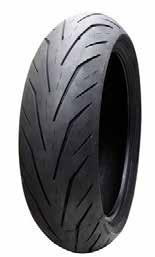
Improvements to the MOA’s Tire Hazard Protection plan are being implemented for 2024. Based on member feedback concerning the program, administration of the reimbursement process for the popular tire protection program will be managed by the MOA membership team. The change is being made to streamline the claims process and provide an improved member experience during the claims process.
Although a popular benefit of the MOA’s Roadside Protection program, member feedback indicates there is room for improvement in the claims process.
Accordingly, the MOA has elected to directly administer the Tire Hazard Protection program rather than outsourcing to a third party. The MOA Board of Directors believe this change will dramatically improve member satisfaction with the reimbursement claim process.
Changes in the administration of the program will not affect the towing benefits or service network currently provided by NationSafe Driver. For roadside towing or assistance, members should contact NationSafe Driver at (866) 454-4260. Members who have the MOA’s Platinum coverage including tire hazard protection will find an online submission form at bmwmoa.org/tire to submit claim.
Beginning January 1, NationSafe Driver will no longer accept tire reimbursement claims and will inform the member they do not have tire hazard coverage through NationSafe Driver. All questions concerning the tire protection plans should be directed to the MOA’s Membership Team at (864) 438-0962.
Along with the change to the administration of the tire reimbursement claim process, the MOA is launching a stand-alone Tire Hazard Protection policy. MOA members can now purchase the Tire Hazard Protection without roadside towing benefits. The Tire Hazard Protection plan allows for two tire replacements per year for damage caused by roadside hazards. Coverage for the Tire Hazard Protection plan is $50 per year for MOA members and $79 per year for the general public.
NEWS
BMW OWNERS NEWS | January/February 2024 18

reserve your spot on the smoky mountain magic tour
Join MOA members Vance and Mari Harrelson and Bob and Sue Aldridge this May 20-24 for four nights and three days of pure riding pleasure in the Smoky Mountains. On this tour, not only will you ride the iconic roads of the Smokies, you will also have a chance to discover the beautiful side roads off the beaten path in the heart of the mountains.
This all-inclusive tour includes lodging, meals, and even your gas during the tour. All you need to do is check in on the first night, and we’ll take it from there. Your lodging destination for the tour will be the beautiful Fontana Village Resort. The tour itinerary includes three 150-mile day trips retuning each night to the resort. Among the highlights you will ride many of the iconic roads in the Smoky Mountains, including the Cherohala Skyway, Tail of the Dragon, Wayah Road, and Moonshiner 28.
The total cost of the tour is only $2,195 per rider and $595 per passenger. This cost includes your room at the Fontana Village Lodge, breakfast and dinner at the lodge and lunch during the ride each day. In addition, we’ll also gas your bike up during the tour! Tour participants will use their own motorcycles and be responsible for transportation to the Fontana Village and their return trip at the conclusion of the tour.
If you have always wanted to ride in the mountains but don’t want to worry about “keeping up” this is the tour for you! Visit bmwmoa.org/events to reserve your spot.
experience bmw moa premier training
The best investment you can make in your riding experience is improving your skills!
Consider this your invitation to experience the Premier Training Program, an all-inclusive collaboration between the BMW MOA Foundation, the BMW MOA, and the BMW Performance Center US Rider Academy in Greer, South Carolina.
Limited to only 14 participants, this full day of rider training will encompass both on and off-road skill development using BMW Performance Center facilities, motorcycles, and instructors. If you want to improve your on-road skills and get a solid introduction to off-road riding, this training is for you.
This unique opportunity includes two nights of lodging at the Greenville Marriot Hotel with a “meet and greet” and introductory session at the Performance Center on day one. Day two features a full day of both on- and off-road training with breakfast, lunch, and an evening dinner. Transportation between the hotel and the Performance Center facility, a special Premier event polo shirt, and the use of a Performance Center BMW motorcycle are also provided. The cost for the training event is only $1,595 and these classes are sure to fill up fast. Register today at bmwmoaf.org!
“Each new day is a new adventure on the Smoky Mountain Magic Tour. Staying at the same location each night allows you to relax and breathe in the mountain air. From the beautiful winding roads to the stops along the way, seeing those amazing mountains is such a gift. Our common bond is our love for riding BMW motorcycles. This common thread leads to great stories told during our wonderful meals each day. Come to the Smoky Mountains. Unwind, ride, recharge. It will make you say, let’s do it all again.”
 – Linda and Darrin Webb #225705
– Linda and Darrin Webb #225705
“The motivation to ride a motorcycle is multi-faceted. One such motivation consists of a mix of the machinery, comradery, food and the pure enjoyment of becoming part of a beautiful environment. The Smoky Mountain Magic Tour is the perfect blend of these elements. While the tour is not for the beginning rider, the pace set by the skilled leaders is such that the riders can feel challenged whether riding solo or two-up. The curves, the mountains, the rivers and communities touched during the tour will provide the rider with a deep appreciation of this part of the county and will establish a passion for coming back again and again.”
– Frank and Caroyln Sqrow # 223855

2024 Premier Training April 4-5 April 24- 25 May 16-17 September 26-27 October 24-25 November 14-15 January/February 2024 | BMW OWNERS NEWS 19
Don Cameron Receives BMW MOA Exemplary Service Award
By Karl Zuercher #230886
Don Cameron has aways loved motorcycles and people. His 60 years of riding, personal passion and enthusiasm helped him become successful as a BMW dealer for about 20 years.
As an energetic dealer—something becoming rarer these days—Don built a solid business in the middle of the desert just off Interstate 10 in Deming, New Mexico. His shop had a reputation as the go-to place to get work done, guaranteed to be complaint free,

and Don was ready with a friendly chat and offer whatever help might be needed.
In his youth, Don was an Eagle Scout with an interest in camping and motorcycles in the early 1960s. While still in the Army and stationed in Utah, Don had the opportunity to help others and became a scout leader himself. It was later, teaching chemistry and math to high school students, that he first invested in the motorcycle business. He would go to the shop in the afternoons after school and on Saturdays. The business grew, and soon he had to relinquish his teaching job and go full-time at the cycle center. When his business partner retired, Don bought his shares.
Don’s reputation for customer appreciation was evident with his annual Veterans Day weekend ride, his own mini rally he hosted with food, refreshments and camping at his home on the north side of Deming. He told me riders would come in from all over the country, “at least 17 different states,” just to show up and be part of it.
Don provided his customers with the best experience he could, and he was a member and big supporter of the Land of Enchantment BMW Riders club. He became legendary at the club’s Bavarian Mountain Weekend rally for his Friday night barbecues where he would bring in mountains of food and all the tools for a feast to kick off the annual event. Don and his wife, Mary Lou, were pillars of the club, always pitching in to help however they could in support of the club, including special trips to Texas to get his favorite BBQ sauce!
When Don retired, things changed, and he developed dementia. The BMW MOA graciously decided to give Don their Exemplary Service Award for his contributions to the BMW community and motorcycling in general. On the designated Saturday morning for the presentation, I swung a leg over my high-speed mileage disposal unit RT for the trip to Deming with the award in a side pannier. When I arrived, Mary Lou had everything ready. After some overdue reunion time with the group, Don received his award. It was obvious he was enjoying himself, and he held tightly to his well-deserved award.
NEWS BMW OWNERS NEWS | January/February 2024 20
They say that behind every good man, there is a good woman, and Mary Lou has always been Don’s advocate in his motorcycle adventures and remains by his side. She had organized the luncheon at the facility where Don resides. Mary Lou said it means a lot for the two of them when someone stops by to visit him in the facility he lives in.
Mary said, “One of the kindest gestures of the year was when two motorcycle friends rode to Deming to visit him in his current home away from home.”



If you get the opportunity, stop by for a visit. “Just call first,” Mary Lou says!
We thank Don and Mary Lou for the friendship and goodwill that so many riders have had the opportunity to enjoy over the years.
The BMW MOA highest honor, the MOA Exemplary Service Award, honors members who, year after year, recruit new members, work on committees, and help BMW MOA grow in any way possible. They include those who never refuse when asked, take responsibility for significant projects, and those who take the initiative to address issues whether anyone asks them or not.
A standing committee of the Board of Directors screens nominations for this award, then presents their recommendations to the full Board of Directors for consideration. Recipients are announced annually at the National Rally Awards ceremony.
If you know an MOA member you believe is worthy of this award, email MOA Executive Director Ted Moyer at ted@bmwmoa.org







Join the BMW MOA FACEBOOK page today! Get the MOA Newsfeed via Twitter for more BMW and motorcycle news – www.twitter.com/bmwmoa January/February 2024 | BMW OWNERS NEWS 21 BE SAFE. BE SEEN. | ADMORELIGHTING.COM/BMWON DESIGNED FOR BMW MOTORCYCLES Also available at select BMW dealerships across the country IT’S A NEW YEAR, MAKE SURE IT’S A SAFE YEAR! IT’S A NEW YEAR, MAKE SURE IT’S A SAFE YEAR! 2024 Apr. 21 - Apr. 29 CASTLES & MOUNTAINS CENTRAL SPAIN tours@IMTBIKE.com www.IMTBIKE.com
If you’ve attended an annual BMW MOA National Rally, you’ve likely seen Norm Phoenix. More specifically, if you’ve attended any of the past 50 MOA National Rallies, you’ve likely seen Norm! Not only is Norm an MOA Pioneer, one of the MOA members who attended each of the first 10 National Rallies, he is the only Pioneer who has not only attended all MOA National Rallies but has ridden to all of them.
club and the BMW MOA as much now as he did when it all began back in the ‘70s.
Few other members of the BMW Motorcycle Owners of America have exhibited a higher level of dedication and support to our membership and the BMW marque than Norm Phoenix.
Norm Phoenix Recognized
as a 'Friend of the Marque'
Over the years, Norm has owned four BMWs: a 1970 R 75/5, a 1976 R 90 S, a 1987 K 100 RS, and his current ride, a 2001 K 1200 RS. All were purchased new. He’s also got an R nineT on the way! Through the years, Norm has ridden in 45 states, parts of Canada, six countries in Europe, and New Zealand.
Norm joined the Chicago Region BMW Owners Association in late 1970 and the BMW MOA in 1972; to this day, he remains active with both. In the Chicago club, Norm has served as president, secretary, treasurer and director. Since leaving that board, he has been an active member of Chitech, the club’s technical committee, serving four years as its chairman and many more as assistant chairman.
“I can’t be active in an organization without giving something back in time and effort,” Norm said.
During the 1970s, Norm co-authored a series of articles for BMW Owners News titled “BMW Electrics.” He has presented technical seminars at National Rallies on tune-up procedures and troubleshooting the Airhead charging system. Norm has also volunteered at many National Rallies, assisting with Registration or Tally and Awards. Most recently, Norm has been the Committee Chair for Pioneer Events.
During the 36 years Norm worked as an electrical engineer, he moved around to five different companies in the Chicago area. As a result, he spent most of those years with just two weeks of vacation. BMW MOA National Rallies provided the theme and destination for many of those vacations. Norm said he relishes his involvement with both his Chicago
BMW has many fans and friends, and some of them are quite extraordinary. Their personal commitment goes far beyond the call of duty. For this reason, BMW acknowledges their commitment as passionate ambassadors of the BMW brand by awarding them the title of “Friend of the Marque.” The only requirement is that the person should be a member of a recognized BMW club, such as the BMW Motorcycle Owners of America.
One of the highest honors in the BMW community, only a small number of BMW MOA members have ever received this award. The title is so prestigious that there are fewer Friends of the Marque than there are former U.S. presidents.
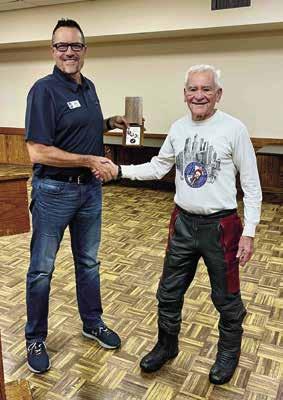
NEWS
BMW OWNERS NEWS | January/February 2024 22
Chad Garcia (left) of the BMW Board of Directors presents Norm Phoenix with his Friend of the Marque.

January/February 2024 | BMW OWNERS NEWS 23
BMW Motorrad announces the R 12 nineT and R 12 Classic Roadster and Cruiser
With the introduction of the original R nineT in 2013, BMW Motorrad presented more than just a classic-style roadster. From the beginning, it combined classic motorcycle design and modern technology with craftsmanship and comprehensive customization options. It led to a whole family of Roadsters for the BMW Motorrad Heritage line.
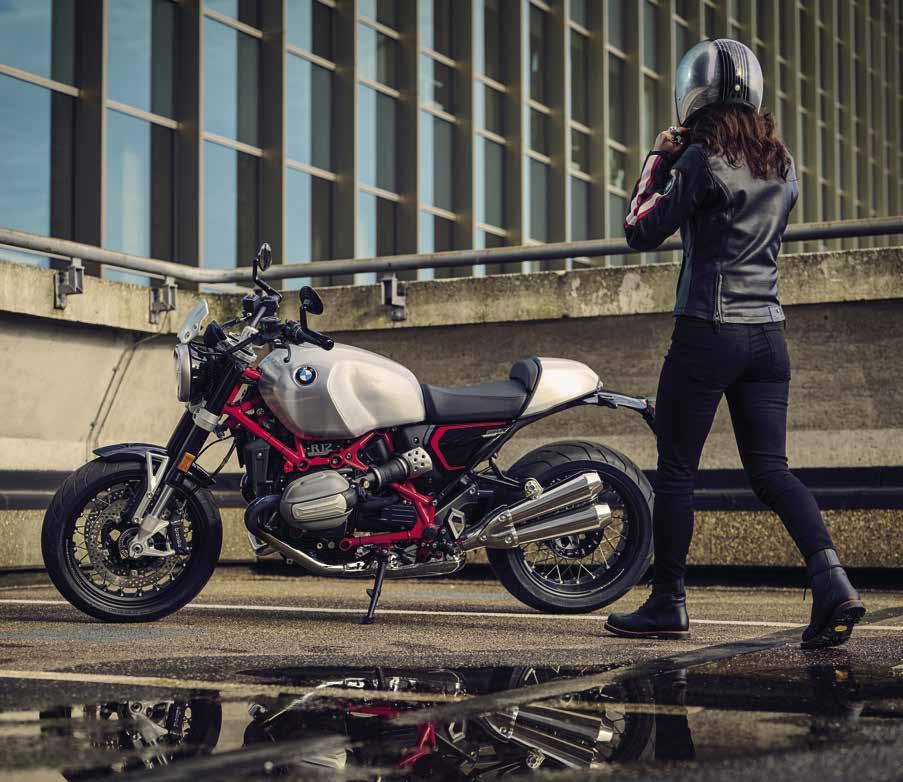
NEWS
BMW OWNERS NEWS | January/February 2024 24
The guiding principle for the development of the new R 12 nineT was “The Spirit of nineT,” with the goal of following in the footsteps of the successful R nineT and carrying forward its look, timelessness, and high customization qualities. While the new R 12 nineT aims to make a stylish impression in urban environments as well as provide dynamic riding fun on winding roads, the new BMW R 12 comes under the motto “The Spirit of Easy”–perfectly embodying a classic cruiser for cool and relaxed riding.
The new BMW R 12 nineT and R 12 are classic cruisers and roadsters that combine the torquey character of the boxer engine and the design language of traditional motorcycle eras with innovative technology and a modular concept that offers the rider maximum customization options. Reduction to the essentials and attention to detail were key priorities in the development of the design, resulting in a strong emotional appeal.
Customizing is more popular than ever. The trend started by the R nineT when it was launched in 2013, has given rise to an incredibly creative scene over the years. BMW Motorrad has catered to this demand with a whole model family centered around the R nineT, giving birth to the BMW Motorrad Heritage family. Ever since, the desire for customizing and personalization has been burning in countless motorcycle riders’ hearts. So, the question was not whether there will be a successor to the R nineT model family, but how it can fulfil the desires and needs of customers even more captivatingly and authentically.
Accordingly, the new R 12 and R 12 nineT are built on a common, versatile chassis with a now one-piece trellis frame, an airbox positioned flat under the seat and an angled rear shock. This allows for different, interchangeable tank shapes, providing greater visual individuality. It also offers freedom in designing the seats and fly lines.
On the BMW R 12 nineT, the aluminum tank with brushed and clear-coated side panels, the seat, and the tail-hump create a rising, dynamic line. Edgar Heinrich, Head of Design BMW Motorrad: “The purist design language is dominated by the clear tank/seat/rear line, in the style of the traditional /5 or the legendary R 90 S of the 70s. At first glance, the tank itself is a classic BMW boxer tank, with a typical bend in the lower edge and classic knee contact. The new R 12 nineT also features side covers in the area of the frame triangle for an authentic Roadster look - another reminiscence of BMW +motorcycles of the 1970s.” The focus on essential design is supported by the compact and short tail section. The shorter fuel tank, which is 1.2-inches shorter and narrower in the rear, ensures significantly improved ergonomics and a more front-oriented seating position compared to its predecessor. The R 12 nineT features a 31.3-inch seat height while the R 12 offers a lower, 29.7-inch seat height.
On the new BMW R 12, the steel tank, reminiscent of the so-called “Toaster Tanks” of the 1970s BMW /5 models, emphasizes the design language of a cruiser in a classic teardrop shape and forms a descending line in combination with the standard solo seat and the curved, low-mounted rear fender. The large 19-inch front wheel and the smaller 16-inch rear wheel complement this look. The classic cruiser design is also reflected in the more relaxed seating position with lower seat height and wider handlebars.
For complete information on the updated R 12 nineT and R 12, please visit your favorite BMW Motorrad dealer.

January/February 2024 | BMW OWNERS NEWS 25
The 2023 Grand Coddiwomple: A Grand Success
By Bill Stranahan #217669
For 2023, the MOA Grand Coddiwomple ran from April 1st to October 31st (April Fools’ Day to Halloween). A total of 389 riders registered for the event with 150 completing the contest. The score to complete the Grand Coddiwomple was 300 points or six scored submissions.
This year, nine challenges tempted Grand Coddiwomple riders. A surprise awaited the riders as they were expected to “Count to Fifty” using Interstate, State and County highway signs instead of the expected “Spell the Rally Slogan” using the Places challenge. By far, the Count to Fifty Challenge had the most participation once everyone figured out what definition of “count” to use.
Other challenges included The “Loneliest 50 Challenge” with a list of 50 points from Maryland to California on historic US 50, The loneliest highway in America; “The Ten-Fifths Challenge,” which inspired riders to visit every distillery in the U.S. and Canada (Responsibly, of course); “The Goose that Laid the Golden Egg,” which gave riders excuses to visit every place that was named or contained the word “Gold;” “The Ridgeline Challenge,” which gave riders a reason to come visit the Rally in Virginia and ride the Blue Ridge Parkway and Skyline Drive with a list of 25 points; “The Capitals Past and Present Challenge” for riders to visit current and former State, Territory and Country Capitals and Capitol Buildings; “The Spider, He is Our Hero Challenge” which involved research to find where are the Spider Sculptures are in the U.S. and Canada; and “The Third Time’s the Charm Challenge” which
allowed riders to celebrate the third iteration of The Grand Coddiwomple!
Three riders managed to get to all 25 of the Ridge Line sites, which was a challenge in of itself as several sections of the Blue Ridge Parkway were closed sporadically this year. Their reward was 1,250 bonus points. Six riders rode US 50 from Maryland to California to get to all 50 sites and snag the bonus of 2,500 points.
The Grand Coddiwomple staff provided the answers to questions that were emailed to Grand Coddiwomple Central. These questions ranged from “What do you mean by count?” to “What do I need to submit for a number road to be accepted for the Count to Fifty?” We also provided tech support when there were problems with the portal login or questions about a submission’s status or why a submission was rejected.
A random prize drawing will be held on January 21, 2024 (Squirrel Appreciation Day). Stay tuned to the BMW MOA Facebook page for the announcement. Thank you to our staff of BMW MOA volunteers without whom this fun event would not be possible.
The 2024 Grand Coddiwomple will begin on April 1, 2024 (April’s Fool Day), with registration opening on February 2, 2024 (Groundhog’s Day). Watch the Coddiwomple Page on the BMW MOA website as the start date draws closer to get a head start on what the fourth Annual Grand Coddiwomple Challenges and Rules will be!
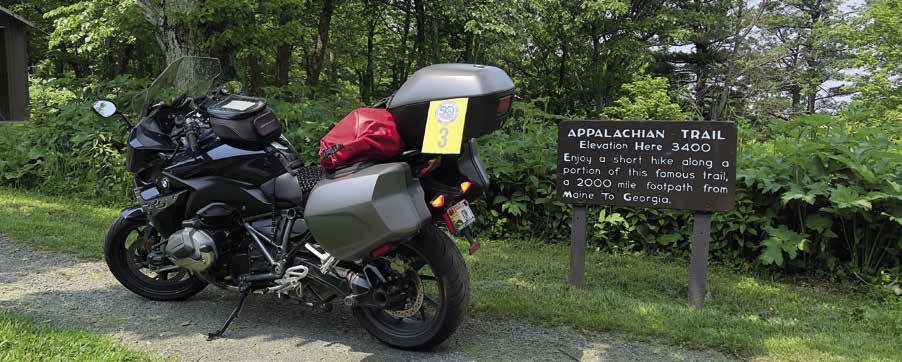
NEWS BMW OWNERS NEWS | January/February 2024 26




CODDI WHAT?
By Ed Pedi #29818
What is a Coddiwomple? Coddiwomple means to travel in a purposeful manner toward a vague destination. It sounded good to me!
I first heard about the MOA Coddiwomple Challenge a few years ago. At that time, I wasn’t motivated to participate due to my work schedule and other plans. This year, I read the challenge and thought it sounded like fun!
The challenge was promoted as “all the places you will go and the fun things you will do that you would not have done otherwise.”
Last April, I purchased a new 2023 R 1250 RT and thought “The Count to Fifty Challenge” (count to 50, using interstate, federal, state and county highway signs) was a great opportunity to put some miles on the new bike. On my way to the MOA National Rally in Doswell, Virginia, last summer, Route 30 was my first route.
When leaving the rally, I asked my wife, “How about going home to Massachusetts via Florida?”
She agreed, because of that, I was able to ride and capture Route 10 in Florida, Route 20 in South Carolina, Route 40 in North Carolina, Route 50 in Virginia and since I had already tallied Route 30 in Virginia, I opted to ride Route 30 in Massachusetts and finally, Route 1 in New Hampshire.
I had such a good time getting the first six routes I decided to continue with the challenge. So, I got out my maps and planned additional rides to capture eight additional routes, all within a couple hundred miles from my home. I did most of these rides on Sunday mornings to avoid weekday commuter traffic, and on one particular Sunday, I put on 500 miles riding to Bangor, Maine, to capture Routes 15, 46 and 11.
To take photos, when my wife rode with me, we’d get off the bike and I’d hold the flag as she took the photo. It was a little like a racetrack pit stop since stopping on the shoulder of some of these busy highways was kind of a hairy situation. When I rode alone, I used a clamp to clip the flag to the back of my top case. Sometimes, I’d get back on the bike and forget about the flag until I’d see it flapping in my mirror.
After checking off my route numbers list, there was one particular route remaining, Route 29, that I was having difficulty locating. Luckily, my good friend David Good invited me to the Four Winds Rally in Pennsylvania where lo and behold I found Route 29. Attending the rally and capturing the last remaining Route I needed was good in itself, but the bonus was meeting a lot of nice people while having a great time at the rally.
Overall, the 2023 Grand Coddiwomple was a fun challenge and a great way to put miles on my new bike, and I want to thank the MOA and the Coddiwhomple Team who put these fun challenges together each year for its members.
See you in Redmond in 2024.
January/February 2024 | BMW OWNERS NEWS 27
2024 ChampSchool Schedule
Yamaha Champions Riding School, the premier riding school in North America, is proud to announce our 2024 schedule featuring events in Florida, Nevada, Arizona, California, Colorado, Illinois, New Jersey, North Carolina, South Carolina, Texas, Washington and more.
This is a partial schedule release with several more dates and locations to be added in the next few weeks. In all, the 2024 ChampSchool schedule will consist of more than 30 two-day events featuring our 2-Day ChampSchool, 1-Day ChampStreet, ChampGrad, and Racer Only curriculums. Significant “early bird” discounts are available for all schools up to 60 days before the events as most schools sell out months in advance. Every inperson school comes
with our online curriculum, Champ U Core Curriculum.
“Our 2024 schedule builds on a record-breaking ‘23,” YCRS Founder Nick Ienatsch explains. “We sold out nearly every 2023 school, most with a long waitlist, and we are excited about keeping the momentum going in 2024. We will be holding more schools in 2024 at more locations to train more riders on any bike, with any skill level, or riding goal. We offer a true “arrive and ride” experience with a fleet of Yamaha motorcycles, world-class Dainese gear, and Arai helmets. Riders are welcome to bring their own bikes as well. All brands or types are welcome.”
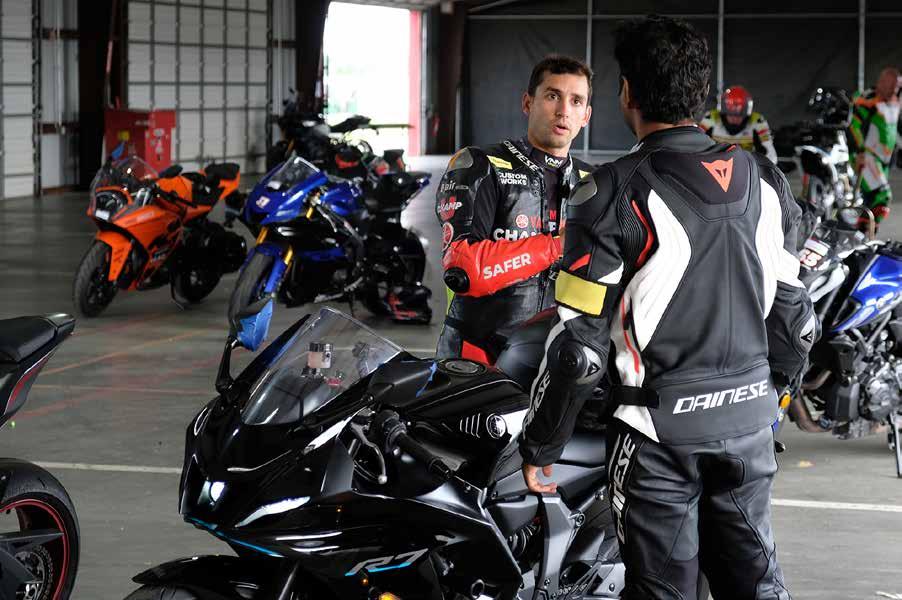
NEWS
2024 Yamaha Champions Riding School (Partial):
January 18-19 Homestead Motor Speedway, FL
February 3-4 Las Vegas Motor Speedway, NV
February 27-28 Inde Motorsports Ranch, Willcox, AZ
March 4-5 Buttonwillow Raceway Park, CA
March 26-27 Inde Motorsports Ranch, Wilcox, AZ (Racers Only)
April 1-3 Streets of Willow, Rosamond, CA (ChampGrad and Street)
April 9-10 Motorsports Ranch Cresson, Cresson, TX
April 15-16 Carolina Motorsports Park, Kershaw, SC
April 25-26 NCBike, Garysburg, NC
April 29-30 NCBike, Garysburg, NC (ChampGrad)
May 1-2 NCBike, Garysburg, NC (Racers Only)
May 7-8 Inde Motorsports Ranch, Wilcox, AZ
May 14-15 New Jersey Motorsports Park, Millville, NJ
May 25-26 High Plains Raceway, Deer Trail, CO
June 10-11 Thunderhill Raceway Park, Willow, CA
June 18-19 New Jersey Motorsports Park, Millville, NJ
July 31-August 1 The Ridge, Shelton, WA
August 5-6 Autobahn Country Club, Joliet IL
September 10-11 New Jersey Motorsports Park, Millville, NJ
September 18-19 Motorsports Ranch Cresson, Cresson, TX
September 24-25 Carolina Motorsports Park, Kershaw, SC
October 3-4 Buttonwillow Raceway Park, Buttonwillow, CA
October 8-9 Inde Motorsports Ranch, Wilcox, AZ
October 17-18 NCBike, Garysburg, NC
October 21-22 NCBike, Garysburg, NC (ChampGrad)
November 2-3 Streets of Willow, Rosamond, CA
November 12-23 Inde Motorsports Ranch, Wilcox, AZ (ChampGrad)
December 6-8 Las Vegas Motor Speedway, Las Vegas, NV
Learn more about the 2024 schedule, specific event details, and all of the Yamaha Champions Riding School curriculums by emailing info@champschool.com.

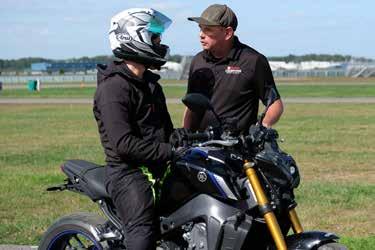

January/February 2024 | BMW OWNERS NEWS 29
Helmet Head: The helmet and jacket readystorage solution for any space
By Wes Fleming #87301
I’ve tried pretty much every helmet and jacket storage plan you can imagine, from coat racks in the corner to piles on the floor. While each has its pros, the cons usually outweigh the benefits, especially for helmets. I like to keep two helmets in active use, rotating them daily, especially during the summer.
Until now, I’ve split storage duty between Alaska Leather’s Helmet Hitch and a run-of-the-mill coat rack. While the Helmet Hitch is cheap and easy to install, it’s made of plastic and looks great in the garage or shed…but not so much in the entryway of my house.
MOA member Brian Hinton (#135269) had an idea last year for a new way to store motorcycle gear that would be sturdy, functional and even a little elegant— the Helmet Head. It’s even patent pending! He sent me a prototype for feedback, and I refused to return it to him, because yeah, it’s that great of an idea, backed up by excellent execution.
The Helmet Head mounts directly to a wall, and because it’s made of 3/16” carbon steel and a bit hefty, you’ll want to mount it to a stud (which gives you an excuse to go buy a tool, as stud finders work pretty well these days). The mounting bolts look big, but they’re unobtrusive once installed properly. Installation was a breeze, though I took my time and used a level to make sure I got the unit installed perfectly vertical. I made sure to drill guide holes so the stud didn’t splinter, something I consider important when working with wood.
The graceful curve of the helmet holder makes it easy to mount any helmet—simply put your helmet on the holder like you would put it on your head, with a slight front-to-back rocking motion and then slide it gently into place. Leaving the face shield open promotes air circulation, and I found the interior of my sweaty helmet dry the next day without exception, something that didn’t always happen with the Helmet Hitch, as that unit puts the entire neck ring of your helmet flat against the wall and cuts down on airflow (and incidentally, can over time leave black smudges on the wall).
The hooks hanging from the horizontal bar of the Helmet Head allow hanging jackets, pants or gloves— rider’s choice—and you won’t worry about anything happening to even your heaviest leather jacket, as the steel hooks are securely fitted to the bar. Even though I’d like the hooks to be ever so slightly larger, I can easily hang my riding jacket on one side and my insulating layers on the other side. Slightly larger hooks would make things a little speedier for me, but this is a personal preference, not a slam on Brian’s design. Larger hooks would probably look weird in context given the smooth design of the unit.
With its laser-cut preciseness, hand-bent curve and powder-coated durability, the Helmet Head will look good no matter where it’s mounted—house, garage, shed, workshop, wherever. That, plus its made-in-theUSA bulletproof construction, make it a great purchase for any rider. With a secure mount into the studs, you’ll get years of easy, elegant service from your Helmet Head—both now and when the patent comes through.
Find out more about Helmet Head at helmethead. net. Pricing is $109 for just the helmet storage, $119 for helmet storage with jacket hooks. For a limited time, use the discount code BMWMOA when you check out online for a 10% discount.

Wes Fleming tried being a rock star for 25 years, but gave all that up to focus on motorcycles. His mother still hasn’t forgiven him. The first new motorcycle he ever bought got run over by a car – with him still in the saddle. He discovered BMWs thanks to a friend in 2001 and has been riding trendy, not-so-trendy and sidecarequipped BMWs ever since. Wes currently holds down multiple jobs, including freelance guitar consultant and history professor; when he's not pacing around his empty nest, he's out looking for a great deal on a used motorcycle.
NEWS
BMW OWNERS NEWS | January/February 2024 30


January/February 2024 | BMW OWNERS NEWS 31
Heated
Riding safely in the winter can—and probably should—include some method of adding heat to your body. While there are many products available for just about any part of your body, here we’re focusing on 12-volt heated jacket liners, which are meant to be worn between your base layer and outer motorcycle jacket.
Perhaps they’re wired directly to the battery, but these systems can also be wired to an auxiliary fuse panel or through your CANbus via an interrupt like the CANSmart, EzCAN, CANopener, etc. Most of the liners here require a controller, purchased separately, for best use.
California Heat 12V Jacket Liner california-heat.com
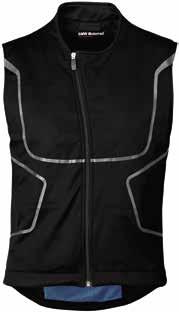

Not just wind resistant, but water repellant as well! In addition, this lightweight and compressible (i.e., packable) liner is sized to fit snug over your base layer to best transfer warmth from the heating elements in the chest, back, collar and sleeves. Power output is 77W and power draw is 6.4 amps for a max temperature of 135oF.
MSRP: $230
BMW 12V HeatUp Vest
order at any BMW motorcycle dealer
BMW’s heated vest is light and sporty, featuring a high collar and five heating elements positioned to warm your chest, back and kidney areas. A separate three-stage controller provides a max output of 35 watts and connects to a BMW’s on-board power socket. Unisex; sizes from XS to XXXL.
MSRP: $249
Firstgear Gen 4 Heated Jacket Liner
tuckerpowersports.com
With its massive 106-watt output with 7.7 amps of draw, Firstgear’s Gen4 adds a windproof outer layer to keep a rider that much warmer. The liner is moisture wicking to prevent sweat buildup and stretch panels keep the liner snug against you while you ride. Seven heat panels keep you toasty, and a one-year warranty gives you some peace of mind. Sizes in both men’s and women’s cuts run from XS to 2XL, with Talls for men in L-2XL.
MSRP: $249.95



GEAR
BMW OWNERS NEWS | January/February 2024 32
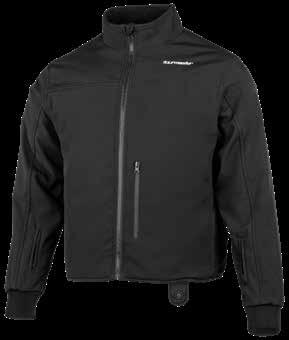
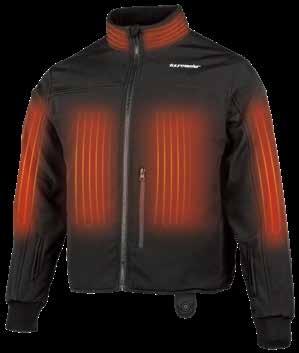
Tourmaster Synergy BT Pro-Plus 12V Heated Jacket (also vest)
helmethouse.com
Lycra stretch panels and a microfleece collar add to the premium look and feel of the Synergy BT Pro-Plus, and seven flexible carbon-fiber heating elements join with Bluetooth connectivity to keep you warm on the road. Uses a built-in high-medium-low controller that maxes out at 126oF, but has the lowest power consumption here with 42W output and a draw of just 3.5 amps. Can also be powered with a 12V lithium battery available from Tourmaster and perhaps more importantly, is machine washable and clothes dryer safe. Sizes from XS to 3XL.
MSRP: Jacket $249.99, Vest $199.99
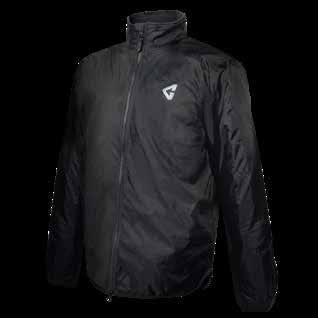




Gerbing 12V Heated Jacket Liner
gerbing.com
Available in Men’s (XS to 4XL) and Women’s (XS to XL) cuts, including some tall sizes. Has heating elements covering the chest, back, neck and both arms. Nylon shell is rip-resistant and arms sport low-profile cuffs for better fit under a motorcycle jacket. Max heat is 135oF at 77W output; power draw is 6.4 amps. Their “2.0” version costs $30 more and includes a hood, but little additional information is available on their website.
MSRP: Vest $199.99, Jacket Liner $249.99
January/February 2024 | BMW OWNERS NEWS 33
Tackform’s Adventure Motorcycle Mount
By Mark Novack #208387
Tackform’s recently introduced Adventure Series Motorcycle phone mount features an all-new design aimed at the adventure motorcycle rider. In addition, the mount can also be used on any motorcycle where a rider is looking for a strong all-in-one solution for mounting a phone used for GPS and

communications (using a Bluetooth communications for safety of course).
This new mount is all metal in a black matte finish with a high-quality look and design, along with the solid feel of a well-engineered and manufactured product. The mount features three points of semipermanent adjustment to customize the mount to the width and depth of your phone. The phone is held in place by a spring-loaded slider and can also be locked into position using a metal thumbscrew. The
width and depth adjustments have hex bolts to secure sliders into position, as you would only need to change these if you switched phone models or cases.
The Tackform mount also features a wireless Qi charger built into the mount to charge newer phones while held in place. An additional adjustment slider allows users to position the phone correctly over the wireless charging loop as this is critical to allow the phone to charge properly. The charging coil and the phone’s receiving coil must be lined up to get the full charging capability. The wireless charging puck has an on-off switch in case you prefer to charge the phone with a cable. For this, the bottom mount feet are spaced with enough of a gap so this is possible. When the wireless charging is active, the charge coil glows a green color to alert you the wireless charging is active.
The mount has an SAE terminal and includes adapter cables to allow users to provide power directly from the battery or from a USB connector. I personally have several SAE connectors wired directly to my battery via a PDM (Power Distribution Module) to allow for easy use of heated gear, battery tenders, and other powered accessories. I would think you could also power the mount from a battery pack using a USB connector in a tank bag if you preferred not to create a direct connection on your bike.
This Tackform mount also utilizes a built-in four-point vibration dampening system to isolate the phone from vibration transmitted from the engine and road surfaces. Modern phone camera stabilizers have experienced problems when used on vehicles with higher frequency vibrations, and this dampening system is designed to protect a phone from this.
The mount has user-replaceable rubber grips for the mount arms should they wear out from use, which likely add some vibration isolation from the metal mount. The mount is designed for one-handed operation. To use the mount, push the phone into the top spring-loaded clamp and allow the mount to
GEAR
BMW OWNERS NEWS | January/February 2024 34

January/February 2024 | BMW OWNERS NEWS 35
clamp down on the phone with its five points of contact to keep the phone in place while riding. You can then use the thumb screw to lock the springloaded part into place to ensure a solid and secure mount.
The Adventure Phone Cradle uses the 20mm mounting system from Tackform, which is part of a system of mounts for phones, GPS, cameras, tablets and more. The components in this system can be mixed and matched to mount devices onto a variety of locations on vehicles and more. The system has interchangeable parts that can be configured to place the device in the proper position for use and user.
In addition to the phone mount described in this review, users also need to get a vehicle base mount and a mount arm. For my BWM, Tackform makes a bolt that allows the mount to be attached directly to the handlebars, but there are a multitude of these mounts for various locations on motorcycles and other vehicles. Attached to the base vehicle mount is an arm of various lengths and joints that allow for a custom position of the phone.
I personally prefer Tackform mounts and their 20mm ball system over other mount options available. It is similar to the RAM system, but Tackform uses a 20mm metal ball that is smaller than that on the RAM. These metal ball mounts do not deform over time and allow for smaller components. Tackform does make one inch conversion parts that allow users to use their existing RAM mount parts with Tackform mount parts. Other phone mounts require using their branded case with your phone for the mount to work. With Tackform you can use just
about any case you prefer. Also, a number of other mounts are plastic which are more likely to break or wear out over time. I personally use Tackform mounts as a mounting solution for my phone, GPS, camera and more. I use the traditional Tackform phone mount in my car for my phone.
Tackform is a company based in the Chicago suburbs. They design all their own mounts here in the USA and outsource the manufacturing to precision CNC manufacturing companies overseas. They are consistently updating designs and innovating new designs based upon experience, testing, and customer feedback.
I have personally met Nick, Tackform’s owner, at their offices, and he is always interested in user feedback and suggestions for products. All the products I have seen from Tackform have a quality feel, look, and design. No cheap plastic or poorly designed parts.
The mount sells for $99.99 alone or $129.99 as a full motorcycle mount kit. For more information, visit tackform.com.

Mark began his two-wheel journey riding and racing bicycles. He currently rides a 2010 R 1200 RT for commuting, long-distance touring, and Iron Butt rides. Mark is the Consumer Interest Officer for the Chicago Region BMW Owners where he frequently plans routes and leads club rides for the CRBMW club. As “tech geek” he is known to have all types of electronics, gadgets, and gear. Mark manages a local auto repair shop and does professional photography part time.
GEAR
BMW OWNERS NEWS | January/February 2024 36














January/February 2024 | BMW OWNERS NEWS 37 TAILGATE ON OR OFF TRUCK LOADED & CLOSES W/O BIKE. $2995 - $3995 AVAILABLE FOR JEEP OREGON HIDDEN BACKROADS Epic 5 day/4 night paved tour from the MOA National Rally in Redmond to Oregon’s Chief Joseph Rally in John Day! Tours • Rentals • ADV Training • Parts pacmototours.com OVERSEAS SPEEDOMETER & INSTRUMENT REPAIR R & K Bikes 512-329-8200 www.speedometer.com
By Mark Barnes #222400
Although most motorcyclists can expect to contend with a punctured tire at some point, most of the time this doesn’t have to mean interrupting your trip or needing a trailer to haul your bike away. These small, inexpensive tools allow for relatively quick and easy roadside or trailside repairs. You may need pliers to remove the penetrating debris and you’ll still have to restore lost psi, but your tire will again be airtight. Catastrophe averted!
Tools like these are very cheap insurance against being stranded. Nobody will guarantee the resulting fix as permanent or durable under extreme conditions, but it’ll likely enable safe passage to somewhere a more substantive repair can be made. In Part Two, we’ll survey some ways to handle re-inflation after a puncture has been plugged, since both are necessary to get rolling again.
Visit bmwownersnews.com for expanded information on these items.
Lezyne Puncture Repair Kit ride.lezyne.com
This tiny device from the bicycling world can be carried in your pocket unnoticed, yet still plugs a typical tire puncture. At 1.3 oz and 2.3” long, it leaves no excuse for being unprepared, even if you’re traveling with zero luggage. Shown configured for action; tool fits into body for storage.


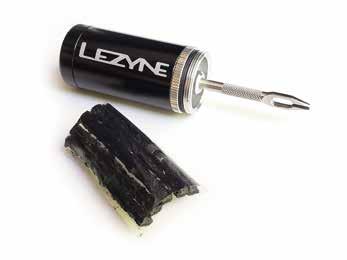

CXWXC Tire Repair Kit cxwxc.com
Also borrowed from our bicycling cousins is this very compact option (5”, 3 oz). It offers more leverage than the Lezyne, but still fits in a jacket pocket. Add CO2 cartridges and it not only plugs your puncture, but also provides for re-inflation. Shown disassembled.
MSRP $29
GEAR
BMW OWNERS NEWS | January/February 2024 38
Rocky Creek Designs Puncture Repair Tool
rockycreekdesigns.com
Built like a big Swiss Army Knife (11oz, 4.5”), this array of fold-out tools includes everything you need to plug a flat, except the plugs. Those are readily available separately, or as part of a combo pack that includes even more at little extra cost (see Part Two).
MSRP $49.34


Stop&Go Pocket Tire Plugger
stopngo.com
This elaborate kit—its carrying pouch measures 8” x 3” x 1.5” and 16.4oz—is not really pocket-sized, but easily packed in luggage. It contains not only the necessities for plugging a puncture, but also a means of (partial) re-inflation (explained in Part Two).
MSRP $60
January/February 2024 | BMW OWNERS NEWS 39
clearwater's darla lights
By Mark Barnes #222400
One of the many excellent reasons to attend an MOA rally is the discount shopping offered by on-site vendors. In addition to seeing goods in person (as opposed to ordering them based on pictures or spec sheets), you can discuss your needs and product tech details with company staff instead of a potentially uninformed salesperson at your local shop, and in many cases you can have purchases professionally installed on the spot by experienced techs who perform these same services all the time. I did exactly this at the 50th in 2023 with a set of Clearwater’s Darla lights for my R 1250 RS.
I hadn’t planned on making such a purchase. I’d already augmented my daytime conspicuity and added a few lumens to my night rides with Evolution LED turn signal inserts from Cyclops (see review in 9/22 issue of ON, or 5/12/22 post on bmwownersnews.com). These glow bright white when not flashing yellow and they’re inexpensive. I understood they weren’t nearly as powerful as standalone auxiliary lighting, but they’re a good value, and I very rarely ride at night anymore. I’d found my bike’s stock headlights adequate, if not outstanding, when I ended up coming home late, but I hadn’t taken into consideration I was always on familiar roads with at least a few streetlights overhead. When I rode back to my hotel from the rally after dark, I had to contend with completely unfamiliar backroads lacking any overhead illumination—a very different experience! It was scary, like riding through ink. I was immediately intent on improving my ability to see during subsequent nighttime trips at the rally and anytime I might get caught in a similar situation in the future.
A riding buddy with the same bike who already had Darlas on his machine told me he’d never wanted more illumination. These lights happen to mount very simply to our bikes’ lower fork tubes using brackets that bolt on where our front fenders attach (other mounts are available, too). With this recommendation and no intention of doing much nighttime riding, I chose this model at the least powerful end of Clearwater’s regular 12-volt lineup (the even-smaller Glendinas are for six-volt systems). I thought it prudent to spend no more than necessary on something I’d only use occasionally, and even the Darlas are not cheap!
Clearwater Lights is a family-run operation with a reputation for making expensive kit, with the cost justified by superlative build quality, durability, and performance. Their products are made in the U.S., with
industry-leading Cree LEDs and related components, rugged CNC-machined or forged-from-billet housings, hard-anodized and/or powder-coated surface treatments, and 6061 aluminum brackets with stainless steel hardware. Their wiring is silver-plated, fine-strand copper with hi-temp Teflon insulation, incorporating Posi-Product connectors, adhesive-coated shrink-wrap, and heavyduty polyethylene sheaths with silicone lubricant for vibration resistance. Products carry a two-year warranty, with personalized service and support on a case-by-case basis afterward.
Each Darla is 2.2” wide and 2” deep, weighs seven ounces, sports three high-powered LEDs configured for a driving beam projection, and consumes 24 watts at full power with a maximum output of 2,400 lumens. They’re engineered and marketed as primarily fog/conspicuity lights, not hard-core driving lights designed to hurl a bazillion photons into the next county. Nevertheless, they deliver a broad swath of increased nighttime illumination beyond what my stock headlight provides at close and moderate range, and they make distant reflective surfaces (road signs, animal retinas) visible much sooner, even if they don’t bathe the far away landscape in brilliant light. If I did more nighttime traveling, I’d spend the extra coin for more powerful auxiliary lighting, but I’m content with my Darlas. They boost nighttime illumination enough to relieve the fright I felt on that first night of the rally, and they increase my daytime conspicuity dramatically—a benefit I value every time I ride.
“Selective Yellow” slip-on lenses make these lights really pop visually during the day or bad weather by filtering all wavelengths but the one to which our eyes are most sensitive. They grab so much attention partly because of the color itself and partly because of this hue’s extraordinary contrast against typical backgrounds compared to white light, even the glare of reflected sunlight. Nighttime illumination is maximized by simply pulling these covers off, no tools required. Each cover comes with a clear lens, too, if desired to ease cleaning or add a layer of impact protection. The triangular arrangement of any pair of auxiliary lights with a motorcycle’s headlight not only stands out in traffic, but also helps motorists judge distance and movement more accurately; an approaching triangle changes dimension more noticeably than an approaching dot.
Since Clearwater staff installed my lights for me at the rally, I can’t provide first-hand commentary on the
GEAR
BMW OWNERS NEWS | January/February 2024 40
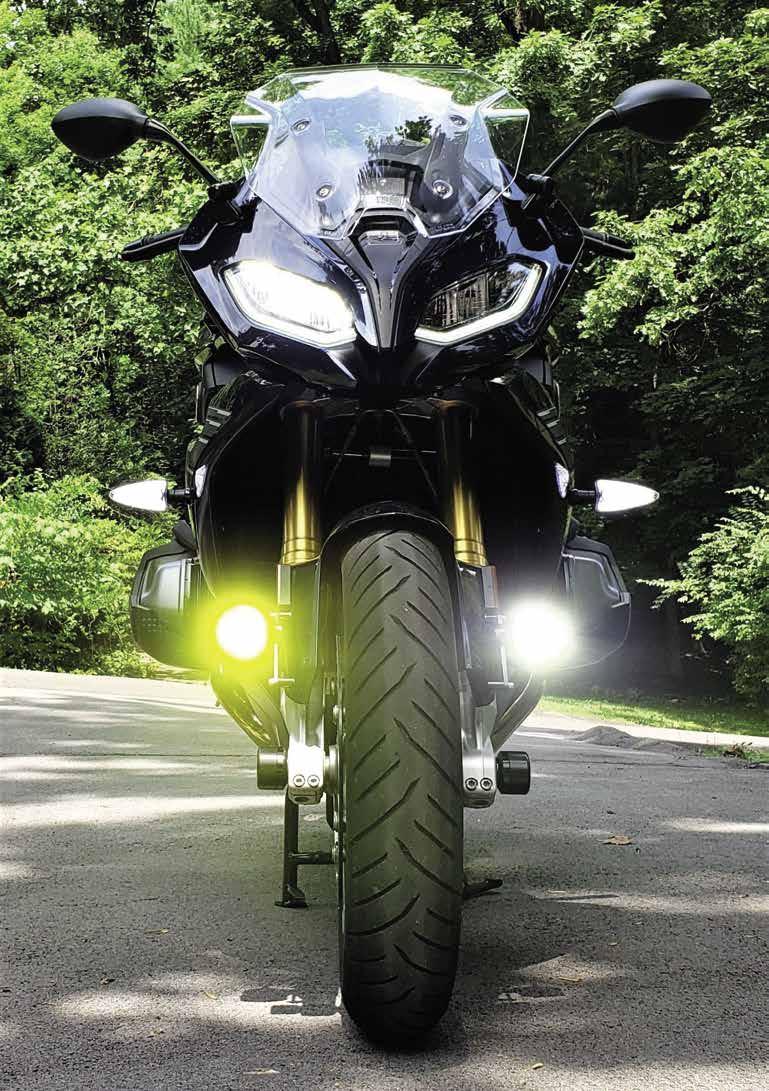 Low Beams - yellow vs white.
Low Beams - yellow vs white.
process, but the installation instructions for any light/bike combination are available on Clearwater’s website. Judging by the information for the Darlas on my motorcycle, the process is straightforward and should be well within the capabilities of the average home mechanic. Note that any model light is available in multiple kits that include wiring, switchgear, and bracketry appropriate for specific applications. For example, BMWs with a wonderwheel can use it to adjust the Darlas’ brightness, whereas those without this controller get a handlebar-mounted dial to serve the same function.
Also noteworthy in the Clearwater Lights package for motorcycles equipped with CANbus electrics is the inclusion of their CANopener module, which taps into the CANbus through an existing accessory plug without setting off fault codes or interfering with the signals traveling through such systems (integrated power/ground leads go directly from CANopener to battery). The CANopener reads information from controls like the horn and headlight dimmer switch, and from sensors like the day/night ambient light detector you may not even realize your bike has, then changes the behavior of the lights accordingly (more on this later). It can also coordinate additional electronics, like Clearwater’s flashing “Billie Brake Lights.”
In my review of the Cyclops lighting, I discussed
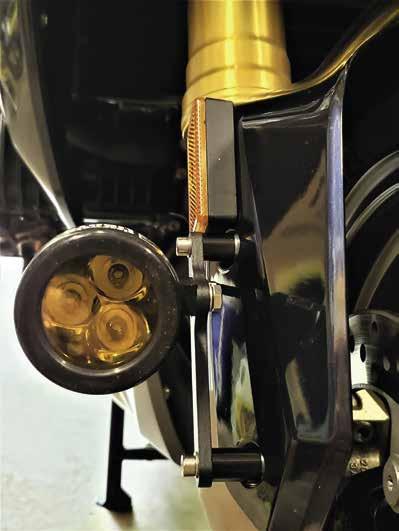
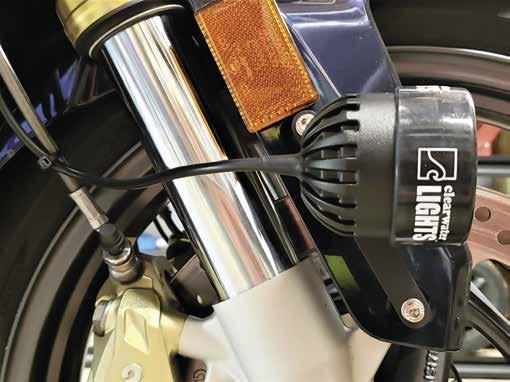
using Hex’s Gen-2 ezCAN (reviewed separately in the 1/23 issue of ON, or the 7/17/22 post on bmwownersnews.com) which also accesses the CANbus system and can be programmed to control multiple auxiliary electronics. While there is some overlap in their functions, the ezCAN and CANopener are significantly different devices. Keep in mind LED lights are digital, not analog. Similar to the difference between a fuel injector and a carburetor, LEDs are modulated by turning them on and off very quickly (hundreds of times a second), rather than by adjusting the flow of electrons on a gradient. Such “pulse width modulation” is managed for the Cyclops LEDs by the ezCAN. You can dial their brightness up or down with the wonderwheel (or by connecting the ezCAN to a laptop and using its programming software), and the
Side view.
From the front showing the fender mount bracket.
BMW OWNERS NEWS | January/February 2024 42
ezCAN will transmit power to the LEDs with shorter or longer gaps/pulses, causing the lights to appear brighter or dimmer. Clearwater builds pulse width modulators into each light unit, so the CANopener doesn’t perform this duty.
You might think this would create problems if you want to use both an ezCAN and a CANopener on the same bike, but it can be done; that’s how it is on my bike. The CANopener simply connects inline with one of the ezCAN’s output channels, allowing everything from the ezCAN to pass through to the related componentry. This arrangement does make adjusting the lights separately a little tricky, since they both use the Wonder Wheel. What if I want the Cyclops lights at full brightness during the day when my low beams are on, but I only want the Darlas at 30% brightness in that same scenario? The Cyclops lights come on whenever the ignition is active, even without the motor running, whereas the Darlas don’t come on until the motor does. I can set the Darlas with the motor running, then turn the bike off and back on without restarting the motor. Now the Darlas are “asleep,” and I can set the Cyclops lights independently. Both sets of lights will then hold their respective settings going forward.
My combination of motorcycle, Darlas, and CANopener allows many adjustments using several existent controls, including the Wonder Wheel, turn signal switch, and front brake lever. Manipulating these in various sequences not only changes auxiliary light brightness, but whether or not they strobe when the horn is blowing or go to full power when hi-beams are flashed prior to overtaking. They can also be set to dim when turn signals are activated, or to flash with hazards. As alluded to earlier, settings can be made separately for daytime and nighttime operation (using the bike’s built-in photocell to distinguish these), and separately for use with low-beams and hi-beams. If Clearwater’s Billie Brake Lights are installed, their behavior can be modified via similar means.
I settled on the following configuration for my Darlas: 100% while running high beams, when I need maximum illumination and I’m not concerned about blinding oncoming traffic; 30% while running low-beams at night, as this provides plenty of additional conspicuity without obnoxious glare; 70% while running low-beams in daylight, which delivers un-ignorable conspicuity, but stops short of being an infuriating distraction. Before the Darlas, I would keep my high beams on all the time to boost my conspicuity. Now I’m much more visible during the day with only my low beams and the Darlas, and I reserve my high beams for empty roads at night.
The fender-mount kit for my bike carries an MSRP of $669. If purchased at the same time, the Selective Yellow slip-on lenses cost another $30 ($40 if bought separately). With Clearwater’s rally discount, I got all this hardware for $594. I don’t know what I’d have paid my local shop to install the system, but I’m sure it would’ve been a lot more than the

$100 Clearwater charged me at the rally. While the installation is not technically complicated, it can be time-consuming (1-3 hours). With all the plastic R&R required on my bike, the project would definitely require more than an hour of labor, currently $125+ in my area. See Clearwater’s website for bundle discounts and simplified wiring when purchasing more than one setup at a time. For instance, Darlas can be added to other Clearwater lights that already have branches in their wiring for the Darlas, eliminating the need for/cost of wiring normally included with them.
Even with my rally savings, $694 is a lot to spend on something for which I hadn’t felt any need during two years of owning this motorcycle. While I may not have much occasion to appreciate the Darlas’ additional nighttime illumination, I feel better knowing it’s there if I need it unexpectedly. I never want to repeat that half-blind ride on the rally’s first night! More importantly, I’m confident my conspicuity during the day is worlds better. It’s virtually inconceivable to me that a motorist could overlook me from the front now, even on the brightest days when my other lights don’t stand out much.
CANopener installation.
January/February 2024 | BMW OWNERS NEWS 43
Schuberth C5 Helmet
By Wes Fleming #87301
It’s easy to pigeonhole everybody wearing a Schuberth C5 flip-front helmet as a long-distance safety nerd, just like it’s easy to pigeonhole a GS rider as an off-road wannabe. Doing either, however, sells short the actual item in question. The C5 is a helmet well suited for any style of riding, over any amount of time and across any distance.
Schuberth has long had a stellar reputation for producing stunningly protective helmets at the front edge of technology, helmets that incorporate the biggest asks riders have while enjoying the utmost in fit and finish right out of the box. This review is not going to challenge any of those assumptions, simply because, with the C5, Schuberth is maintaining its reputation in those arenas and elsewhere.
It all starts with a carbon fiber-reinforced fiberglass shell, which Schuberth has updated yet again for improved shock absorption and lighter weight. Inside the shell is a new formulation of extruded polystyrene (EPS) with a roomier head cavity and two densities of foam to afford better protection all around. A new seamless liner provides more long-term comfort and can be swapped out along with cheek pads to customize the fit of the helmet.
Functionally speaking, I honestly can’t tell if the C5 is much lighter than other helmets, like my Arai full-face or Touratech ADV-style. They all feel roughly the same, but balance differently because of their style and construction. This is probably because I always skew towards the largest end of a helmet’s size offerings, up where everything is four-plus pounds. What I can tell you, though, is that while riding, the C5 feels more aerodynamic, and I experience less drag and wind whip with the C5 than with my other helmets. As a result, it feels lighter in operation, even if it doesn’t when I’m carrying it.
just 85 dB at 60 mph on a naked bike, which OSHA says is the maximum safe level for workplace noise exposure for an eight-hour workday. Of course, that’s without using the comm system to listen to your heavy metal music.
This is my first Schuberth flip-front. To be honest, I’m not a fan of this style of helmet despite how easy they are to put on if you wear eyeglasses like I do. My problem is a little odd—the latching mechanisms of most flippers catch my long beard hairs in them and rip those fellas right out of my face, which I’m sure you can understand hurts, especially when it happens over and over during the course of a day. The main reason I agreed to review the C5 is because Schuberth completely redesigned the latching mechanism, eliminating the external posts and moving all the works inside the shell. The latching is positive and solid, and has yet to tear beard hair from my apparently delicate face.

Another downside of flippers from my perspective is the location of the neck strap—and yes, I call it a neck strap instead of a chin strap because that’s where they all seem to hit us, right across the adam’s apple. Redesigning the latching mechanism allowed Schuberth to relocate the strap forward far enough to get it off your throat a bit, though it still isn’t as far forward as the chin. That, combined with a sturdy ratchet buckle (which has a soft flap you can position between the metal and your skin), creates a highly secure and more comfortable neck-helmet interface.
Schuberth says the C5 is their first helmet officially homologated to allow travel with the chin bar in the up position, largely because they’ve included a new locking system to keep it there. I won’t be riding like this, but it’s nice to know the ECE-R 22.06 safety standards say I can.
The C5 is definitely much quieter than my other helmets; I attribute that to the snug neck roll, especially when the chin curtain is in place. This is one place where flip-front helmets have an advantage over full-face helmets—since you put on a flipper with a different motion than a full-face, they can fit much more closely to your neck, which effectively blocks wind noise. Schuberth claims a sound level inside the C5 of
All C5s come standard with a clear outer shield, a Pinlock insert the rider can affix to that shield, and an inner light smoke shield easily deployed by a slider on the left side of the helmet. On the brightest and most humid sun-soaked days of summer, I found the interior of the helmet heating up to an uncomfortable degree despite the excellent ventilation. I bought an outer “dark” smoke face shield—I put “dark” in quotes because compared to shields from other companies, it
GEAR
BMW OWNERS NEWS | January/February 2024 44
A redesigned chin strap and ratchet buckle.

January/February 2024 | BMW OWNERS NEWS 45
is not dark—and that did the trick for me, reducing the amount of sun that reached my skin enough to allow the ventilation to do its work. The smoke face shield—also prepped for Pinlock—is light enough for riding early in the morning or late in the afternoon, but I wouldn’t recommend using it at night.
The SC2 comm system, which is manufactured by Sena and uses their technology, is proprietary to Schuberth’s helmets. The C5 comes from the factory with the speakers already installed, as well as the antennae needed for radio reception and inter-bike communications. When you get your SC2 box, all you have to do is pop the two small units into their cavities in the helmet, one at the back of the helmet and the other on the left side, just above the internal visor slider. Schuberth has already paired the two pieces together, so all you have to do is turn them on and pair your phone, GPS unit or other Bluetooth device. Plug in the boom mic and you’re ready to chat away with your riding buddies or take phone calls while in the saddle (although I don’t know why you’d want to do that!).
When I first started using the SC2, I couldn’t get it to power off, which meant the main unit’s rechargeable battery had to run out before it would go off. A firmware update quickly resolved this issue, and now I have no problem power cycling the unit—and doing the update was no more complicated than connecting the unit to my computer and activating a downloaded package from Schuberth. The “remote”—that is, the part of the system on the side of the helmet— uses a flat battery similar to the one in your car or motorcycle key fob and has to be periodically replaced. You can’t really power cycle the remote; once the main unit is on, you have to press buttons on the remote to get it to wake up. It will shut itself off after some period of idleness—I’m not exactly sure how long, as it hasn’t happened to me while riding.
Sound quality from the speakers is nice, and at low speeds music sounds good. At high speeds, music sounds OK, but the important thing is you can still hear the directions coming from your GPS unit and your riding buddy shouting at you to watch out for that pothole. The few times I’ve taken or made a phone call, it’s always been at a standstill, so I can’t attest to the sound quality of a phone conversation at speed.
My only real complaint about the C5 relates to the detents for holding the face shield open. It locks closed positively, yet not so tightly that it’s difficult to open. The first detent is meant to provide just enough air flow to de-fog the face shield (if a Pinlock is not installed or has failed) and provide a more ventilation for the face than the chin vent provides. Most of the air from the chin vent hits your mouth; opening the face shield to the first detent blows air on the rest of your face. However, with the face shield in this position, it vibrates enough to create a good bit of noise and to also blur your otherwise perfect visibility through the optically clear face shield. When using detents above the first, I find the wind pressure forces the face shield closed at speeds above about 40 mph. This might be a safety feature, but I would prefer more positive detents that can resist the wind and stay open at any speed. I don’t understand why you can ride with the chin bar up, but not the face shield.
While Schuberth has definitely improved ventilation since they built my S2, I found the C5 a bit warm on the hottest days of summer. Even with all the vents open and riding a naked bike, I always felt a little too warm when temps edged north of 90°. Having said that, I couldn’t ask for a better riding experience in cooler months, and with all the


vents closed on a 40°F day my head was all-day comfortable. I mention this mostly as information, because I found the S2 unbearable to wear above 90° and the C5 is a vast improvement over that. Perhaps I’m just spoiled at this point!
The C5 is available in six solid colors and three graphic schemes, each with 10 different color palettes. Sizes range across two shells from XS (53 cm head circumference) to XXXL (65 cm). An XS weighs approximately 3.7 pounds, while a typical XL comes in at about 4.1 pounds. A similarsized Shoei Neotec 2 is slightly heavier, approximately 0.1 to 0.2 pounds more.
Prices for the C5 start at $769 for most solid colors and run to $869 for graphic-adorned versions. Adding the SC2 comm system will set you back $349, and an SV6 “dark” smoke face shield will run you about $90. While the SC2 is universal across all sizes of the C5 and E2, there are two face shield sizes, one for each shell size, so be sure to tell your dealer your helmet size when buying a face shield. A replacement Pinlock insert will cost $40, and plenty of spare parts are available for your C5 as well through your authorized Schuberth dealer.
BMW OWNERS NEWS | January/February 2024 46
The SC2 comm system comes in two parts and installs directly into cavities in the helmet shell. The remote (top) runs on a standard fob battery, while the main unit (bottom) is recharged like a cell phone.
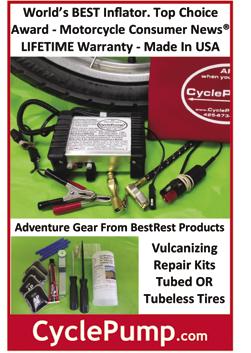





Business Sale: includes buildings, inventory
Available Items: Additionally, we have a range
factory BMW tools, equipment, BMW
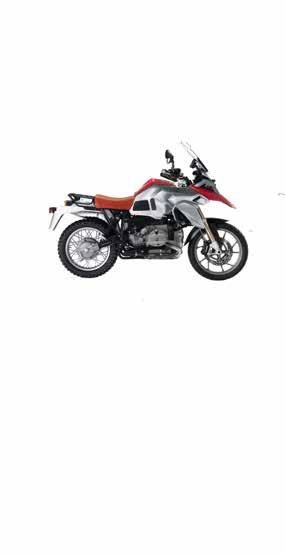
items, and display materials available. Display
Storage
both to be offered as Wholesale lots by type. For further details and
please contact Mark Sidle at Mark@re-psycle.com. Terms and conditions subject to change, reach out to Mark for latest updates.
Join the BMW MOA FACEBOOK page today! Get the MOA Newsfeed via Twitter for more BMW and motorcycle news – www.twitter.com/bmwmoa January/February 2024 | BMW OWNERS NEWS 47 FOR BMW MOTORCYCLES 1970 ON FOR BMW MOTORCYCLES 1970 ON WWW.MOTOBINS.CO.UK 01775 680881 INDEPENDENT SUPPLIER SPARE PARTS & ACCESSORIES SPARE PARTS & ACCESSORIES FOR BMW MOTORCYCLES 1955 ONWARDS 0044 1775 680881 FOR BMW MOTORCYCLES 1955 ONWARDS SPECIALISTS SINCE 1985 Re-Psycle BMW Parts Closure &Business Sale / Liquidation
and property, if we
entire business, we will consider
of 1955 to 2010 BMW motorcycles and parts to a
do not receive a suitable offer for the
liquidating our extensive inventory
wholesale buyer.
fixtures,
materials, manuals,
www.re-psycle.com DEALER Lots ONLY
50+ classic bikes 1970 – 1995
A few later years
Running bikes
Project bikes
Parts bikes • Extensive new and used parts inventory 1955 – on • Extensive factory BMW tools • shop tools • equipment SALE
of shop
printed
promotional
and
shelving
inquiries,
•
•
•
•
•

BMW OWNERS NEWS | January/February 2024 48
BY REECE MULLINS #143779
I honestly did not know what to expect on my first site visit with 2024 MOA National Rally chair Sam Garst as my Delta Airlines flight lumbered westward, but I remained open to all the possibilities the romantic West had to offer. Of course, I’ve ventured out west from time to time as most MOA members have, attending some great recent western rallies held in Salt Lake City, Utah, and Great Falls, Montana. For our new members who may not know, the club rotates its national rally each year, basically forming three distinct rally zones: western, central, and eastern. As our 50th rally was in the eastern zone in Doswell, Virginia, our 51st rally will be in the western zone, and for those who watched the announcement on the MOA Forums and Facebook page earlier this year, we all found out that the Deschutes County Fairgrounds in Redmond, Orego, won the bid for the 2024 rally site.
On short final into Seattle my plane emerged from the low clouds triumphantly, kissing the runway with a jolt that made the non-aviators in the cabin area grab their arm rests. The overcast skies of Seattle came as no surprise to this Google-educated scholar, but that would not be the case for take-off three hours later on my way to Redmond. As my short connecting flight gunned the engines on climb out from Seattle, I had a rare window seat opportunity to take in the city on take-off. I was immediately impressed with the beauty of the water and the city, but as the aircraft banked right towards Redmond something caught my eye that took my breath away, Mount Rainier in all her glory and majesty. Mountains like these are not something one sees often in Alabama; I can assure you. This was my first taste of the vistas I would soon find myself falling in love with in the next few days.
The arrival at Redmond airport afforded a much smoother landing. Pilots have a saying, "Take-offs are optional, landings are mandatory,"–it is the landing from which you will be judged by fellow pilots. Anytime I’m riding commercial I always try to afford the pilot on
disembarkation a salutatory wink and nod for a silky, butterysmooth touch down. For some reason they always look at me like I’m crazy; I haven’t quite perfected the “you rocked that landing” body language yet, short of a high-five, which would be totally awkward.
I collected my one bag, easily identifiable by all its BMW branding, and met Sam Garst and Bob Aldridge for our ride to the hotel, a mere two miles down the road, passing the gate of the rally site en route. For those vendors and members who choose to fly in and hotel, the layout could not be more accommodating. The airport, along with multiple clean, new, and well-priced hotels and restaurants are all within a five-mile radius of the rally site. As we drove to the hotel, we immediately started to catch up as old friends tend to do after not seeing each other in quite some time. As we talked, I looked out the windows of the rental and immediately began the immersion experience. I was conducting a thorough reconnaissance, paying attention to every detail, taking as many mental notes as humanly possible. In doing so, my eyes kept gravitating on the beauty of the Three Sisters mountain range west of Redmond. The sun was setting, and the snowcapped peaks were shimmering copper-gold. Redmond was already growing on me, and I had only been on site for less than thirty minutes.
They say first impressions are lasting impressions, so let me take a moment to share mine, if I may be so bold. My general impression of the rally site, and the town of Redmond was that the area was well laid out and well maintained. Everywhere we went, from the rally grounds to out and about in town, was clean. I got the distinct impression that the townfolk of Redmond were proud of their town, and it showed everywhere we went. Every restaurant we went to, the clientele was well mannered, well dressed, and happy to be there. The hotel and restaurant staff were always polite, patient, kind, and accommodating. The cuisine was excellent everywhere we went. The local specialty seemed to be a very fresh and tasty California-style Mexican fusion, which, for a Mexicano aficionado like myself, was a welcome flavor option.
January/February 2024 | BMW OWNERS NEWS 49

The next morning, the rally committee team sat down with Courtney Braun, owner and naturalist guide at wanderlusttours.com. In our conversation with Courtney, as Bob and Sam fleshed out the details of bus and van tours from the site during the rally, I paid very close attention to what was being said and how it was being said. I quickly ascertained that Courtney was a true believer, the genuine article. Her knowledge, and more importantly, her enthusiasm of the local geography and culture was impressive. The conversation evolved from planning details to local offerings. She went into great detail about the fine whiskey distilleries in Redmond and how our tasting tours would be conducted. My Appalachian moonshiner genes started to stir a bit as Courtney described the quality of spirits produced by the local volcanic Oregon waters. Apparently, the early western settlers who migrated to Oregon found a use for not only their distilling skills, but also their mastery of the brewing arts of both beer and coffee.
Courtney’s tour company will be offering several excursions from the rally site to allow rally-goers not only an opportunity to sample the local beer and spirits, but also the beauty of the area. From lava tube explorations, to unique light-pollution-free stargazing opportunities, this rally is the one at which attendees should seriously consider signing up for an excursion. The beauty of the

BMW OWNERS NEWS | January/February 2024 50
Rally goers will have many off-site opportunities for fun including visiting local caves, sampling the wares of local breweries and distilleries or star gazing.
local area is absolutely stunning, and Courtney and her team are uniquely qualified and positioned to bring that to the rally-goer.
When not volunteering, or soaking in the soul-restoring beauty of Oregon in the Redmond/Bend area, there will be plenty of activities “on campus” for the intrepid Teutonic wanderer. Luke Larsen is the Deschutes County Fairgrounds and Expo Center’s General Manager. We met Luke early the morning after arrival. Luke is the kind of guy you like immediately, very personable and accommodating. He made it clear he was there for our members, and was invested in the success of our event. In short order we donned jackets, as it was cool outside, and proceeded to get the full tour of the facilities. All the grass was green, edged, and mowed with no weeds. The trees were well maintained and properly shaped. The buildings were clean, spacious, and accommodating. The entire site, when viewed from the air looks like an alien crop circle with well paved concentric circles and spokes leading to the center that will serve as rally central. Rally Central will be well apportioned with indoor and outdoor
vendor space, food vendors, and an intimate up close “concert-on-the-lawn” atmosphere. The entertainment stage and beer garden, in close proximity to one another, will create a space that will turn the evenings into memories that will be touted as legendary in the years to come.
This year will be our first year without our club’s beloved moto-noir columnist and author Jack Riepe, as he passed away in October. Many of us, myself included, were devastated with the news of the loss of Jack who gave so much of himself to the club over the decades. A dedicated and rabidly fervent K-bike rider, Jack was the founder and self-appointed Grand Poohbah of the Secret K Club Society. The MOA will be honoring Jack and his loyal fans at the Redmond Rally. Be sure to plug into the rally app and watch the website for announcements regarding tributes to Jack.
I’ll wrap up by saying this isn’t going to be the Redmond Rally you may remember from our previous visits in 2001 and 2010. This is our first “three-peat” rally site location and for good reason. The new additions to the facilities and the positive growth in the downtown Redmond area made the decision to choose Redmond as our 2024 rally site an easy

January/February 2024 | BMW OWNERS NEWS 51
one. Sam and I are going to do our level best to make this western rally a unique and rewarding experience for all rally-goers and club members new and old. One change from our previous rallies at this location you might want to take note of is the fact that we are holding the rally in June, not July. When members ride into the rally site the second week of June, they will encounter much cooler temps than previous rallies. In fact, it may get downright cold at night; for us southerners, that’s temperatures below 50° F (10° C). Of course, if you hail from above the Mason-Dixon Line, I believe those temps are referred to as “perfect camping weather.”
When you arrive there will be copious amounts of perfectly manicured green grass to stake down your tent with a beautiful view of the Three Sisters mountain range to greet you each morning as you sip your favorite flavor of steaming hot Seattle Coffee sitting in your Kermit Chair, and in that very moment you will think, “I’m so glad I listened to Sam and Reece back in January and bought my ticket to this rally.”
Ride safe until then. Sam and I both look forward to serving you all in Redmond.

BMW OWNERS NEWS | January/February 2024 52






TOUR NEW ZEALAND "...the best place on Earth to ride a bike" – UK BIKE magazine ADVENTURE NEW ZEALAND MOTORCYCLE TOURS AND RENTALS P.O. Box 674 Nelson, New Zealand Tel: +64 21 696 071 Fax: +64 3 5485783 Email: mctours@gotournz.com www.GoTourNZ.com Guided & Self Guided Tours, Off-TheBeaten-Track Tours, Rental, Buy Backs. Join the BMW MOA FACEBOOK page today! Get the MOA Newsfeed via Twitter for more BMW and motorcycle news – www.twitter.com/bmwmoa January/February 2024 | BMW OWNERS NEWS 53
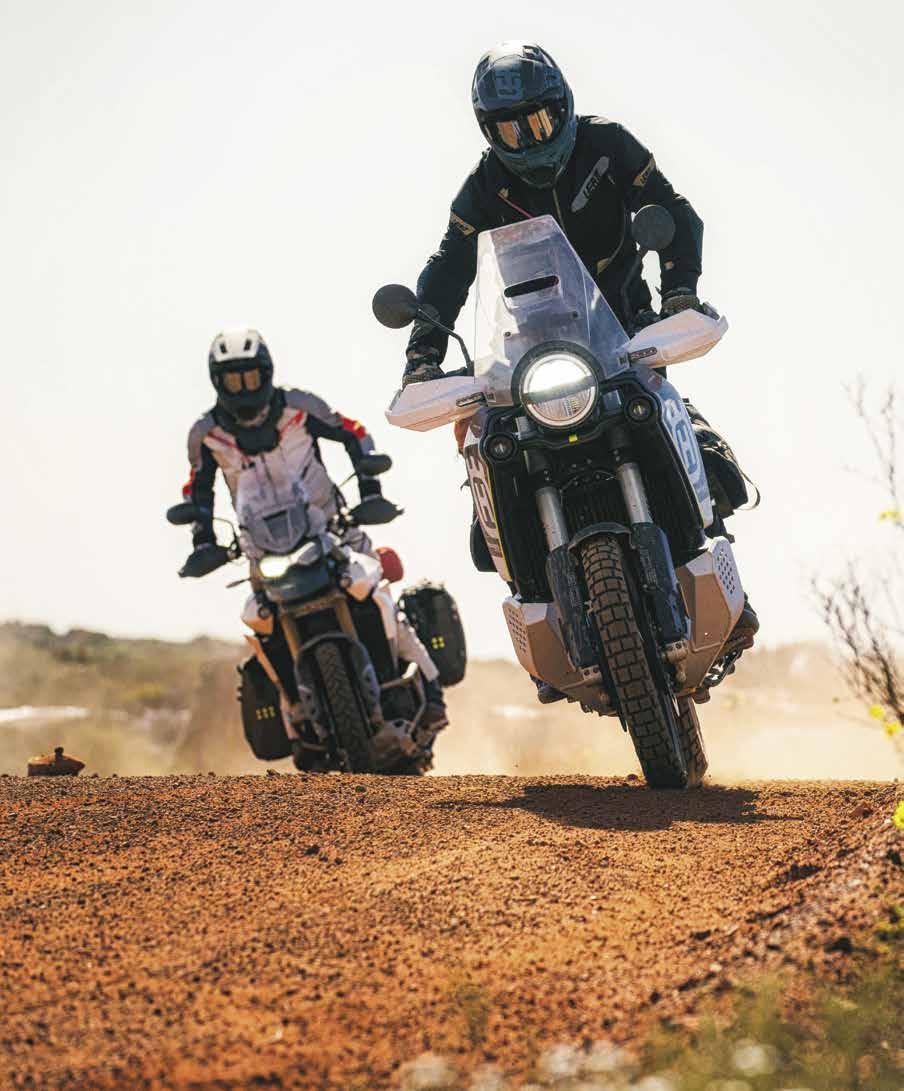
ATGATT
To Neck Brace or Not to Neck Brace
BMW OWNERS NEWS | January/February 2024 54
“Sometimes it takes a good fall to really know where you stand”
~ Hayley Williams, Paramore
 By Dustin Silvey # 224778
By Dustin Silvey # 224778
In a few of my stories published in BMW Owners News, I have mentioned speaking with former MOA President Reece Mullins at the 2022 MOA Getaway in Fontana. A conversation I haven’t mentioned was when we were having lunch and he told me about his new motorcycle. I asked what had happened with his old one, and he explained he had an accident and the bike was toast. My first concern was that he was OK after the crash. His response was, “Well, I wear all my gear all the time, and I pray a lot.”
I am a big advocate of “All The Gear All The Time” or ATGATT. It doesn’t matter if it is a hot summer day and I am only going down to the corner store for a soda–ATGATT. Not wearing gear to me is just madness. Whenever I ride past someone or they pass me and I notice their ankles above their shoes and below their pant legs, I cringe, thinking about ankle burns and road rash. Ugh, I am cringing now just writing about it. I just don’t understand what goes through some peoples’ heads. Even short riding boots scare me. But this brings me to a good point–though many of us are all about ATGATT, many of us have different perspectives of what that actually means.
The general consensus is that ATGATT includes boots, armored pants, jacket made of friction resistance materials, gloves and a helmet. For me there are a few additions. I always wear tall boots due to the fact I am scared of busting an ankle and the extra support always makes me feel more confident, and I wear a neck brace. All these items combined equate to ATGATT to me.
When it comes to riding, Janel is the same way. We both try to influence our friends in this regard as well. We regularly give a hard time to our friends who ride with anything less than the general idea of ATGATT.
January/February 2024 | BMW OWNERS NEWS 55


57 January/February 2024 | BMW OWNERS NEWS
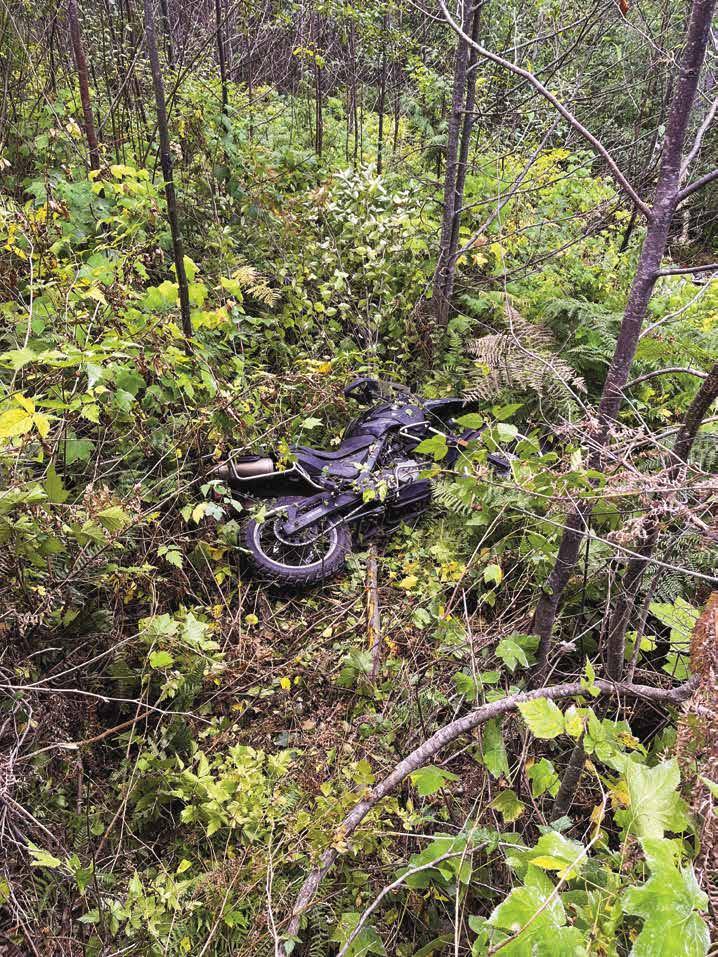
BMW OWNERS NEWS | January/February 2024 58
bike at bottom
Recently, my close friend who used to ride motorcycles came to visit us on the Sunshine Coast of British Columbia. We have some amazing off-road riding here, so I asked if he wanted to go for a ride on Janel’s bike. He was excited and asked about what gear he should wear. He is about the same size as Janel and fit into all her gear. Once he was all wrapped up in the standard ATGATT, I handed him Janel’s neck brace. He asked what it was, and I went on to explain how neck braces work to prevent hyperextension of your neck and can prevent some very serious injuries. He looked a little skeptical but he knew I wore one, so he just put it on.
My friend didn’t have much experience riding off-road so I grabbed some pylons and we headed to a parking lot for some training. After weaving through the pylons for an hour, he looked comfortable standing up on Janel’s motorcycle, and after a few more passes, we headed into the mountains.
My friend is normally a very cautious person, but he was really moving on the back roads, making tight turns, avoiding large holes and even having little to no issues in loose gravel. We got about halfway up one of the mountains when I noticed he had a nail in his rear tire. I checked it over and suggested we get back home quickly as the tire was losing air rapidly and we didn’t have a spare tube with us. About 10 km (6 miles) from my house, we crossed a bridge over a small fast running creek, and I noticed he took the turn really wide. This registered in my mind as fatigue. He was getting tired, and his reactions were slowing. I started to slow down a bit hoping to make him ease off and relax. After the next corner I looked back and realized he was gone. I turned my bike around hoping to find him sitting on the side of the road, but after going all the way back to the bridge I couldn’t find him. Panic began to set in: Was he OK? Where on earth was he? Am I finally going to use my In-Reach? His wife is going to murder me! I quickly turned the bike around and on my second trip back I saw a tire trail going off into the bushes and off an embankment. As I was jumping off the bike thinking I had just killed my friend, he came up out of the bushes without a scratch on him that I could see.
“Are you all right?” I asked.
“Yeah, I am fine, the bike is down that embankment though, man. I am so sorry.” He responded in a voice that was shaky with adrenaline.
“Who cares about the bike?” I said. “I can always fix the bike, I can’t fix my friend.”
He then showed me where the bike was, and I couldn’t believe he was OK. The bike had gone off the edge of the dirt road, launched over a downed
tree, then fell about seven feet down, where it took out another small tree and was lying on its side.
“Wow!” I exclaimed. “When you crash, you really crash.”
We both laughed at that, all while I wondered how the heck he wasn’t hurt. Then of course, we snapped a picture. Don’t judge me! I am a photographer!
With the help of some good-hearted campers, after about two hours we were able to get the bike back up the embankment. We then unsteadily rode back to my house. After a severe verbal beating from both our wives, we took a look at the damage and we were able to get the bike back to running condition with a new front axle, front stabilizer, clutch lever, triple tree and rear tube.
My friend seemed fine. He hadn’t complained about any pain, and he didn’t seem to have any difficultly lifting the bike up the embankment earlier. Now that the adrenaline had ceased, I asked if he was really OK. He was honest and said, “I am pretty sure the bike rolled over me. My neck is a bit stiff and my legs are sore, but I am OK.”
As a former paramedic, I decided I should take a look at his neck to determine if we should head to the hospital just in case. I didn’t notice much, but his explanation of where his neck hurt did suggest a slight hyperextension. This likely did some damage to his ligaments. I looked at him very serious and told him, “That neck brace may have saved you from a broken neck.”
If his neck was sore from the mild amount of hyperextension that was allowed with the brace on, I can’t imagine what would have happened if he didn’t have the neck brace on–well, I can, and it’s not good.
This leads me to the on-going debate about neck braces: to neck brace or not to neck brace, that is the question. Heated debates stemming from social media, personal experiences and just plain argumentative people have put a shadow over the neck brace’s functionality. Like many new means of safety there is often a minority group’s voice that is loudest and more often taken for fact. Thinking back to the time when seat belts were made mandatory, people weren’t resilient, but they did wonder if they were helpful.
During my childhood in the 1980s, I remember plenty of adults not wearing seatbelts; now, however, I can’t remember the last time I got in the car with someone and they didn’t put one on. Is this the direction we are headed in with neck braces? Let’s review some of the comments riders make about neck braces and then some of the data that has been researched.
January/February 2024 | BMW OWNERS NEWS 59
The most common comments from riders against neck braces are:
• A neck brace will break your collarbone if you crash
• They will break your upper back, causing nerve damage and/or paralysis
• They are uncomfortable
• They restrict movement
• They look stupid
• None of them fit right
Let’s address these one at a time:
1. A neck brace will break your collarbone Current neck braces on the market spread the impact below your collarbone on your chest and along your back. Some, such as those made by Leatt, have a collarbone cut-out, thus avoiding the collarbone altogether.
2. They will break your upper back causing nerve damage. The amount of force required to break your back is far more than what your helmeted head snapping back can create.
3. They are uncomfortable. I don’t even notice mine is on; I worry more about my butt going to sleep.
4. They restrict movement. Yes, that is their job. However, neck braces do not restrict rotational movement, so you can still have a full range of vision.
5. They look stupid. I don’t notice when people are wearing neck braces, but if you are more concerned about how you look than your safety, then ATGATT might not be in your wheelhouse.
6. None of them fit right. Previous iterations of neck braces did not have much adaptability, however; more recent models have several settings to make sure they fit riders in a comfortable way.
As you can see, all of the comments above have answers, and you may think I am a bit biased since I wear one. I completely understand that. So now, let’s dig into to some of the research out there.
that a noncritical cervical spine injury was 75% more likely without a neck brace. These percentages support wearing a neck brace, but to be on the side of skeptics, we don’t know the types of crashes each person was in.
Are people who wear neck braces more likely to drive slower, thus ending up in fewer high-speed crashes? Do neck brace wearers crash more often off-road than on, avoiding collisions with other vehicles? These are of course questions that could be answered if we looked further into the data which we don’t have access to, but just taking the data at face value, so far it points at a positive correlation to using a neck brace.
One point the researchers found which is interesting is that when not wearing a neck brace, motorcyclists were 45% more likely to break a collarbone in a crash. This data refutes the above claim that a neck brace leads to a higher likelihood of collarbone break. Finally, the study concluded that a cervical spine injury of any kind was 82% more likely when not wearing a neck brace.

One study examined motorcycle accidents from 2009 until 2018 in five U.S. states. Examining the data, they found that cervical spinal injury was 89% more likely without a neck brace. They also found
All of the above data supports wearing a neck brace when riding a motorcycle. There are other studies out there as well. Several peer-reviewed studies agree that neck braces for any two-wheeled sports (cycling, motorcycling, etc.) only protect from hyperflexion and hyperextension (forward and
BMW OWNERS NEWS | January/February 2024 60

backwards neck movement). There is limited protection from the tilting of the neck left or right. This might seem to be a disadvantage, and for ultimate safety it is; however, the neck braces are designed mainly to prevent hyperflexion and hyperextension. Any type of lateral movement prevention is secondary since we need to be able to move our heads and necks while riding to be able to see oncoming traffic.
It is important to note that any gear only serves to prevent injury when things go wrong. The best option for an accident is just to not get into one. Take motorcycle training, be aware at all times when riding and know your route. When things do go wrong, make sure you are riding ATGATT. I know I am, and that includes a neck brace, even if some people might think I look dumb (I still don’t understand that comment). I know it saved my friend, and that is all the results I need to see.
Note: OK, that last statement made for a good ending, but as a research doctor I do have to stress I need more than one real-life example to make an opinion on something. I have however reviewed a lot of data and see the logic in wearing a neck brace based on numerous studies.

Dustin grew up in Quesnel, British Columbia, and began riding on the back of his father's motorcycle many years ago. He has a doctorate of Community Health with a speciality in Indigenous Health. He currently works several contract positions with Indigenous organizations across Canada. Dustin's publication credits include The Globe and Mail, CBC, and Vice News, along with several extreme sport magazines such as Explore, Sidetracked, Canoe and Kayak, and Paddle Magazine.
Dustin and Janel currently live in Powell River, British Columbia.
January/February 2024 | BMW OWNERS NEWS 61
By Kandi Spangler #220021
Mastering Your Machine:
Small Changes Often Make the Biggest Impact
“"""Feel your butt!” That was the phrase etched into my brain 15 years ago when I had the opportunity to do a training flight with world-renowned aerobatic instructor Budd Davisson.
We began our training by flying a warm-up training maneuver called “boxing the wake,” where I would maneuver the airplane in a benign, box-like pattern before moving on to more advanced maneuvers. Our first exercise was designed to focus on coordinated flight around all three axes of the airplane. While it doesn’t sound exciting or particularly hard, it was the basis for subsequent maneuvers that would have us flying upside-down and practicing loops and rolls while pulling both positive and negative Gs.
In my opinion, it was also the hardest maneuver to perfect because it required small, yet constant changes in pitch, yaw and bank, all while keeping the airplane in “coordinated flight.” Instead of looking at the trusty turncoordinator located on the instrument panel during the maneuver, Budd would insist that I look outside and make the maneuver using my internal turn-coordinator–in other words, my butt! Coordinated flight meant keeping my weight firmly in the center of my butt throughout the maneuvers. If for any reason I felt my weight shift even slightly to the side of my butt (think of how your weight shifts in the seat of a car if you take a curve too fast), then we were “uncoordinated” and he would bark, “Feel your butt!” It’s not necessarily that hard to stay coordinated in steady-state flight (like during easy, constant-rate turns), but boxing the wake with small, yet constant changes in pitch, yaw and bank made coordination–keeping my butt centered in the seat–infinitely more challenging.
If you’ve read my previous articles about training, you know I draw a lot of parallels between my riding and flying experience and I approach both activities with a mindset of mastering my machine. But being a master of any machine doesn’t come from experience alone; it comes from a conscious effort to consistently train and practice at a very high level. So, it’s no surprise I drew parallels when I recently took the Authority School at the BMW Performance Center in Greer, South Carolina.
Advanced classes like these are my favorites because you’re not learning macro-level inputs to make the bike do what you want, rather you’re learning about physics, the bike’s capabilities and how seemingly tiny changes in your technique can yield massively different, and impressive outcomes. Advanced classes can teach you the difference between running an exercise at 1,500 RPM vs. 2,000 RPM, or how moving your shoulders another inch to the outside of the turn can give you enough counterbalance to tighten your turn by six inches. These tiny changes and fine-tuning of your skills and using your internal instru-

BMW OWNERS NEWS | January/February 2024 62
mentation of sight, feel, and sound, are where the magic happens and where a highly skilled motorcycle instructor can help even the best riders.
This particular two-day class was taught by the Rider Academy’s Chief Motorcycle Instructor Aaron Rankin, a recently retired Sheriff’s Office Captain with 30 years of experience, including 12 as a Motor Officer. Originally developed for law enforcement officers, this course is designed to turn “riders” into “operators” through an intensive curriculum that includes tight turns, slow speed navigation, high speed maneuvers, sight lines, and safety using body, eyes, brain, and bike controls.
Part of what appealed to me about this class was how it was developed and is taught only by current or retired motorcycle police officers. In my mind, this is akin to me getting pilot training from a Blue Angels pilot, so I jumped at the chance to take this class. These motor officers go through grueling training exercises, often on a monthly basis, both at slow and high speeds and then they throw in some occasional gunfire (paintball or beanbags for training purposes) while riding through tight cone courses. If that isn’t pressure, I don’t know what is. As you can imagine, the instructors for the Authority School are extremely skilled riders and cool as cucumbers under pressure, so I couldn’t wait to learn from them.


From the time you arrive at the Performance Center, it’s apparent the Authority School instructors aren’t there to teach you to ride; they’re there to fine-tune your riding skills to help you transition from a good rider to a great rider. They accomplish this through a set of cone courses in a parking lot that will be your training ground for the following two days. But it’s not riding these courses over-and-over that make you a better rider. The real magic happens as the instructors spot tiny errors in real-time and offer tips and minor changes that make a BIG difference in your riding. It’s the immediate feedback from a skilled instructor with a watchful eye who can spot errors and make those small corrections that makes this course, and the others offered by the Performance Center, worth the price of admission.
While Aaron didn’t yell, “Feel your butt!” as I was riding, he did bark other instructions throughout the two days that
will be forever etched in my brain. Instead of focusing on the cones and riding a pattern hoping I didn’t hit any of the cones, he had me intently focus on my own internal instrumentation (my senses) to perfect the exercises–hearing and managing my engine’s RPM, feeling the bike fluidly move independently under me, finessing my touch on the controls, and focusing my vision further ahead into the maneuver. My brain began the difficult rewiring process, and eventually I would do all the courses without fail…until they secretly began moving the cones tighter!
My favorite part of the course came during the afternoon session of the second day when we moved from the parking lot onto their track. There, they set up a series of high-speed cone courses that would maximize the advanced technology of the R 1250 GS as we executed weaving and emergency (threshold) braking
exercises. At no time in my 40 years of riding has anyone told me to “grab” the front brake until this class. My brain bucked at the idea, and my first couple attempts yielded an ingrained aversion to abruptly and forcefully squeezing the front brake.
“Break that front brake lever off!”
Aaron yelled, as I circled back around for another try.
On my third attempt, I adjusted my handhold on the right handlebar and spoke out-loud to myself before starting my takeoff roll, “full brake, full brake, full brake.” I cringed as I approached the stop cones and fought my instincts. As soon as my front wheel crossed through the coned gate, I stomped on the rear brake and then immediately squeezed the front brake lever with all my might. The tech on the R 1250 GS responded immediately as I felt my weight lurch forward (which they taught us to prepare for) and the ABS chattered away until I came to an abrupt stop in a distance I

BMW OWNERS NEWS | January/February 2024 64
"The instructors for the Authority School are extremely skilled riders and cool as cucumbers under pressure, so I couldn’t wait to learn from them."


never thought possible.
As an MSF RiderCoach, I truly thought I was skilled at emergency or “threshold” braking. But once I was armed with a basic understanding of the technology installed on that specific model bike, equipped with the proper technique for threshold braking on that motorcycle, and then given immediate training feedback from a skilled professional, I learned I could substantially reduce my braking distance even more, perhaps by as much as 25%! This is where the difference between being the student versus being the instructor really hit home for me. As instructors, we’re conditioned to teach in a way that will benefit the general population of riders who are newer to the sport.
no technology at all and for students new to riding. In other words, macrolevel skills. This advanced class, however, was designed to maximize both rider and motorcycle capabilities and translate that into peak performance maneuvers. In this exercise, it meant the
hindsight this lesson made total sense, but the application had never been taught to me in this way. Both the lesson and experience yielded yet another “Aha!” moment when I re-learned the relationship between swerving and emergency braking was an “either-or” relationship.
To go from being a rider to a skilled pilot of your motorcycle, you need a watchful instructor to provide real-time feedback when you're in search of perfecting your practice.
This means teaching techniques that will work for older motorcycles with dated, or
shortest stopping distance possible, and it was impressive once properly executed. Rewiring my brain continued. Another lesson from that afternoon dealt with the relationship between threshold braking and swerving. In
In the MSF Basic RiderCourse, we teach students to swerve, then brake. We don’t really teach them why, but we teach them how. So, Aaron painted us a picture using a real-world scenario. What if I were to crest a hill on a highway going 60 mph and suddenly saw three lanes of traffic stopped less than 50 feet ahead? Would I swerve first then brake, or brake, then swerve? Or would my brain just say do everything all at once. Rote memory can be helpful at times, and at other times it

can be detrimental. This is where teaching the why and how can be more beneficial.
In this exercise, Aaron had us approach a set of cones at 50-60 mph, beyond which we would apply full emergency braking to get slowed as quickly as possible. Before coming to a stop however, there was a second set of cones simulating the rear-end of a tractor-trailer straight ahead and it was impossible to get stopped before reaching this second set of cones. This required us to release the brakes before quickly swerving, and then going back to forcefully squeezing both brakes until coming to complete stop. Releasing the brakes isn’t necessarily required prior to swerving in an emergency braking situation on the R 1250 GS due to lean-sensitive ABS Pro, but there are other factors at play that clearly support the Performance Center’s curriculum of separating the two actions. For fear of getting hate mail and wise-cracking comments in next month’s issue, I won’t go into detail on the physics and other forces at play, but the act of emergency braking and swerving at the same time simply means you won’t get 100% of the bike’s capabilities. For any given scenario, you must decide whether you want 100% of the bike’s braking capability, or if you want 100% of the bike’s swerving capability. This is partially due to the tech installed on modern-day bikes, and partially due to good old-fashioned physics. But the end result could mean the difference between slamming into the back of the imaginary semi-truck/cones or clearing it. My takeaway from this exercise, however, was that if we practice “eitheror” type maneuvers in the same order every time (like the MSF curriculum), we end up relying more on rote memory versus utilizing the bike’s tech and my skills in the order that is most beneficial for the situation. More brain rewiring ensued, and I made a mental note to incorporate different braking and swerving scenarios when I train at home.
My two-day class concluded with a short debriefing, presentation of our completion certificates, and group pictures before I left the Performance

Center with a huge smile on my face and my body feeling sore and completely exhausted. Back home in Denver two weeks later, I showed up at my regular group training session to continue practicing my refined skills. My fellow high-performing, motorcycle-practicing rider geek friends could immediately see my improvement and commented on my riding that day.
“You’re on fire today, girl!” the group’s leader commented.
I’ve attended these weekend practice sessions a hundred times, but the comment made me think of a saying I’ve often heard: “Practice doesn’t make perfect; Perfect practice makes perfect.”
To go from being a “rider” to a skilled “pilot” of your motorcycle, you need a watchful instructor to provide real-time feedback when you’re in search of perfecting your practice. A skilled and experienced rider will never truly reach perfection, but it’s important to realize the biggest improvements often come from the smallest changes in your inputs, and this is the path towards mastering your machine.

Kandi Spangler is an MSF RiderCoach and two-time GS Trophy finalist, having won a spot on the U.S. Women’s Team in 2019 and 2021. She has ridden and competed on an F 700 GS, an F 850 GS, and an R 1200 GS. She now rides an R 1250 GS at competition level. Kandi currently helps riders reach and exceed their riding goals through training, education, and speaking events. To learn more, visit motoikandi.com
January/February 2024 | BMW OWNERS NEWS 67

BMW OWNERS NEWS | January/February 2024 68

NICK IENATSCH: Teaching Skills to Diminish Risk
BY ED HOUSEWRIGHT #234070
Nick Ienatsch loves motorcycling.You can hear it in his voice. You can see it in his expressions.
Ienatsch has spent a lifetime in motorcycling–as a racer, instructor, business owner, journalist, and author of the popular book Sport Riding Techniques. One of his proudest achievements is the Yamaha Champions Riding School, which he founded in 2008. Since then, the school has instructed more than 10,000 students on the proper way to ride. That number continues to grow with more than 15 annual sessions held around the country.
Ienatsch, 62, worries that too many people ride a motorcycle without the proper skills, leading to unnecessary injuries and death.
“There’s so much information out there that literally kills people,” Ienatsch said. “In fact, new riders are learning things at some schools that lead directly to the crashes we’re having. They’re told not to trail brake–to get all their braking done in a straight line. That leads directly to running wide in corners. They’re taught to power through the corner. That also leads directly to running wide in corners. They’re scolded if they cover the brake. Then they only practice braking at maybe 20 or 22 miles per hour.
“So, there’s no mystery here why we’re not growing like we should and why new riders either scare themselves,
hurt themselves, or don’t continue in the sport. This sport is so doable and can be so safe and so therapeutic and enjoyable, but not the way it’s taught in many places.”
Ienatsch got his first motorcycle, a dirt bike, at age 12. He loved riding but said he didn’t have much skill. “I was a terrible rider,” he said. “Nobody was around to tell me anything.”
Still, he persevered, improved his skills, and got his license at 16. At 18, he started working as a mechanic at a Suzuki shop while attending college. He loved it and stayed there for several years. “My dad said, ‘Are you ever going to graduate?’”
At 24, he started writing for Motorcyclist magazine. He began interviewing racers and watching their technique. Eventually, he started racing himself. He was the WERA Grand National Finals champion in three classes in 1989 and the ARRA #1 plate at Willow Springs Raceway in California in 1989 and 1990.
“I had a very strong career,” he said. “It opened a lot of doors and got me into the right places.”
While racing professionally, he continued as a motojournalist. He was the founding editor of Sport Rider magazine in 1993 and later wrote for Cycle World. He now writes for Road Racing World. And he’s never retired from racing. He’s won a bunch of vintage bike races in events sponsored by the American Historic Racing Motorcycle Association.
January/February 2024 | BMW OWNERS NEWS 69
“I really enjoy speed, and I really enjoy competition,” Ienatsch said. “There’s no replacement for it. There’s nothing like climbing on a bike–it’s just the best. I really enjoy working on bikes—cleaning them, tuning them, tweaking them. I love the people. My best friends are road racers. There’s a humility, especially in racers who have been to a high level. They know what it’s like to crash on the warmup lap.”
Yamaha Champions Riding School began with the two-day “ChampSchool.” Since then, it’s added the one-day “ChampStreet” and online courses “ChampU,” “New Rider,” and “ChampBody.” It will soon introduce a new online course, “Traffic Survival.”

“Traffic safety is the number one complaint we hear, “Ienatsch said. “You need to be safe whether you’re seen or not seen.”
The school now has more than a dozen instructors, including champion racers Chris Peris and Kyle Wyman.
“I’d say all my guys are on a mission because they’re extremely accomplished, but they were helped at the right time by the right information from someone who knew more than they did,” Ienatsch said. “Now they want to pass it on. I have a really incredible group of young people. I heard a saying years ago, ‘Success isn’t success without a successor.’ I’ve got amazing, amazing people. I can now stay home and know they’re kicking ass. It’s quite a feeling.
“We’ve got a stack of resumes from people who want to work here. A lot of these guys truly are champions in road racing, but it’s more than can you ride fast. In fact, we will hire on personality and then teach the rest of it. We have a few instructors who have never raced and may never race. But they have the right personality. They’re humble, helpful, and a little laid back. They would do this on their own for free.”
Ienatsch and his instructors love riding–and teaching riding, but they don’t downplay the inherent danger.

BMW OWNERS NEWS | January/February 2024 70
Left, Nick teaching in a classroom. Above, Nick teaching on the track.
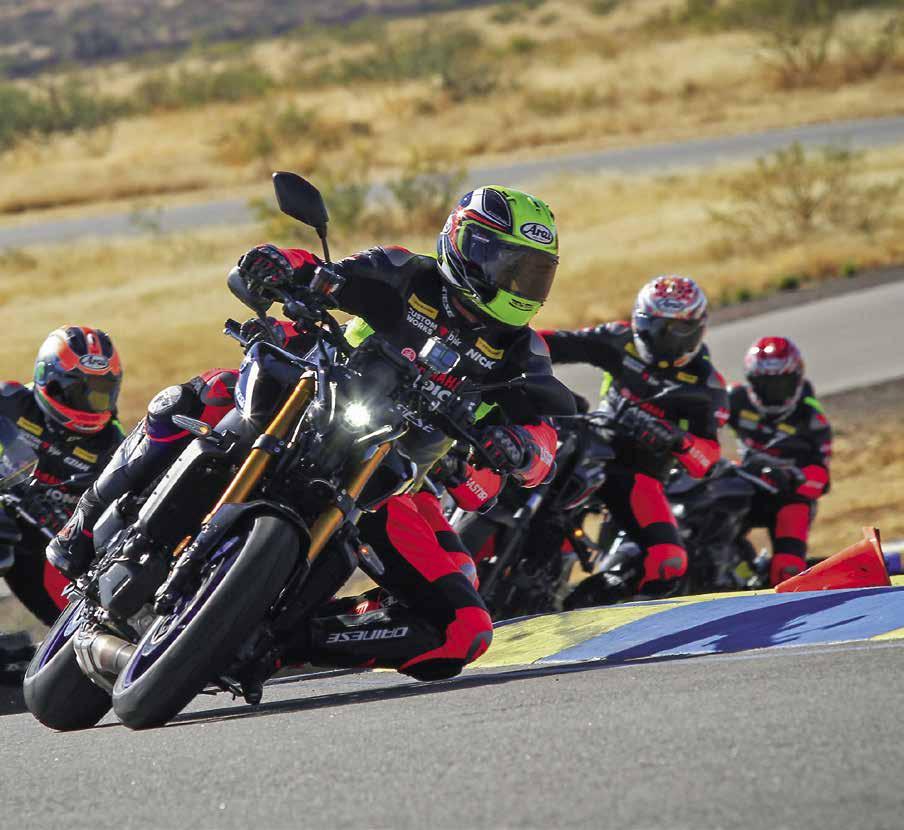
January/February 2024 | BMW OWNERS NEWS 71


“There’s the acknowledgment of risk,” he said. “But good skills diminish risk. That’s really what we’re trying to do. If the risk wasn’t manageable, I don’t think I could do a school. I couldn’t look everybody in the eye. There’s a bunch of ways to mitigate risk, and we teach them all.”
These days, Ienatsch lives in southern Colorado with his wife, Judy, also an avid rider. Together, they own more than 20 motorcycles, primarily sport bikes. He rides almost every day, even if it’s only down to the mailbox.
“I tell my young instructors I enjoy riding now more than ever,” he said. “I think it’s because of the perspective of being older and still being able to do something that’s this neat. I see it as magical.”
He’s encouraged about the future of motorcycling. He believes a new generation of riders will be drawn to electric bikes.
“Mastering the clutch holds people back,” he said. “Electric bikes don’t have a clutch, and they’re wonderful to ride. It’s an amazing technology. Without that clutch, it gives people an “in.” I have friends who run new rider schools, and they’re seeing a lot of people signing up. But if these students aren’t equipped with the right information, they won’t be able to continue. If you ride across the centerline, and there’s a car there, you could die. That’s really what drives us.
“I’m not a fan of growth for the sake of growth. The sport is so edgy and can hurt you so badly that I truly don’t mind if it’s controlled and enthusiastic, as opposed to, ‘Everybody ride. Come down here Sunday, and we’ll get you on a bike.’ I want people who are motivated and dedicated because one little mistake without a helmet on, and you’re done.”
Hear more from Nick on The Ride Inside with Mark Barnes, available in your favorite podcast app and online at bmwownersnews.com

Ed Housewright is an award-winning journalist and author. He spent almost 30 years as a writer for the Dallas Morning News, covering a wide range of topics, and has written six books. They include three histories of the Dallas Cowboys and a biography of G.A. Moore, a legendary Texas high school football coach who won eight state championships. When Ed isn’t motorcycling, he enjoys golf and other outdoor activities.

January/February 2024 | BMW OWNERS NEWS 73
YAMAHA CHAMPI RIDING SCHOOL
BY ED HOUSEWRIGHT #234070
This may sound crazy, but I took up motorcycling five years ago at age 60. My friends and family members thought I’d lost my mind. You’re doing what? Don’t you know how dangerous motorcycling is? At your age?
It was hard to explain why I suddenly wanted to ride. I never had before. But when I turned 60, something clicked, and I had to try motorcycling. Maybe I’d hate it. Maybe I’d fail miserably. But I had to try.
I took a Motorcycle Safety Foundation beginner’s course. I did all right, not great, and bought my first bike. The more I rode, the more I got hooked. I became a passionate rider and logged mile after mile. I read a few instructional books and watched some YouTube videos, but I was largely self-taught.
Until I took the Yamaha Champions Riding School course in September.
The course advanced my motorcycle knowledge and riding skills at warp speed. I wish I had taken it years earlier. Yamaha Champions was started in 2008 by Nick Ienatsch, a veteran motorcycle racer, instructor, and journalist. It offers a two-day course called “Champ School” and a one-day school, “Champ Street,” at locations around the country.
I signed up for Champ Street at a
race track near my home in Dallas, Texas. Before taking the course, I enrolled in “Champ U”–an online course with a similar curriculum. Champ U opened my eyes to the complexity of safe, skilled motorcycle riding. It covered a vast amount of territory, starting with the mental approach and moving onto cornering, braking, shifting, body position, and more. I felt like I was drinking from a fire hose. So much information to take in. I completed Champ U over several weeks and felt much more confident.
But something was missing. I needed highly qualified instructors to guide me through the lessons I’d learned in Champ U in person. On a track and with other eager students who could provide encouragement. I found all of this in Champ Street.
I arrived at Cresson Motorsport Ranch at 8 a.m. and met eight other riders and two instructors. The bikes ranged from small commuter bikes to speedy sport bikes to comfortable cruisers. It didn’t matter what kind of bikes people rode—the same lessons would apply.
We met the two instructors, Steve Ritchey and Scott Rybarik. The other students and I formed an immediate bond with them.

BMW OWNERS NEWS | January/February 2024 74
ONS

January/February 2024 | BMW OWNERS NEWS 75

Throughout the eight hours, they were consistently positive, patient, and encouraging. The skill level of the students varied widely. Some, like me, had ridden only a short time. Others had ridden their entire life. We had men and women, ranging from their 20s to 60s. The instructors managed to engage all the students equally. No one looked off into the distance, bored. The pace of instruction was swift, moving from topic to topic. Sometimes, we stood next to our bikes and listened as Ritchey and Rybarik covered certain points. Then we mounted our bikes and rode on a large, paved area or the racetrack to practice the lessons.
Texas is notoriously hot in late summer and even into September. The day of my course was no exception. The high topped out at 105! The instructors were well aware of the discomfort, and even danger, posed by the extreme heat. They brought ice chests full of water and encouraged us over and over to take breaks, get in the shade,
and stay hydrated. The course requires students to wear full safety gear—boots, pants, jacket, gloves, and helmets. Despite the oppressive heat, the instructors never allowed us to shed any layers to stay cooler. Safety first. The course included a tasty lunch with sandwiches, pasta, chips, and fruit, and the time allowed us to cool off more.
Champ Street began, just as Champ U had, with an emphasis on the proper mental approach to riding. I found it interesting that Ienatsch, in writing the curriculum for both, didn’t begin with cornering, braking, shifting, or other technical skills. He began with getting your mind right to ride safely. I and the other students in Champ Street were handed a sheet that listed the four “Core Champions Habits.” Mental Focus and Refocus topped the list.
“Have a plan before you ride,” it said. That plan should include a pre-ride routine. The instructors mentioned that the best motorcycle racers in the world have a set routine to dispel distractions and lock in focus on the challenging, dangerous task ahead. As street riders, we should do the same. The instructors encouraged each of us to go a step further and develop a mantra–a catchy saying we could repeat each time before we ride to make us laser focused. I came

up with “Get Serious.” After the class, I even taped “GS” on my gas tank. Every time I look at those letters, whether it’s before I ride or during a ride, I’m reminded to shoo away distractions and commit to safety.
The instructors emphasized focusing and refocusing. “Get over mistakes immediately,” our worksheet said. Even the most experienced, skilled riders lose focus and make mistakes. They might misjudge a corner and run wide into opposing traffic. They might follow too closely behind a car and suddenly have to brake to avoid a collision. They might daydream and miss some gravel in the road that could cause them to lose traction. We’re all human.



BMW OWNERS NEWS | January/February 2024 78
Acknowledge a mistake, refocus, and move on. Otherwise, more mistakes–with potentially dire consequences—could occur.
After the emphasis on mental preparation, the instructors moved onto more technical points, such as traction–the lifeblood of safe riding–and how it’s affected by lean angle, braking, and acceleration. They dispelled several myths, such as never to use your front brake out of fear it could catapult you over the handlebars. The instructors stressed that the front brake is far more powerful than the rear and should always be used. The key is to use it gently and steadily–never abruptly, which could lock up the front tire.
Another myth is that it’s unsafe to brake in a corner. The instructors dispelled this, saying the brakes should actually remain on as we enter a corner to provide more control and the ability to stop sooner if an emergency occurs. They stressed that we should always ride with two fingers on the brake lever whether we’re in a corner or a straightaway. “Covering the brake” can save critical time and stopping distance. For instance, it can take a half-second to reach the brake lever in an emergency if we aren’t covering the brake. That half-second translates to 44 feet of stopping distance at 60 miles per hour. Think about it–44 feet could be the difference between stopping safely or plowing into the side of a car turning in front of us.
We learned a lot about braking in Champ Street. Here are some of the bullet points on our worksheet:
• Initiate braking when you’re nervous about traffic, entering corners, hazards.
• Use brakes until happy with speed and direction.
• Verbs like “grabbing, stabbing, flicking” must be removed from riders’ vocabularies.
• Front brake is the workhorse; rear brake is more useful on longer-wheelbase bikes.
The instructors also stressed vision–looking far ahead down the road for danger, then back in front of us. “Eyes up sooner,” the worksheet said. “Learn to scan out and back. Move eyes more quickly. Seeing things early slows everything down, increases time and distance to react.”
Throughout the course, the instructors sprinkled in the seven reasons why people crash on a motorcycle. The first shouldn’t be surprising: lack of focus. “Motorcycles can be dangerous; be mentally all in.”
The other six reasons we crash:
• Abruptness
• Rushing a corner
• Repeating a mistake
• Cold tires—taking time to warm them up so grip will improve
• Not adjusting to change—such as wet conditions
• Overconfidence
The last sentence of the worksheet grabbed me: “Become a lifelong student of riding.”
As the course progressed, I could feel my skills improve and confidence rise. Riding became even more fun. I noticed a lot of smiles on the other students as well. But my primary takeaway was that we should always seek to improve as riders. We’ve never mastered the skill. Champ Street (and Champ U) were great, but I should still practice on my own and take more lessons down the road. I’ll likely take the two-day Champ School course next.

After I finished Champ Street, I had a chance to chat with Steve Ritchey, one of our instructors. He has a fascinating story. He spent 25 years as a motorcycle officer for the Las Vegas Police Department. He estimates he has ridden 750,000 miles throughout his lifetime–all without an accident. You might think he’d be cocky and feel he’s mastered motorcycling. Wrong. He’s gone through Champ School himself and has taken one-on-one training with other staff members of Yamaha Champions Riding School.
“When you say, ‘I got this figured out, I’m good,’ you better park the motorcycle,” Ritchey told me. “I tell everybody you want to be a forever learner when it comes to motorcycles. Riding motorcycles is a perishable skill. The more you ride, the better you’ll get. If you don’t practice, you don’t get any better.”
January/February 2024 | BMW OWNERS NEWS 79

ONLINE COURSES
Based at both NCBike in Garysburg, North Carolina, and Inde Motorsports Ranch in Wilcox, Arizona, Yamaha Champions Riding School rotates through a wide variety of racetrack locations across the country annually with their immersive two-day ChampSchool training program.
This highly evolved operation supplies a curated selection of Yamaha motorcycles, premium gear and videotaping services alongside classroom and on-track instruction by impressively credentialed experts for riders of every skill level, from neophyte to professional racer. Class sizes are extremely small (4:1 ratio of students to instructors) and the days are fully catered. As you’d expect, such a top-shelf experience comes with a hefty price tag:
INVEST IN U INVEST IN U INVEST IN U INVEST IN U
INVEST IN U
Mark Barnes #222400
$1,895-$4,000, depending on location. Bike and gear rental is extra, but students can bring their own (all adequately prepped motorcycles are welcome, regardless of genre, but full leathers are required). YCRS also conducts ChampStreet classes wherein students ride their own bikes in the paddock or on a kart track in a one-day format focused on essential street skills at a much lower cost of $495-$595 (non-leather riding gear is allowed). Other offerings are available, including individual instruction and remote review of your submitted video; see ridelikeachampion.com for details.
Riders preparing for in-person training or looking for instruction available without leaving home can access YCRS curricula via
BMW OWNERS NEWS | January/February 2024 80
UNIVERSITY
MOA MEMBERS CAN ACCESS THE CORE CURRICULUM AT A GREATLY REDUCED COST OF $39.95, WHICH CAN THEN BE COVERED BY A REBATE FROM THE MOA FOUNDATION, MAKING IT TOTALLY FREE (SEE BMWMOAF.ORG FOR DETAILS AND SPECIAL REGISTRATION LINK).
ChampU, a set of online courses containing videos, quizzes, and activities designed to maximize learning at the least possible expense, a mere $99.95 for the Core Curriculum (access is included in the price of in-person tuition). New Rider and ChampBody (rider fitness) courses are available for $19.95 and $69.95, respectively, and a brand-new course, Traffic Survival, is $79.95. Some courses can be bundled at a discount. Given the wealth of high-quality material in each package, those prices represent outrageous values, but as they say in late night TV ads, Wait – there’s more! MOA members can access the Core Curriculum at a greatly reduced cost of $39.95, which can then be covered by a rebate from the MOA Foundation, making it totally free (see bmwmoaf.org for details and special registration link). You don’t have to order before midnight tonight to get this amazing deal, but why wait?
Before we get into additional details about ChampU, here’s some background on YCRS. Founded by CEO and Lead Instructor Nick Ienatsch in 2008, the name’s reference to “Champions” isn’t just a hook to attract students who want to think of themselves as such, or even win real championships. It’s part of an overarching philosophy that riders at the very peak of skill development are the best equipped to teach riding skills, not because all students aspire to road racing greatness, but because a) motorcycles are developed by expert riders and function best at any speed and in any context when operated using the same techniques those expert riders used, and b) there’s a convergence at the top of the expertise pyramid, with the very best riders using very similar methods, whereas less advanced motorcyclists employ a broader range of approaches with less overall efficacy.
The core team of YCRS instructors have demonstrated unquestionable technical mastery by establishing themselves as bona fide champions in the crucible of officially sanctioned competition. Their “Champion” status is an objectively verifiable matter of public record, not someone’s opinion. Ienatsch, whom you probably recognize as a long-time motojournalist (he has written extensively for Motorcyclist, Sport Rider, and Cycle World since 1984), has multiple national #1 plates of his own, and taught for 12 years at Freddie Spencer’s High Performance Riding School. He’s an extraordinarily articulate communicator with the analytic mind of an engineer, all readily apparent
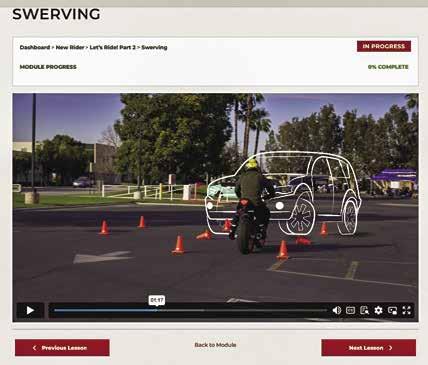

January/February 2024 | BMW OWNERS NEWS 81

in the clarity, precision and conciseness of the curricula he has developed for YCRS in collaboration with his crew. Ienatsch has a passion for teaching and understands how to engage the hearts and minds of students at any level of competence. He has been careful to select only those instructors who can do likewise. Subject matter expertise doesn’t necessarily come with the necessary attitude and skill set for effective teaching, so Ienatsch’s sense of mission and prioritization of customer service have driven him to ensure each member of his staff has the complete package. (Hear my in-depth interview with Nick Ienatsch on The Ride Inside podcast, available at bmwownersnews.com.)
An example of YCRS’s excellence in teaching is their distillation of numerous riding essentials down to four core Champion Habits. (Spoiler alert–er, non-spoiler alert: I’ll not list them here because I want you to check out the curricula for yourself!) These are pithy phrases that capture action-oriented concepts fundamental to good riding at any speed, in any setting. Based on the principle that technical proficiency is an indispensable requirement for both safety and enjoyment, the Habits permeate YCRS’s entire curricula. Everything comes down to a conviction that there’s a path forward for any rider desiring to improve: learning specific, concrete, demonstrable “best practices” invariably results in better performance, with the associated benefits of greater safety and more fun, whether riding casually on the street or pursuing trophies at the track.
Be forewarned, these best techniques will likely conflict with some–maybe much–of what you’ve been taught by other riders, and perhaps even other rider training programs/instructors of lesser sophistication.
At YCRS, “best” is what has been proven at the pinnacle of competition, not what might arise from someone’s theory or a popular notion. These teachings will undoubtedly differ from what the average rider figures out by trial-and-error without the benefit of rigorous testing in the unforgiving laboratory of the racetrack. The good news is no one has to reinvent the wheel. The knowledge gleaned by genuine champions can be taught, saving students immeasurable amounts of time and the painful costs (physical and financial) of needless mistakes. While there are details of special interest to racers and certain techniques advisable only in a closed-circuit setting, the same foundational principles of motorcycle control apply to riding at all
levels. All the expected subject matter is present – counter-steering, braking, shifting, traction management, lean angle, body position, etc. – along with less commonly discussed topics, like strategic suspension loading/unloading. Even the familiar areas likely contain new-to-you info with serious implications for your non-champ habits.
Just in case you still think racer wisdom isn’t relevant to riding on the street, consider this: The YCRS approach is intentionally designed to grow the riding community (obviously comprised of mostly non-racers) and keep its members from departing the fold because of injury or death. The two leading causes of riding disasters are a) collisions at intersections, especially unmanaged ones (e.g., driveways and parking lot exits), and b) riders running wide in corners (into oncoming traffic or off the pavement). YCRS courses are aimed at minimizing the likelihood of these specific events with strategies and actions that greatly enhance control in real-world emergencies most riders consider a function of “bad luck.” YCRS has identified the seven most common reasons riders crash (anywhere), and these problematic practices – yes, they are attributable to rider error, not just happenstance – are addressed repeatedly throughout the training.
YCRS’s ChampSchool is impractical for many riders due to its expense, distance, and concentrated time commitment, so Ienatsch and company launched ChampU as an alternative in 2021, hoping to get their message out to a broader audience. It has since evolved rapidly and is currently comprised of the four courses already noted. Each of these is well organized into readily digestible bite-sized pieces–topical modules further subdivided into lessons that typically include a three to eight minute video containing explanations and demonstrations, followed by brief (and often amusing) quizzes to promote attentiveness. Students must pass each quiz with 70% correct to advance to the next lesson, but this is easy to do by simply paying attention during the lesson and reading the questions and answers carefully and completely; the first rule of YCRS is Focus!
You can always re-take the quizzes if necessary, and the reasons for correct/incorrect rulings are clearly explained. Many modules also contain drills and exercises designed to provide the vitally important experiential reference points that make abstract concepts meaningful and useful in actual practice. As you’d expect, the vast majority of these are performed with a motorcycle, but some can be done in your car/truck/van, some on a bicycle, and some simply involve your own body. Those utilizing your motorcycle don’t necessarily require it to be moving or running, so you can do some practicing in the confines of your garage.
One example of this is developing subtlety in brake lever operation by feeling the drag created by very slight application as you walk your bike across the floor. It’s imperative students go through the lessons at a pace that allows completing these activities. Even if you’re able to memorize the enormous quantity of information presented, it will be of
BMW OWNERS NEWS | January/February 2024 82
Traffic survival discussion.
terribly limited value in real-world situations demanding reflexive responses; those can only be developed through repetitive physical action, regardless of intellectual understanding.
Another illustration from the Core Curriculum I found brilliantly illuminating was a demonstration of tire traction, specifically the stark contrast between steady and abrupt demands. While I’ve been aware of this principle for a long time, it was still powerful to watch as an instructor tilted an upright tire, stepped away from it while leaning on it, and showed how the tire’s contact patch spread and gripped in a way that looked impossible (I’d have guessed it wouldn’t support his weight like that). He then knocked the tire with the heel of his hand, creating little spikes of pressure that easily overwhelmed the tire’s traction and sent it skittering under much less load than it had withstood at a constant level. Such immediately compelling demonstrations aren’t possible with still photos in a book or on a webpage, or with words alone.
The Core Curriculum course (13 modules/52 lessons) is the most comprehensive of the four, but the latest addition–Traffic Survival (6 modules/43 lessons)–is also a must for riders who want to hone their accident-avoidance skills and learn how best to navigate perils specific to the street (Core Curriculum is a prerequisite for enrollment). It covers psychological and behavioral aspects that build upon basic technical competence to help riders stay unhurt, even when they’re unseen. Fans of David Hough’s Proficient Motorcycling series will find some familiar tactics presented in fresh ways here, elaborated with the benefits of videography and integrated with the teachings from the Core Curriculum. There’s also much in Traffic Survival that picks up where Hough’s writings left off, advancing street safety to a higher plane; it’s not just a repeat. The New Rider course (nine modules/56 lessons) is self-explanatory, but it bears noting that even this most basic option emphasizes the same fundamental principles and practices contained in the others, albeit in a way especially accessible and relevant to those entering the riding world for the first time or returning after a lengthy hiatus.
Finally, ChampBody (10 modules/53 lessons) is based on the belief motorcycling is 95% mental and… 95% physical (gotcha!). Riders with deficits in flexibility, strength, stamina, nutrition, hydration, rest, etc. are going to experience significant limitations in their ability to execute skills they may fully understand and otherwise be perfectly able to perform. If your neck lacks range of motion, your pre-lane-change head-checks will suffer. If certain muscle groups are weak, you’ll put too much weight on the bars, interfering with dexterity and stability, and resulting in shoulder/arm/wrist/hand fatigue. If you’re unaware of proper body positioning or how you’re not really achieving it, you’ll miscommunicate your intentions to your bike, causing it to behave differently than you want. And if your endurance is poor, you’ll have to end rides early or push yourself beyond the point of
compromised mental and physical capabilities, and you’ll feel sore and wrung out afterward. ChampBody focuses on functional fitness to facilitate skillful and comfortable riding. It won’t turn you into a bodybuilder, yogi, or marathoner, but it will make motorcycling easier to do well.
All ChampU courses include access to a student discussion forum where instructors answer questions and provide clarifications. It’s set up to be mobile-friendly, so you can refer to lessons while out practicing, and even make notes on-screen. The Core Curriculum course’s completion certificate may qualify you for a discount on your insurance, too.
I’ve taken a dozen rider training courses in-person, most of which were held at racetracks. The typical schedule includes 20 minutes of classroom instruction and 20 minutes of track time each hour, with the remaining 20 minutes spent transitioning and tending to hydration and “dehydration” (full bladder, anyone?). In two seven-hour days, that means getting a total of 4.5 hours of didactic education during a weekend course. Actually, it’d be more, since you wouldn’t get seven track outings per day – that would exceed virtually all attendees’ stamina, regardless of their enthusiasm! But let’s say there are 4.5 hours of classroom presentation with the additional time spent in discussion and Q&A. ChampU’s Core Curriculum, with its 52 lessons averaging five minutes each, also totals 4.5 hours (not counting time spent on quizzes, drills, and exercises). So, YCRS’s claim it delivers much the same teaching you’d receive in-person at a two-day ChampSchool seems credible. True, you won’t be lapping a racetrack in between lectures and getting personalized feedback, but you also won’t have to fly/drive hours to get there, block out a weekend plus travel time, and spend thousands of dollars. You can watch and practice as your schedule allows, and review lessons again and again, indefinitely, at no additional cost. Like I said earlier, this is an outrageous value at full price, and MOA members who don’t take advantage of it FOR FREE, are taking an outrageous – and completely unnecessary – loss.
C’mon, be a Champ, not a chump!
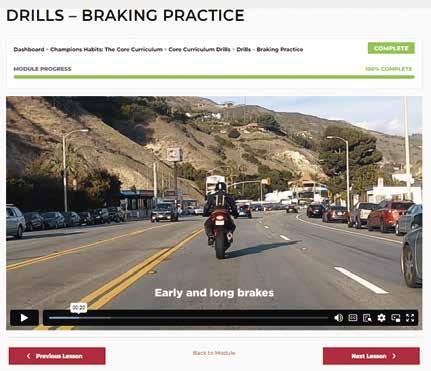
January/February 2024 | BMW OWNERS NEWS 83
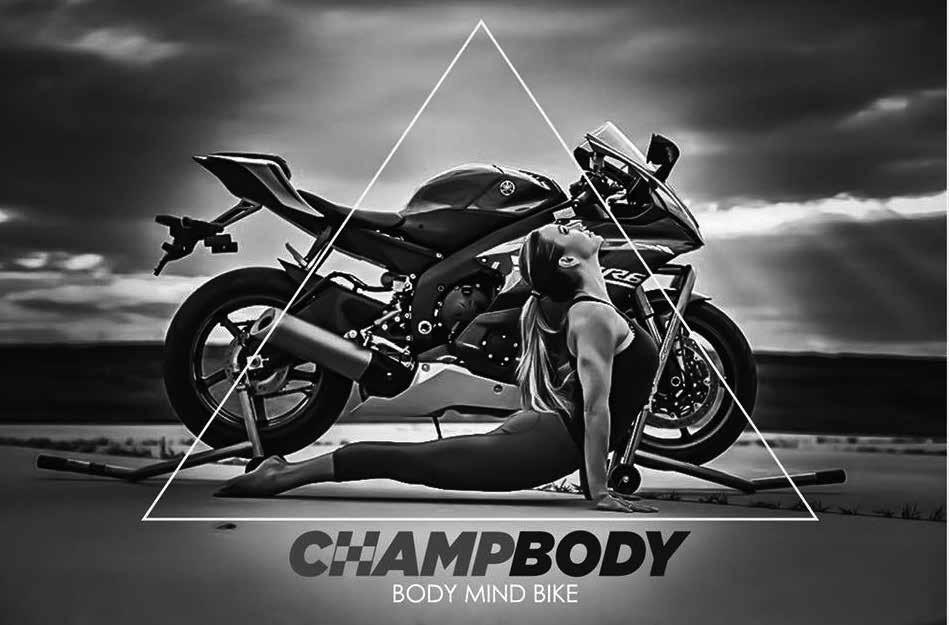
How Is Your Riding Fitness?
By Tami Bakke #222479
I got my first taste of operating a motorcycle behind the bars of a 2011 Ural Retro. Doug sat in the sidecar, ran through the controls, and gave words of encouragement while attempting to hide his white-knuckle grip. After I developed some familiarity with the timing required to operate the shift lever, clutch and throttle in concert, we went for several revolutions of an empty church parking lot.
Traveling in a clockwise direction, the tight right turns and increasing speed caused the sidecar to take flight. Landing the rig successfully without injury to Doug, the bike or I was thrilling, and I knew I was hooked. Soon after, I took an MSF beginner course, bought a used 2003 Triumph Thunderbird and fell willingly down the rabbit hole.
Today and nearly eight years since that first ride, I am continually reminded of how making adjustments to habits on
and off the bike can contribute to safety, proficiency, and my overall enjoyment of riding.
One such adjustment has been to my fitness routine. It sometimes surprises non-riders that motorcycling at any level beyond short trips between local beverage establishments requires a decent amount of muscle tone and more than a minimal amount of stamina. However, the regular rider understands that physical and mental strength and conditioning are necessary, especially when navigating sketchy surfaces and low traction environments.
With my current motorcycle, an R 1200 GS with which I routinely try to push my personal limits, the need for greater physical strength and cardiovascular fitness is ever present.
With a goal of improving my riding technique through increased physical conditioning, I searched for exercise
BMW OWNERS NEWS | January/February 2024 84
strategies related to riding. As I was also preparing for a track day with Yamaha Champ School, I checked out their ChampBody, part of a growing catalog of online curriculum offered through ChampU and available at ridelikeachampion.com.
My hope was that ChampBody would provide a series of workouts geared toward the development of targeted muscle groups, such as legs and abs, that would help me develop strength and stamina needed for technical riding and the occasional opportunity to practice picking up my bike. I was not disappointed, and I also found a lot more.
The modules, developed by Jennifer Peris and Dr. Matthew Tolstoy (both riders and health and fitness professionals) with demonstrations and commentary from racing champions Chris Peris, Eziah Davis and Nick Ienatsch, start out by making the connection between physical and mental fitness and how both affect the riding experience and operation of the motorcycle. It is highlighted that when the body becomes fatigued, the mind begins to lose focus. When focus deteriorates, mistakes are more likely to be made.
Care is taken to detail the body mechanics of riding, including demonstrations of body position and explanation of the muscle groups and flexibility required during the course of a ride. The discussion then moves to physical fitness, flexibility and mobility, and breathing techniques.
Next, Dr. Tolstoy guides the viewer through a set of guidelines for performing a self-assessment. This is where the rider learns how to evaluate their current state of flexibility and mobility in order to create benchmarks and identify areas for individual improvement. I’ll be visiting this section at regular intervals in the future to check in and mark my progress.
Chris Peris and Nick Ienatsch then take the viewer through stretches designed to relieve discomfort and keep the circulation going during extended periods of riding and while stopping for gas.
Then it’s back to Jenn Peris and Dr. Tolstoy for a series of workouts designed for improving conditioning while off the bike. It’s easy to view the videos from my phone, so I can reference them at home, at the gym, or while traveling.
The course concludes with information and strategies regarding nutrition,
hydration, and sleep, all of which can affect a rider’s ability to focus the mind and maneuver the motorcycle.
As riders, small adjustments can result in big consequences. As I work toward greater proficiency on the bike, I’ve found that my personal focus and fitness continue to improve as I seek out professional guidance, practice solid technique, and work on my physical and mental conditioning.
If you’re looking to dial in your physical and mental fitness, both on and off the bike, check out ChampBody for inspiration.

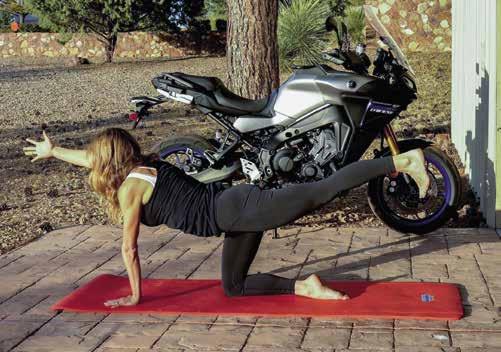
January/February 2024 | BMW OWNERS NEWS 85
ChampBody provides a series of workouts geared toward riders to develop strength and stamina necessary for technical riding.
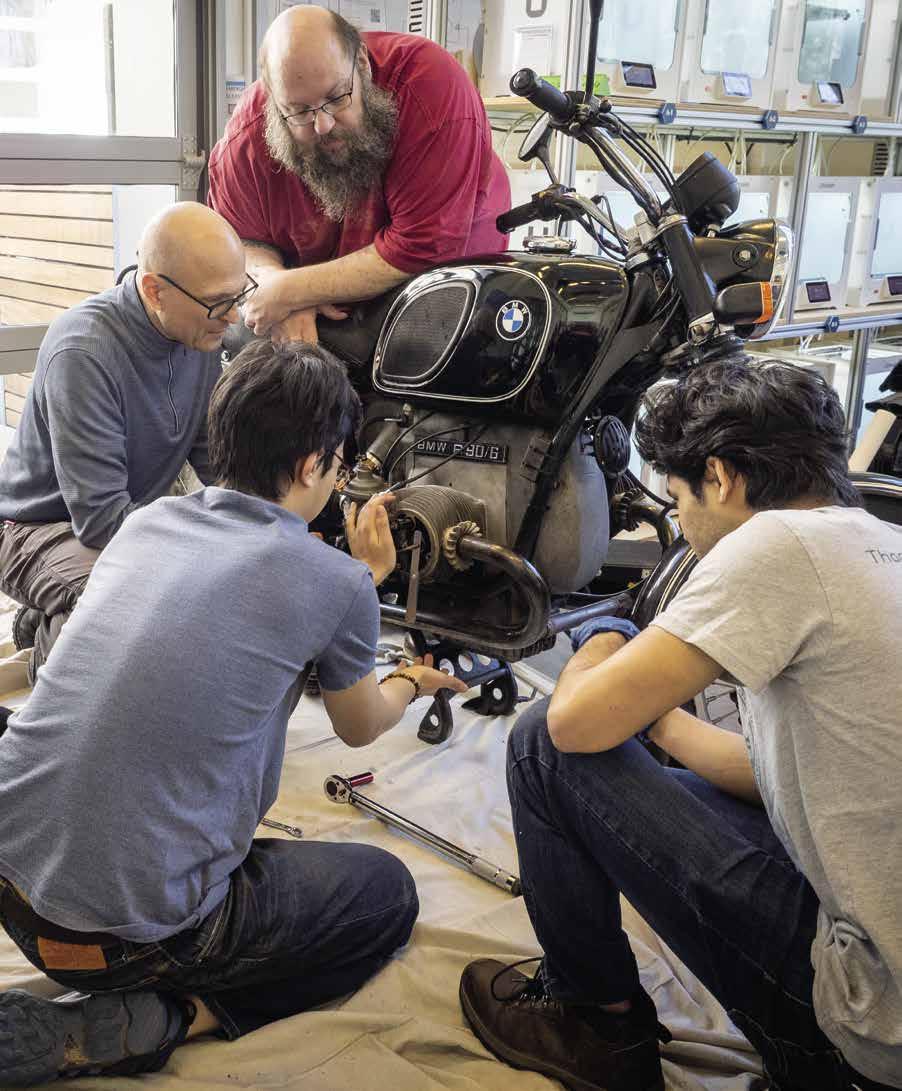
Motorcycle Revival at Duke University
By Wes Fleming #87301 & Scott Lindroth #222922
Photos by Bill Snead
Perhaps there’s a little moto-cultural myopia going on that causes us to consider “motorcycle training” as something that only involves actually riding the motorcycle—learning to do it or getting better at it. Learning how to work on your motorcycle is also a valuable skill, and one that is quickly and easily developed with hands-on instruction.
Scott Lindroth spends the vast majority of his days teaching the intricacies of music composition to graduate students at Duke University. When spring break rolls around in March, he usually uses that week to relax, work on some of his own compositions or tend to his house and family. In 2023, however, he had an idea on how to get folks excited about motorcycles in a unique way—by having them do his routine maintenance for him!
All kidding aside, Scott saw Duke’s “Spring Breakthrough” program as a way to share his passion for motorcycles and wrenching on them with students who were unable (or unwilling) to get away from the Durham, North Carolina campus. Duke offers informal projectbased weeklong courses to help these students pass their time constructively, if they so desire, and after writing up a proposal and sample syllabus, Scott got the green light to offer his “Motorcycle Revival: Repairing and Maintaining a Classic Bike” course.
“One of the things I love about teaching music is that it requires practical, hands-on skills—I play piano—as well as technical and historical knowledge. I can almost convince myself that working on a bike is analogous to my work in music. I suspected students were hungry for experiences that put them literally in touch with the physical world—something fun, satisfying and indisputably cool that would also allow them to experience the outcome of their work,” Scott said. “I thought of Motorcycle Revival as a way to share my way of thinking with students and convey the joy—and frustration—that comes from focused work on problems both large and
small. What could be better for that than wrenching on an antique motorcycle?”
Scott even had the perfect bike in mind: the 1975 R 90/6 he purchased from me in 2022. The R 90/6 dates from an era when BMW Motorrad assumed a bike’s owners would do their own maintenance, and its owner’s manual has instructions for valve adjustments, cable replacement and adjustment, fork oil changes, carburetor adjustment, master cylinder repair and other jobs often relegated to professional service centers today. It even includes a detailed wiring schematic as well as exploded diagrams for the carbs, clutch and gear box. It was a different time.
Looking back at this different time in motorcycle manufacturing is a big part of why Scott bought the bike. He’d been riding for about six years at the time, but he was as in love with riding as any of us who ever wanted to get into bikes more deeply. The airhead was the perfect vehicle to accomplish his goal. He spent most of his free time in the summer—when he wasn’t riding his beloved Triumph T120 Bonneville, that is—working on the R 90/6, starting with rebuilding the forks, front brake caliper and master cylinder. He installed a headlight and turn signals, fixed exhaust leaks, rebuilt the carbs and adjusted the valve clearances. It was his entry into motorcycle repair, and he loved every second of it.
For the spring break course, Scott enlisted the help of myself as well as his friend and colleague, Duke staff photographer Bill Snead, who brought in his 1981 R 65 for students to work on. Both Scott and Bill also added their late-model Bonnevilles to the mix to ensure everyone would be busy.
“In a high-stakes academic environment, it’s often difficult to get students to risk failing at something new, which of course can be a great way of learning,” Bill said. “The general level of excitement for the material, the willingness to get hands-on, the attentiveness, the level of questioning—all this was encouraging for me. This class kind of took [the students] out of their comfort zones, but in a way they all seemed to enjoy.”
January/February 2024 | BMW OWNERS NEWS 87
Scott Lindroth (far left) instructs students Ravi Jain and Rithik Castelino as Wes Fleming looks on.

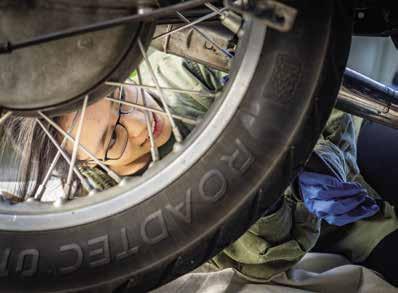
An unexpected element of drama arose shortly before the course was to start: The R 90’s clutch suddenly failed. Scott spent a frantic week replacing the plates and the clutch release mechanism and got the bike running again the day before the class started. So much for his idea that wrenching is relaxing!
Six students signed up, three from India, one from Ethiopia, one from Japan and one from nearby Cary. Most of the students had never held a wrench before, and three of them do not even drive. They spoke of wanting to “work with their hands,” to “gain some life experience” and to “try something completely different.” Of course, they all thought “motorcycling is cool, but a little scary.”
The class set up shop in the Makerspace at Duke’s Rubenstein Arts Center. The facility has two roll-up doors, making it easy to move bikes in and out, as well as large worktables where tools, fluids and parts stayed organized. An adjacent classroom was an ideal space to pore over Clymer manuals and watch parts of some terrific Boxer2Valve videos on YouTube to better understand each task.
Over the week, the students performed routine maintenance chores such as replacing fluids and filters, checking and replacing brake pads, bleeding brake lines, cleaning and adjusting the chain on the Bonnie, and adjusting valve clearances on the two airheads. Scott had the students remove and reassemble wheels and exhaust silencers to help them become more familiar with the bikes, and what impressed me most was how eagerly these elder teenagers and young 20-somethings dug into each task, unconcerned even with whether they might get dirty.
“It’s not a stretch to say that not only have the students not used or owned a lot of tools, but it’s likely their parents haven’t, either,” Bill said. “For many, just learning ‘righty-tighty, lefty-loosey’ was an important step.”
Scott added, “They were into it; they were respectful, humble, even self-deprecating, and funny. It was clear this was an entirely new experience for them.”
I missed the animated discussion of Matthew Crawford’s book
Shop Class as Soul Craft, which advocates working with hands and tools not only as an honorable alternative to the “knowledge work” dominating university curriculums, but also as an endeavor requiring critical thinking and analysis on top of manual dexterity. We took in videos by moto vloggers “Itchy Boots” and “Doodle on a Motorcycle” to expose the students a variety of riding styles, ranging from Itchy Boots’ hardcore off-road adventures to Doodle’s evolution from a novice buying her first bike to an experienced touring motorcyclist intent on widening her own knowledge. Their channels also make it clear that motorcycling is not just a man’s endeavor.
“The conversations around the videos and book excerpts, and even when relaying our own riding experiences, were thoughtful and refreshingly challenging as well. One student wondered about the consequences of putting the wrong fluid in a particular system,” Bill said. He also noted how well all the students responded to Itchy Boots (whose real name is Noraly Schoenmaker), Doodle, and Elspeth Beard.
To show more of the breadth of motorcycling experiences, I showed them footage from the first Motorrad Fest’s police rodeo and the semi-finals from the 2022 GS Trophy Qualifier at the BMW Performance Center. Bill shared his amazing story of setting a world land speed record at the Bonneville Salt Flats about 10 years ago. He purchased his R 65 with an eye on the 650 PPP title, and he showed the process of disassembling and reconditioning the engine along with footage from the Salt Flats during his successful record attempt.
All three of us noticed one student in particular, a young women from India, who really connected with the hands-on nature of motorcycles. “Early on, it was obvious she really saw how everything was supposed to work together, Bill said. “She did the valves on my R 65, and the bike never ran so smooth!” Bill couldn’t bring himself to re-do them after watching her complete the adjustments in one efficient stretch covering both intake and exhaust for both cylinders. “She really had the touch! I
BMW OWNERS NEWS | January/February 2024 88
Above, One Chowdhury, Cynthia Yan, Rithik Castelino and Ravi Jain work on a top end. Above right, Cynthia Yan works on the bike's exhaust. Opposite page top, Cynthia Yan and Umang Dhingra tighten a valve cover. Opposite page bottom, One Chowdhury is all smiles aboard the R 90.



need to track her down and see if she’ll do that again— maybe she’ll be on my crew if I return to the salt flats with the R 65.”
“It helped to get these young men and women to see that a motorcycle isn’t a black box,” Scott said. “Connecting their hands-on labor to the joys of riding a motorcycle was all part of the experience, and I think it really helped them get excited about motorcycling.”
Given that women outnumbered men in the course, it wasn’t hard to draw the conclusion that motorcycling is not only a man’s pastime, but that anyone can wrench and ride, even, as Bill calls himself, the “inseam challenged.”
During the week, students sat on the bikes, started them up and gave the throttle a few revs to whet their appetites. The final class ended with Scott and Bill giving two-up rides on the very bikes the students worked on all week; saying they loved it is understating their excitement. At least one was soon on Craigslist looking for a bike, and the others were smitten; Bill recalled that one of the students brought in an actual print magazine to talk about the Royal Enfield 350 Meteor, which he was considering for his first bike, showing how excited they were about the concept of riding.
After reflecting on the entire week, Scott said, “I wish I’d devoted more time to discussing Crawford’s book, and it would have been interesting to tackle a more complex project, like rebuilding carburetors. Maybe next time we’ll get a half-dozen carbs and do those!”
As far as Scott’s R 90/6 goes, “Mechanically it’s great, but I’ve been dealing with electrical gremlins,” he said. “It reminds me that if you want to dive into the deep end and take on major maintenance jobs, old bikes really are the way to go, provided you can get the parts. There’s a lot to learn, but everybody should be able to deal with tires, brakes, cables, filters, and the chain.”
Bill agreed, saying, “The best mechanic, even without any experience, will most likely end up being YOU! Most motorcycles make it comparatively easy to access the innards compared to cars, so the intimidation factor is relatively low. Anybody can start with basic tools from any big-box hardware store, and I cannot overemphasize the value of YouTubers who share how-tos and gracious forum members who share their experiences and tips, many of which they probably learned the hard way.
“There’s absolutely no reason not to go for it nowadays. Reassembling some vital and scary parts and then hearing your bike run—or not—afterwards is a huge reward, and such an important and satisfying human experience.”
A trio of old and possibly jaded Beemer fans figured there couldn’t be a better outcome from the course than teaching a small degree of self-reliance and possibly bringing new riders into the sport.
January/February 2024 | BMW OWNERS NEWS 89

BMW OWNERS NEWS | January/February 2024 90
Jennifer Ott and Marc Neville stop for a photo during one of their many adventures.
A BMW
By Mark Thompson #218859
It’s a cliche that some of us were seemingly born to be motorcyclists. Sometimes, if we’re especially lucky, we meet someone special who shares our fascination and utter involvement with these two-wheeled wonders.
In the case of Jennifer Ott and Marc Neville, it was BMW motorcycles and the MOA that brought them together. If not for BMWs, they probably would never have met.
As Jennifer tells her story, she’s been riding since she was in her teens in 1982 after passing her motorcycle riding test. Motorcycles are in her blood, with fond memories of riding with her father on his Suzuki GT750 “water buffalo.” Over the years she has owned many different brands and types of motorcycles, but it wasn’t until 2017 that a BMW entered the picture.
“I was told that if I went and bought the BMW, that I should move out. I thought about it for a moment and then I said ‘okay,’ and the rest is history.”
To celebrate leaving that relationship, she purchased a new BMW 2017 G 310 GS sight unseen in November 2017, then proceeded to ride the wheels off it while traveling all over the Canadian Ontario province she calls home. The 310 GS was actually one of Jennifer’s smaller motorcycles, since she has owned (or still owns) a Suzuki RG500 Gamma, Honda 750 Interceptor, Honda CB900 and a Yamaha TZR250 roadracer that her daughter now races. Jennifer obviously loves the G 310 GS and halfway through my interview with her, she had convinced me I needed one in my garage. Her enthusiasm is contagious.
BMW, and encouraged by other BMW owners, she joined her local MOA club in Ontario, Canada, in February 2018. She was soon heavily and happily involved in club rides and road trips.
Jennifer was also very active on social media, talking about her rides, the MOA, and BMWs in general. It was on Facebook in 2018 that she first met Marc Neville, and it wasn’t long before they were regularly exchanging messages. Marc is another BMW rider, based in Detroit, Michigan. “I am owner and president of Neville Financial Group, Inc. (nevillefinancial. com), and I started riding on May 7th, 2006,” he said.

Hours apart and in different countries, Marc and Jennifer began discussing meeting up to go for a ride.
The first time they met in person was when Jennifer proposed a trip to the 2018 Finger Lakes rally (now sadly gone, a victim of the pandemic). They rode separately to the rally, Jennifer on her 310 GS and Marc on his K 1600 GTL. Once there, and to get into the rally, Marc jumped onto the G 310’s pillion seat as Jennifer had the passes.
That event was the official start of their relationship. Later that year they rode their bikes to Arizona, and Jennifer soon won the MOA’s Annual Mileage Contest after accumulating 32,015 miles on her GS 310.
In February 2019, they made things easier for themselves when Jennifer joined Marc in the Detroit area. She retains her Canadian friendships as 2019 included a trip to Barcelona Spain, France, Andora, and the Pyrenees with Marc and her BMW Club of Ontario.
Going back to the beginning, as part of her new life with a
January/February 2024 | BMW OWNERS NEWS 91
In 2021, as we emerged from the shutdown year, they rode to the National Rally in Great Falls, Montana. Jennifer also was elected president of the BMW Touring Club of Detroit (TCD as they say) and was recently re-elected for a second term.
It’s understandable that BMW MOA plays a big role in their relationship. It’s where and how they met, because as she says, “MOA is such a great community. So friendly and most important, there’s always somebody to ride with!”
The BMW Touring Club of Detroit holds MOA Club Charter #1, and members meet every week. The club hosts a great number of rides throughout the year, including their annual Edmund Fitzgerald Run in early November, to commemorate the 1975 shipping disaster and loss of life. (If you’ve ever listened to Gordon Lightfoot’s song, you know the tale and can probably sing it.)
In 2022, Jennifer and Marc rode to the MOA Getaway in
Fontana, North Carolina, (the 2024 date is April 19-24), where Jennifer was named an MOA Ambassador.
“That took me completely by surprise,” she says, but if you ever encounter Jennifer, you’ll immediately realize why she was chosen. She bubbles over with enthusiasm about MOA and BMWs. She always has a welcoming smile and a deep knowledge of all things motorcycle, but especially BMWs.
Also in 2022, she placed second in the MOA’s Annual Mileage contest, covering 26,652 miles, which included her ride to the MOA National Rally in Springfield, Missouri, preceded by a roundabout route through the eastern USA. In all, it was as Marc says, “Fifteen states in 14 days.”
One international trip in 2023 was special. As Jennifer tells it, “We flew to Ireland and rented an R 1250 GS and rode 1,800 miles over 14 days around the entire coast of Ireland. On May 14th in Westport, Ireland, my family’s ancestral home,

BMW OWNERS NEWS | January/February 2024 92
Jen and Marc riding the Tail of the Dragon.
we got engaged. We were surrounded by my mother, my Irish cousin and 11 members of our BMW Touring Club of Detroit and BMW Ontario Club members.”
Marc and Jennifer ride constantly, with many weekends on the road, exploring by motorcycle new and familiar places, as well as internationally.
All of that experience comes in handy, as she is the Sales Manager at BMW Motorcycles of Detroit. She asks customers if they are MOA members, and if not, gives them a card good for a free year’s membership.
As she says, “It’s so easy to link the two things together. A new BMW and entry into a great organization. I’ve given away hundreds of these to customers because it’s a great gift. Being in sales is a great way to promote MOA.”
Both Marc and Jennifer volunteer at the MOA National rally, plus other events. For the upcoming 2024 National Rally in Redmond, you’ll find Jennifer chairing the Social Media group, helping to keep everyone updated as to what’s going on, while Marc will be the Rally’s Safety Chair.
Despite living in Michigan, a state with plenty of snow and lots of low, low, low wintertime temperatures, Jennifer rarely resorts to parking the bike and taking her car. She received a lot of attention this past December as she transported her Christmas tree home on–what else–her GSA’s luggage rack.
Marc and Jennifer’s main rides are R 1250 GS Adventures–his a 2019 and hers a 2020. They confess to having at least nine motorcycles in their garage. When asked what her average mileage is per year, she said, “Around 25,000 miles this year” while Marc added, “27,000 last year and 30,000 the year before and 32,000 in 2018.” They clearly love to ride and are always looking for new destinations to visit together.
We tend to think of motorcycles as life-enhancing in the most positive ways, and they can indeed be a life-changing catalyst, as Jennifer and Marc discovered. Motorcycles empower our life journeys, and I can’t think of a better recommendation than that to answer the question of why we ride.

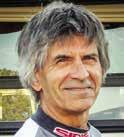
Riding and writing, that’s Mark. As a writer, his first published story was about a local Wisconsin motocross race while still a journalism student at the University of Wisconsin. Mark has been a contributor, editor and publisher for a wide variety of motorcycle magazines and online sites, in between 13 years at Readers Digest. There’s 40+ years of racing motocross, numerous transcontinental motorcycle trips on many different bikes, a deep involvement in the motorcycle industry and multiple books. He makes his home in the Cincinnati area these days and rides a ‘22 R 1250 GS A after stints on a K 1600 GTL and an F 850 GS won at the Great Falls National Rally in 2021 (he definitely should have written about that!).
January/February 2024 | BMW OWNERS NEWS 93
Bringing home the Christmas tree on Jen's GS.
PRESERVING THE PAST
WITH AN EYE ON THE FUTURE
By Bill Wiegand #180564
It’s a dream more than 25 years in the making.
In 1997, after a meeting of BMW club presidents at the BMW MOA International Rally in Fredericksburg, Texas, Clark Luster approached then BMW MOA President Jeff Dean about creating a tax-exempt foundation for motorcycle enthusiasts. Clark’s dream was that motorcyclists would appreciate the opportunity to make taxdeductible gifts to an organization dedicated to advancing rider safety and education. Dean agreed.
The following year, Clark formed a task force to create a national educational facility that would provide rider training and promote programs for new riders emphasizing youth, women, and minorities. The facility would also include a library, archives, and museum surrounded by beautiful roads and riding opportunities.
In January 2000, with necessary licensing agreements finalized and approved by the BMW MOA Board of Directors, the BMW MOA Foundation received its taxexempt approval. Since that time and through the efforts of many volunteers, the MOA Foundation has become the fundraising arm of the MOA responsible for generating funds supporting the organization’s goal of providing top-notch rider training and education.
With this first part of Luster’s dream now a highly successful reality, the MOA’s move to Greer, South Carolina, several years ago provided the physical space for the installation of a historical archives not only close to the BMW Performance Center Rider Academy but close to the beautiful roads of the Great Smoky Mountains. Located on the floor above MOA offices, construction of the Foundation’s Historical Archive began in January of 2023.
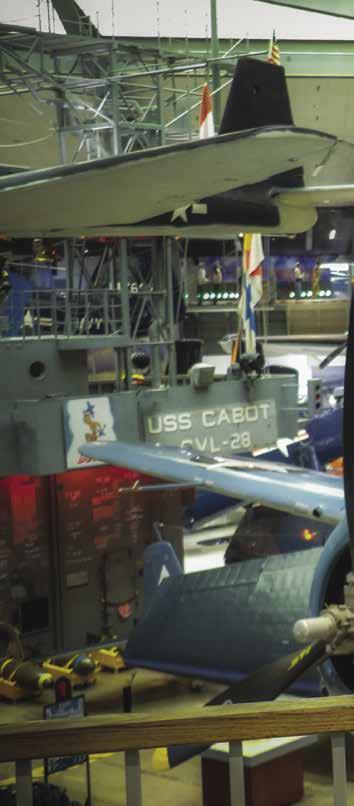
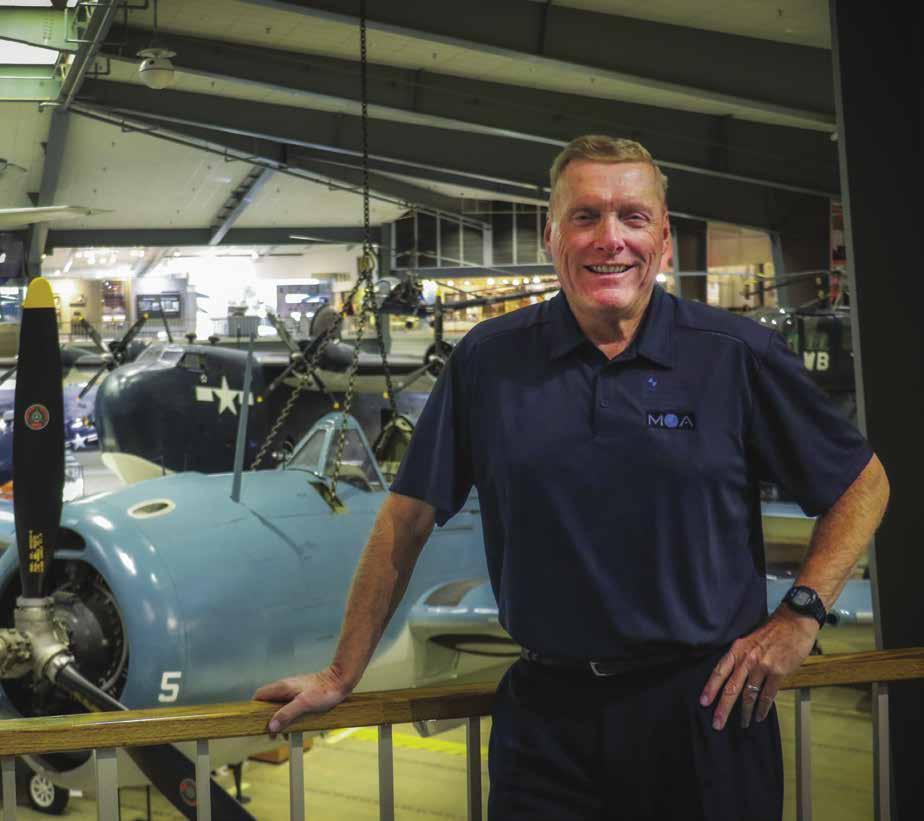
January/February 2024 | BMW OWNERS NEWS 95
Marty Martin at the National Naval Aviation Museum in Pensacola, Florida, where he works as the Executive Director of the Naval Aviation Museum Foundation.

Marshall “Marty” Martin bought his first motorcycle in 1983 and rode for about a decade until a growing family and career had him park his bike until 2009. In 2015, with a new BMW RT, Marty joined the MOA and soon after, the BMW Motorcycle Riders of the Emerald Coast based in Pensacola, Florida. A retired naval aviator, today Martin works as the Executive Director of the Naval Aviation Museum Foundation, supporting the National Naval Aviation Museum operations. Looking to get more involved with the MOA Foundation, in 2020, he began volunteering his time and talent supporting the planning and development of the MOA Foundation’s Historical Archive. A year later, he was asked by Foundation President Tom Gary to join their board and lead the effort to build the Historical Archive.
“A lot of what we’re doing here every day translates well to what we’re trying to do at the MOA Foundation with the Historical Archive,” Martin said. “Working with a group of people on the MOA Foundation, with a common interest in motorcycling, is a lot of fun. One of the biggest reasons I’ve enjoyed motorcycling is the camaraderie shared with people from all walks of life and different backgrounds.”
As construction of the facility continues, Martin has been working on
creating a formal collection policy and wants to have a framework for the way the archive works so that they don’t become just another motorcycle museum that doesn’t tell the story of the bike and its rider.
“I speak from my experience at the naval museum where we have one of the finest collections of naval aircraft in the world, but we do a terrible job of telling the story of naval aviation. We have a lot of cool airplanes, and that’s where it stops. I don’t want us to be that way. I want to use technology where a guest can walk up to a display, scan a QR code with their phone and then learn about that bike and its rider,” Martin said.
Martin’s goal is to create displays going far beyond the technical aspects of the bike, such as its cost, top speed, and horsepower.
“That’s OK if that’s what you want, and there is a group of people out there, and that’s all they care about. But there’s a greater group of people who want to relate to that motorcycle through the people who rode that motorcycle,” he said.
Currently, the Foundation owns nine motorcycles that have
BMW OWNERS NEWS | January/February 2024 96
A Pacific Island Airfield display at the Naval Aviation Museum in Pensacola, Florida.

been donated or purchased. One is a low-mileage 2003 R 1100 S Boxer Cup Replika. Martin’s vision is to take a bike like that, position it on a stand surrounded by a racing background, and use the display to tell the story of the bike and those who rode it while also allowing MOA members to contribute by telling their own experiences with the bike.
A bike Martin has his eyes on displaying is Benka Pulko’s 1997 F 650. Pulko is a Slovenian world traveler who, between 1997 and 2002, rode across 75 countries and all seven continents while making many friends and experiencing countless adventures.
“With special bikes like that, we want to tell the story of that person and that bike. In Benka’s case, both have a great story to tell,” Martin said.
Martin said none of the Historical Archive’s displays will be permanent and believes rotating bikes in and out would keep things fresh and that different bikes tell different stories. In addition to the motorcycles on display, events like the National Rally, along with Chartered Clubs and members, things that have
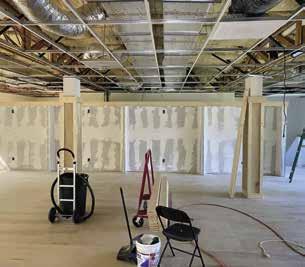

helped shape the MOA, would also be highlighted.
Another use of the Historical Archive would be as an event space hosting meetings and special events.
“If we put our visionary glasses on, if a BMW-riding couple, for example, wanted to get married, what better place than the MOA Foundation’s Historical Archive!” Martin said.
Currently, as former MOA Executive Director Bob Aldridge works to complete the build of the facility, targeting a March 2024 completion date, and Tom Gary and Dan Finazzo are building stands and displays, Martin is creating an inventory of the artifacts the Foundation has on hand.
As a volunteer organization built upon the backs of many volunteers, MOA members can support the Historical Archive through their financial support, donating or loaning motorcycles and related artifacts, or simply telling their personal stories. Additionally, volunteers are still needed to help complete the Archive buildout or assist in cataloging artifacts.
 Clockwise from top left, Within the new MOA Foundation Historical Archive as renovations continue. Right, An R nineT GS sits on a stand within the Historical Archive. Bottom left, Some of the MOA volunteers who stepped up to help with the Historical Archive build.
Clockwise from top left, Within the new MOA Foundation Historical Archive as renovations continue. Right, An R nineT GS sits on a stand within the Historical Archive. Bottom left, Some of the MOA volunteers who stepped up to help with the Historical Archive build.
In 1997, at a meeting of BMW club presidents at the BMW MOA National Rally in Fredericksburg, Texas, Clark Luster (#36336) approached then BMW MOA President Jeff Dean about the possibility of creating a tax-exempt foundation for motorcycle enthusiasts. Clark’s dream was that motorcyclists would appreciate the opportunity to make tax-deductible gifts to an organization dedicated to the advancement of rider safety and education. Dean agreed.
Foundation’s mission to improve rider safety, education and training. For three days, Don worked from nearly open to close and delivered his pitch to anyone who would listen. His goal was modest, hoping each member who heard this appeal would throw a few bucks in the hat to support the Foundation.
Don convinced MOA members to donate $446 to the Foundation in 2012. In 2019, BMW MOA members donated $13,480 at the rally and made pledges for an additional $19,921. Those pledges were the last piece of the puzzle for what became the SafeMiles Endowment. Another former MOA Foundation President, Chuck Manley, was at the forefront of the effort in 2019.
A Brief History of the MOA Foundation and the SafeMiles Endowment
The next year, Clark formed a task force with the goal of creating a national educational facility that would provide rider training and promote programs for new riders, emphasizing youth, women and minorities. The facility would also include a library, archives and museum and would be in a location surrounded by beautiful roads and riding opportunities.
In January 2000, with the necessary licensing agreement finalized and approved by the BMW MOA Board of Directors, the BMW MOA Foundation received its tax-exempt approval, and since that time and with the help of many volunteers, the MOA Foundation became the fundraising arm of the BMW MOA responsible for generating funds to continue the organization’s goal of providing top notch rider training and education.
Former MOA Foundation President Don Braasch stood quietly by himself at the Foundation booth during the 2012 National Rally in Sedalia, Missouri. It was one of the first organized efforts to raise awareness for the Foundation, and Don believed MOA members would respond to the
“Our first raffle effort was nearly ten years ago, and the Foundation has used those funds to provide important rider safety initiatives like our Paul B. [Grant] program,” Chuck said back in 2019. “If we had started the SafeMiles Endowment at that same time, we would have a milliondollar nest egg today to fund our training efforts forever.”
“Fifteen MOA members have stepped up and committed long term donations to get the fund off the ground,” Chuck continued, “We have commitments for $150,000 in donations toward the million-dollar goal, but we’ve tried to make it very easy for MOA members to donate at any level.”
The first donor to the SafeMiles Endowment was Don Braasch. Most people didn’t know it at the time, but Don had been diagnosed with cancer and was in the middle of treatments during the Sedalia rally. He stood in the booth each day, usually working alone, shaking hands, smiling and explaining the virtues of the Foundation to anyone he could. He was exhausted at the end of each day, but he never complained or failed to report to “work” the next morning. The effort meant that much to Don, and he believed that MOA members needed to see the efforts of the Foundation.
After the Rally in Sedalia, Don wanted to show other members he was fully committed to the future of the Foundation, and he designated the Foundation as a beneficiary of his life insurance policy. The Foundation Board recently voted to make Don’s posthumous gift the basis for the SafeMiles
BMW OWNERS NEWS | January/February 2024 98

Endowment to honor his efforts and recognize the difference he made.
MOA Executive Director Ted Moyer said, “Creating $150,000 in annual funding seemed like a pipe dream in 2010, but we managed to make it reality. In ten years over 3,000 riders have received training with some form of subsidy.” Moyer continued with hard numbers: $50,000 in Paul B. Grants and $29,000 in subsidies for event training at the BMW Performance Center and at the MOA National Rally—and that was just for 2019.
Ted continued, “Creating a $1,000,000 fund seemed crazy, but maybe it’s no crazier than selling 1,000 raffle tickets was ten years ago. We started with a simple thought and developed that into a viable fundraising model. Why can’t we do the same over the next ten years on a larger scale? After starting the SafeMiles Endowment with commitments for $150,000, suddenly crazy didn’t seem quite so crazy.”
This is just the tip of the kickstand, so to speak. The
Foundation continues to work hard to secure key, long-term pledges and they back their efforts with donations of their own. The SafeMiles campaign is rolling out throughout the summer, and it will be an ongoing initiative of the BMW MOA Foundation. The Foundation, and by extension, all SafeMiles donors, are committed to the mission of improving rider safety, education and training and the larger goal of creating the SafeMiles Endowment for the future. The SafeMiles Endowment is a special opportunity to shape the future of motorcycle rider safety, education and training. I encourage you to visit the Foundation website for more information and consider donating. As Don Braasch proved to us all, a few bucks in the collection plate could significantly change the lives of BMW motorcycle riders forever.
Visit the Foundation’s website at bmwmoaf.org to learn more about the SafeMiles Endowment and how you can help. All levels of donations are accepted, and you can pick up some SafeMiles swag along the way, including automatic entry into our raffle promotions.
January/February 2024 | BMW OWNERS NEWS 99
CHAMPIONS

Robert Aldridge
Keith Bishop
Mike Bitschenauer
Gary Blakney
Don Braasch
Warren Brownell
Joseph Burns
Simeon Chow
Lee DeYoung
David Dunn
Bill & Virginia Duran
Edward Eagle
Muriel Farrington
Roy Ferguson

John Fromhold
Sam Garst
Thomas Gary
Vance Harrelson
Bob Henig
John & Kate Lammers
Richard Lewis
Clark Luster
Chuck Manley
Julie Manley
Marshal Martin
Steve Martin
Ted Moyer
Marc Neville
Walton Rogers
Marc Souliere
Fritz Spokas
Tim Steenhoek
Jack Wells
Tom & Pam Werstler
BMW Club of Northern California
BMW Motorcycle Club of Dallas/Ft. Worth
BMW Motorcycle Owners of America
Bob’s BMW Motorcycles
MOA Foundation
DONATION LEVEL
BMW OWNERS NEWS | January/February 2024 100
$10,000
CLARK LUSTER
By Wes Fleming #87301
Since both Greg Beck and David Dunn mentioned the Foundation’s program named after Clark Luster, we thought also profiling Clark was a good idea. “I’ve had enough good P.R.,” Clark insisted, “and I want to talk about the other people who worked hard for the Foundation.”
Clark (#36336) has been an MOA member for a long time, having only missed one rally since 1986—Oshkosh, Wisconsin, in 1993—because his wife was in the hospital at the time. He joked staying home that year is how he got to go to every rally since then. His love of motorcycling started before that, though, and it was pervasive from an early age.
“I was four years old in 1948 and I lived on a hill in east Nashville,” he said. “At the bottom of the hill was a Triumph dealership. I would stand in the front yard, and the mechanics would hit third gear right in front of my house. So I’ve been at it a long time!”
His first BMW motorcycle was a 1977 Slash 7, purchased from a friend in Nashville; it was the bike he rode to the 1986 rally at Laguna Seca, and he rode it on the race track there. With over 600,000 miles on BMWs under his belt, he recently ordered an R 1300 GS. “At our dealership, Eurosport in Asheville [N.C.], the guy said, ‘Don’t you know that you’re going to be 80 years old?’ and I said, ‘Yeah, yeah, what’s your point?’” Clark related. He took a moment to show off the stylish R 18-embossed belt buckle the folks at Eurosport gave him to hold him over until BMW NA sends out his 600,000-mile medallion, and he just loves it.
Clark’s time with the MOA started when he met a bunch of riders at a 24-hour motorcycle race, all from Youngstown, Ohio. “I call that my mother club; I still belong to YBMW. I have probably belonged to 15 clubs and right now I belong to the Knoxville BMW club and the Ashville BMW club.”
He has fond memories of his early stint with Youngstown BMW; he said, “It was kind of a poverty rider club. We didn’t take dues, and we called our rally the Un-rally. I think they all rode from rear tire to rear tire.”
Thanks to his long history as a rider, he’s seen two important trends in motorcycling. First, he talked about how much more reliable bikes are now compared to 30 years ago. “You used to go to a rally and at the entrance…we’re talking bikes falling apart, a guy lying on the ground to see what was wrong, what the noise was coming in, and you don’t see that anymore,” he said. He also cited the increased number of women riders, especially on BMWs, as another positive trend in motorcycling and mentioned how the BMW Owners News has come a long way from the mimeographed sheets he used to receive in the mail every month.
Clark was instrumental in the formation of the MOA Foundation, something he prefers to downplay as he tries to put the focus on other members who got it off the ground. He ran a huge children’s mental health operation for 27 years; it started as an orphanage financed by Andrew Carnegie with $1,000 in 1830 and by the time Clark was CEO, they had staff in eight states assisting children with all sorts of mental health issues.
“Miranda Scott, Jeff Bezos’ ex-wife, gave us $10 million, so I felt I had experience raising money,” Clark said. His experience

creating the foundation for his employer set him up nicely to become an early champion for the MOA Foundation, something he discussed during a seminar session at the Richmond Rally in 2023.
“I’m not necessarily mechanically inclined, I don’t have a jillion dollars, I don’t know much about technology,” Clark said, “but when I thought about what contribution I could make to the MOA, well, I know something about raising money and creating a foundation, a vehicle for the legacy of the next 50 years of the MOA.”
He started discussing his idea for a foundation with his riding pals in Pittsburgh, the home base for his employer. He was met with both encouragement and obstacles, saying some folks simply didn’t understand what he was trying to accomplish and perhaps saw it as a threat to the existence of the MOA itself.
“Jeff [Dean] was already gone [from the board] by the time we got the Foundation,” Clark said. “Paul Glaves came on, and he was very enthusiastic and was one of the ones who put the master key into the lock. But we had a two-day meeting in Pittsburgh and Jeff, bless his heart, came from Madison, Wisconsin, to be with us.”
Clark praised the other people involved at that early stage, including Roger Wiles and Don Douglas, both of whom have since passed away. Don’s wife Deb was on that initial committee. From that start, Clark was involved intensely for about four years, shepherding the early Foundation through its successful application for non-profit status with the IRS.
“I turned the keys over then,” Clark said. “I wanted it to be an
Clark Luster
MOA thing, and I wanted more participation, more involvement by the total membership. Roger Wiles became the president about then.” The committee’s dreams for the future included a dedicated facility to encompass high- and slow-speed training, both on- and off-road, as well as a delivery program for new motorcycles similar to what BMW now does with car deliveries through the Performance Center in Greer, South Carolina.
Clark said, “Voni Glaves, David Salento and Rebecca Hinn were riders with that dream. We worked with a guy named Steve Michaels who had the idea for an identification packet for riders because we went on a ride one day and one of the riders got hurt. He wrecked and we didn’t know his last name.” He talked about ideas both big—like the Performance Center-style delivery—and small, like an inexpensive ID packet every rider could carry. Though neither thing worked out in the long run, they show the breadth of ideas early Foundation organizers had.
“Dick Hautau, he’s ambassador number one, he’s from Detroit,” Clark said. “At the Midland Rally [2000], Michigan had a beer can deposit policy, you get a nickel for a beer can. I’ll never forget this guy, he went around all through the rally picking up beer cans and turned them in for the $75, then turned it over to the Foundation.”
Clark also mentioned Steve Johnson of Texas, whom many credit with starting the 50/50 ticket sales, which now benefit the MOA Karol Patzer Children’s Charity Challenge every year at the Rally. Clark said, “Steve did that for years, turned the money over to the Foundation to help pay our legal fees. He was just a guy who said, ‘Man, this is a great idea, I’m going to help.’ All those kind of people over the years gave us not only some money but gave us some encouragement, some air to make this thing work.”
At one point in our conversation, Clark paused to think, then said, “You know, I think the breakthrough came when Chuck Manley left being the president of the MOA and became the president of the Foundation. That was a major bonus and gave it a lot of credibility, legitimacy and weight.” Clark also mentioned the efforts of Ted Moyer, now the MOA’s Executive Director, and credited him for publicizing the Foundation’s programs and fundraising events.
Clark said, “I think [another breakthrough] was when the Vermont club rallied around the death of Paul Bachorz and that grant became available. It led people to think [they] could give money from their estate to the organization.
“I wanted to have people like that, like my friends in Youngstown, not just people who have a 401(k), to have a way to support the Foundation.” He talked about how many of us donate to our church or college, institutions that meant a lot to us during our life, and how the MOA means as much to him as those things do to many people. He also discussed an idea he’s been thinking about for a while, a way to donate a rider’s motorcycle, tools, even gear, to the Foundation when they decide to quit riding or pass away, calling it a possible way to “recycle” our motorcycles when we no longer need them and get them into the hands of younger riders.
Clark attended the races on the Isle of Man in 2023; he’s been 23 times now and plans to go again in ’24. He dreams of riding in New Zealand and of even retrieving a bike he’s been storing in a friend’s garage for five years—in Portugal.
“Anybody who’s been at this for a long time has friends all over the country, all over the world,” Clark said, crystallizing the experience of being an MOA member perhaps more succinctly than anybody else ever has. Then he invited me down to Key West, where he lives, for a beer.

DAVID DUNN
By Wes Fleming #87301
When David Dunn (#117435) joined the MOA in 2004, he had just purchased his first BMW motorcycle, a 2002 R 1150 RT, and heard about the national club through some people he knew.
“I rapidly joined because I wanted the magazine,” he said.
David started riding in 1974 as a way to get to his summer job as a lifeguard. “I bought this Yamaha 250, two-cycle with kick start. I upgraded a couple years later to a Honda 360T; that was the first year they went to disc brakes up front, and it had all of 34 horsepower.”
Even as a youth, he understood the importance of gear. It would have been easy to hop on his Yammie in shorts and flip-flops for the quick ride to the pool for work, but instead, he said, “I always wore a thick leather jacket and pants, and at least sneakers, sometimes even work boots. And I always wore leather gloves because I was afraid of tearing up my hands if I fell.”
David said, “I used the Honda to travel back and forth from upstate New York to New Jersey, where my parents lived, and after college I took that bike to New York City and kept it in a garage. It got knocked over so many times I finally sold it. Then I got married and put riding on hold for 20-something years. My next bike was that RT.”
Once he got back into riding, David quickly figured out he
BMW OWNERS NEWS | January/February 2024 102
David Dunn
didn’t know a lot about how to handle curves and other situations, which led him to taking the MSF Basic Rider Course. From there he started riding with friends and picking up better techniques by watching other riders and asking questions. The RT stayed with him for almost 100,000 miles and was replaced by a K 1600 GT in 2015. He called the K 16 a “cross-country rocket” and kept it until 2022, when he got a 2020 R 1250 GS Exclusive.
When he got his RT, the nearest dealer was just over the border from his home in Vermont, AJ Cycle in Gill, Massachusetts. “I would meet other BMW owners there and hook up with them for rides,” David said. “Then I got involved through them with the MOA. I went to the Essex Junction, Vermont, Rally and started to go to as many rallies as I could, for the experience and also to participate in some of the training events.”
“The farthest I ever went [for a Rally] was Montana two years ago. We went out from Pennsylvania and rode the Chief Joseph Highway and went to Glacier National Park. I separated from my buddies for a day and visited the cemetery in Greybull, Wyoming, where my grandparents are buried. We came back through the Dakotas and Wisconsin, probably about 3,000 miles round trip,” Greg said.
David’s most recent training course was Total Control, which he took at Pocono Raceway. He wanted to take a high-speed course focused on cornering, as he says due to his age—nearly 70—he struggles with slow-speed courses.
“My balance isn’t as perfect as it used to be, but one of the therapies for Parkinson’s is riding a bicycle. I asked my neurologist, ‘What about a motorcycle?’ and he said that would work,” he said. “I do a lot of that stuff, and it works, and at the rallies I’ll frequently sign up for the training programs, which tend to be slow speed. I run over enough cones to get them angry, but I enjoy myself.”
David’s professional background is in finance, and he’s served on boards for his local Habitat for Humanity and United Way, so he wanted to offer that experience to the MOA Foundation. “Under Tom Gary’s leadership, some of the things we’ve been able to do as a group allowed us to increase our training program grants,” David said.
He’s especially proud of the Clark Luster Program, described elsewhere in this issue. “We call them rebates now, and if you’re going to do a group training program, one person can apply for the entire group, then they get the rebate and disburse the funds to the group. We really like the Clark Luster Program because you train with your peers; there’s a camaraderie factor to it you don’t get from individually signing up for a training program.”
Another thing David and the entire Foundation board are proud of is the distribution of $97,000 in rebates through the Paul B. Program, which affords individual riders a rebate of $200 if they’re an MOA member or $100 if they’re not.
David has great hopes for the future of the Foundation. “We want to go well over a million and a half or two million [dollars] so it throws off at 5%,” he said. “Then we can fund those programs automatically, and we don’t need to have our hand out all the time looking for donations. Then we can also expand other things that will benefit rider safety. That’s our big goal—to look at what else besides training programs we can do to help riders. A lot of what I think our focus is going to be going forward is to get
training programs for younger riders.”
As for his future riding plans, David is planning a ride to Alaska after the 2024 Rally in Redmond. “We’re going to Skagway and Haines, then take the ferry to Juneau,” where his daughter and son-in-law live. “If you go up through Whistler on 97 it’s 2,000 miles. And you have to take the ferry because there’s no road to Juneau!”
GREG BECK
By Wes Fleming #87301
Greg Beck (#136296) says he was a typical motorcycle guy, starting as a kid on a minibike, then progressing to dirt bikes and eventually a Honda CB350. “I ran the wheels off them,” he said. “Then needed money, then college, then married and kids.”
It was the better part of two decades later when a friend bought a Honda Shadow Aero. “It was orange and cream, and you know, my interest in doing that was to see if it was just a passing phase or something that really never left me despite the gap,” Greg said. Discovering he didn’t really care for the seating position of the Honda, he noted, and a neighbor, MOA member Bob Vaughn, had a BMW, which piqued his interest.
Greg said, “It was a red RT, and it was like…man, I’ve never seen one of those!” He soon spied a 1999 pale green R 1100 RT on Craigslist. “I bought it and started hanging around Bob and another guy, Dennis, more, and they brought me to a Gulf South BMW Owners Club meeting.”

January/February 2024 | BMW OWNERS NEWS 103
Greg Beck
“It was small, maybe 10 or 15 people. Ken O’Malley was an MOA ambassador, a champion for BMWs and he kept talking to me about why I should join the MOA and encouraged me to try the national rally one time. Sure enough, after a couple rallies, I joined the MOA, and the rest is history.”
Even though Greg has moved on from his first BMW—he now rides a ’21 R 1250 GS—he’s never moved on from the MOA. As many of us know, being in the MOA means more or less being inundated with admonitions to get trained, and Greg wasn’t immune to those entreaties.
“Once I got in the BMW club and started listening to Bob, Ken, Alden Bienvenu, they talked about how they do training regularly, and that really caught with me,” Greg said. “Another member in the club took a RawHyde off-road course out west, and I think that was it. I saw in the MOA Forums and in the magazine about the Performance Center back when it was hard to get into a class. I went with my buddy Larry Terrell and took the two-day on-road course, that was my first formal training and it was like, THIS IS GOOD! I need to continue! Larry and I and two other guys from the club went back and did the motor officer class, and that was great. I found out how many cones I could knock down.”
Where Greg lives in Louisiana, riders can take advantage of a state police program for a one-day course. Alden, the club’s treasurer at the time, got information from the MOA Foundation about the Clark Luster Program, which provides a rebate to a club (or other group) who puts a number of people through a training program. “Ted Moyer told us how it works, and sure enough we sent 12 people through and applied for the grant. The check came in the mail about 45 days later, and it couldn’t have been easier.
“Our effort was to help people get trained because it’s just what we believe in as a club and in the MOA, but it’s really nice to have that benefit of a club activity. More and more people are starting to say, ‘Hey, you guys do more than just go to lunch.’”
Gulf South has another group training session planned for April 2024, and they plan to discuss it all with the Foundation and apply for another Clark Luster Grant.
TOM AND PAM WERSTLER
By Ron Davis #111820
Tom Werstler’s #(84761) history with BMWs began with a 1979 R 100 RT. His friend who had taught him to ride on a Honda 350 advised him to be on the lookout for a used BMW when he wanted to move up. Besides finding a bike he liked, he was also introduced to the kind of reverence BMWs often inspire in their owners. The bike was owned by an older rider who was nearing the end of his motorcycling days, and the bike was in pristine condition. The owner even took the time to show Tom how to place his hand on the tank when he pulled the dip stick so he didn’t scratch it. Tom was only allowed to take a test ride from the pillion seat, but at that point he knew the owner’s protective nature proved the RT had been well taken care of, and he bought it.
Tom was a firm fan of the marque by 1984, when he moved from

Ohio to Alabama. There, he had his first date with Pam, his future wife, riding the RT to Guntersville, Alabama. Pam said, “Needless to say, the date went off without a hitch because we later got hitched!” The couple are now on their fourth BMW and a second trike from Hannigan Motorsports in Kentucky. Tom’s second bike, a K 1100, was purchased from BMW MOA Executive Director Ted Moyer in Birmingham, Alabama. A gray K 1600 GTL trike named Smoky now resides in their garage, dressed out in a misty gray.
Pam said, “Probably our most memorable experience was riding Highway 1 down the coast of California. We were in Oregon for a Curve Cowboy Reunion event in Bend and riding ‘The 1’ was on my bucket list.”
When riding with Tom, Pam likes to carry a Canon camera and shoot from the back on all their excursions. “On the Highway 1 trip, I had two cameras, one with a telephoto and one without. Tom also had a GoPro in the front. We rode through the redwoods, over the Golden Gate Bridge and down to Monterey. It was a beautiful ride with beautiful weather!”
Tom and Pam joined the MOA in 1999 and have enjoyed going to the national rallies and various other MOA events. Over the years, Pam said they have been delighted to meet so many interesting people who share a love of riding. They agreed they also love the Owners News magazine for its high quality in both content and appearance.
Pam said she and Tom decided to begin supporting the MOA Foundation while she was serving as the Secretary on the Board of Directors and “seeing up close the good work that the Foundation does.” Pam and Tom concurred that rider training is extremely important to keep perishable skills honed. Tom said, “Often, we don’t know what we don’t know!”
Tom and Pam Werstler
BMW OWNERS NEWS | January/February 2024 104
BOB HENIG
By Ron Davis #111820
When I recently had the opportunity to interview Bob Henig, he, at one point, used the phrase, “hooked for life.” Listening to his life story and how intertwined it has been with motorcycles, namely BMWs, I couldn’t help thinking how true that was. Bob’s fascination with bikes began, like many of us, with a chance ride on a neighbor’s mini-bike, but once freed from his parents’ reservations about motorcycles, he started his path to becoming a rider, a restorer, a collector, the creator of a preeminent source for BMW parts and accessories, a dealer, and a devout supporter of the BMW MOA and the MOA Foundation.
Bob’s first BMW was a “barely running” 1972 R 75/R. Once he got the R 75 back on the road with the aid of a Clymer Manual, he began attending BMW rallies. “I joined the BMW MOA at the National Rally in 1979, my very first one. What a great decision that was. Looking at the thousands of BMWs in one location was literally overwhelming. It started to change my entire life, although I did not know that at the time. I’m confident had I not purchased that 1972 R 75/5 which I rode there, had I not met so many good people riding BMWs, and had I not spent some money with a few very good people who were also vendors, we would not be engaged in this conversation today.”
Apart from enjoying his first rally experience, Bob also saw a business opportunity. “I was a serial entrepreneur from an early age. I saw the need for a truly credible source for used parts and accessories for BMWs.” Bob’s Used Parts became that source. “I guaranteed everything I sold, could put my fingers on every item within a minute and never had a minimum dollar requirement so people could buy just what they needed,” Bob said. “I sold the nuts, bolts, washers, and small parts you get when you totally take apart a bike alongside forks, brake parts, engines, gearboxes, final drives, carbs, seats, all the other bodywork, and yes, even lots of good used rubber parts along with those used nuts, bolts, and washers.
“The concept took off quickly. Less than ten years later, after much arm-wrestling I accepted BMW of North America’s offer (before becoming BMW Motorrad USA) to become an authorized BMW Dealer. That is yet another good story with numerous twists for some other time. But what became Bob’s BMW still sells a lot of good used, guaranteed parts and accessories today around this continent and the world.”
As for his favorite kind of riding, Bob said, “It’s traveling in general. Most of it has been on solo adventures despite being the host organizer for some 18 or 19 European Tours with Edelweiss Bike Travel, Ayres Adventures, Moto-Discovery and a future Alps Adventure with Beach’s…My wife and business partner Suzanne has been my professional passenger on about 14 of those two-week European tours
and lots of riding in the states.”
“I urge everyone to join the MOA and have for decades. I share countless reasons but a few at the top of my list are being connected to the largest BMW Motorcycle Community on the planet, getting great information about events, rallies, rider education, gaining greater and wider view insights into the sport we love from some very smart people who just happen to also write columns for the Owners News magazine–in print or online, sharing your stories with others and especially being a part of keeping the BMW motorcycle world strong.”
Bob is also a strong supporter of the MOA Foundation. “The MOAF is important because this separate but connected organization is there to help spread the good word about BMW motorcycles and riding on another level from the MOA–getting the word out about doing good things in and outside the riding community, getting whole families involved, bringing in younger members and training more new and current riders are just a few of the very important parts of the big picture mission.

“I have long been an engaged and involved member of the rider community focused on improving and expanding the rider education arena. Long after I started riding, I took my first MSF Advanced Rider class because it was finally available. When I started riding, my friends taught me everything they knew, and they sure did not know enough. They never wore good, protective gear, but I did. I wanted to learn how to be a better rider, and my first weekend on Skyline Drive clearly told me that I still had much to learn, so I enrolled in other classes, too. I learned what to practice even when there was not an instructor on hand.”
“So yes,” Bob added, “training is very important and perhaps as the
Bob Henig is the owner of Bob’s Motorcycles (bobsmotorcycles.com) in Jessup, Maryland.
January/February 2024 | BMW OWNERS NEWS 105
number of other vehicles on the roads keeps growing and there are more and more ways for other vehicle operators to be inattentive, training is critical so that everyone who is starting or has been riding for years has the opportunity to improve their skills and truly learn how to become a skilled, fully aware, always practicing rider who is able to take evasive action when needed. While the MOA is not the only organization out there doing such things, they are helping to establish a better baseline, with more opportunities for more people than most. We are off to a great start, and I am honored to be a BMW MOA Ambassador as well as a member of the MOA Foundation and invested supporter of the Safe Miles Program.”
For a fascinating, extended version of my interview with Bob Henig, visit BMWOwnersNews.org.
JACK WELLS
By Ron Davis #111820
Jack Wells, a 2023 MOA Foundation Safemiles Champion, began his lifelong love affair with motorcycles at age 12 with the covert purchase of a three-wheeled Cushman with an Ice Cream vendor’s box on the front. “I would recruit buddies to ride along on the thing so we could push it out of the sand if we got into it on Tybee Island, Georgia, where I spent summers with my grandparents,” he explained.
Since that rather inauspicious beginning, apart from his career as a Navy then a commercial airline pilot, his 82 years have been filled with hundreds of thousands of miles covered on twowheeled and sidecar equipped bikes, hundreds of vintage BMWs he’s saved from decline, and years absorbing the history of BMW
motorcycles starting with his first, a 1960 R 60/6.
Jack and his wife have, in sections, ridden a BMW with a sidecar from Ushuaia, Argentina, to Prudhoe Bay, Alaska, and have traversed most of the lower 48 and many foreign countries like Australia. Though Jack is a fan of all BMW two-wheelers, he said when traveling long distances with his wife, he likes using a sidecar since only one bike has to be maintained. However, as I spoke with Jack, he was just between negotiating for a micro car and going to look at another addition to his collection of his favorite class of Beemers, those with just one cylinder.
Jack said his fixation with thumpers started on a layover in Phoenix. “I had a cousin there; he had a scrap pile, and I saw this motorcycle frame in it. It turned out to be a little R26 he had been riding in the desert, and he claimed it was ‘all clapped out.’ I bought it from him for a hundred bucks…and the seed was set.” Jack then progressed to acquiring and restoring vintage BMWs, and he’s still at it, maintaining a stable of close to one hundred bikes. Many of those Jack has personally trucked to rallies and gatherings where his restorations are often the stars of vintage displays.
Around 1974, Jack joined the BMW MOA. “I liked going to the rallies, especially those with vintage displays.” Jack credits members Vern Mitchell, Jim Falk, Bob Lonegan and Lee DeYoung as fueling his fascination with vintage bikes and sharing them with the BMW community. “I’ve always brought bikes for the vintage display; I can remember coming with a Freightliner tractor and a fifty-foot trailer with about 21 motorcycles in it. I did that several times, sometimes just bringing my singles collection of 16 or 17 bikes.”
While serving as a co-director of the vintage displays at BMW national rallies, Jack became interested in the MOA Foundation, to which he has been a financial contributor. As I have heard from other pilots, he finds training to be key to the enjoyment of motorcycling and to mitigating the risks that being a rider can entail.

“I’m very pro-training, especially for new motorcyclists, including older people who have finally gotten the chance to start riding. I’m for proper, professional training, and that’s why I contribute to the Foundation. If you can ride a bicycle, you can ride a motorcycle, but you’ve got to have training to know what’s going on…Motorcycling is a wonderful, wonderful activity and sport, but, like aviation, it has its risks. If you’re trained correctly, and you learn and you operate correctly, you’re going to have a good time at it. That’s why we need education. Most people are smart enough to understand this, but we need to emphasize this so we can keep our motorcycling community healthy and enjoying what riding has to offer.” Jack added that, like flying, there is always more to learn about riding a motorcycle safely. “When you get complacent, that’s the time to hang it up, sit on the porch, and remember all the good times you had on a bike.“
Jack Wells
BMW OWNERS NEWS | January/February 2024 106
$250 or more
William Andrews
Efrain Arteaga
Richard Ballo
Robert Baker
Tamara Bakke
Nicholas Bednarski
Tim Bernard
Patricia Blaskovic
Karl Boehm
James Bowen
Warren Bowers
Christopher Brown
Steven Brown
Arthur Buckheister
Glenlivet Burke
Joe Burns
Scott Carney
Andre Champagne
Adam Chandler
Michael Clayton
Simon Clement
Robert Cohen
Andres Cools
Bruce Davidson
Christopher DeRosa
Annemarie
Desanto
Karol Dietrich
William Dirkmaat
Alan Duncan
Bradley Duzan
Jonathon Eesley
Eric Ernsberger

DONORS
DONATION LEVEL
Paul Fattibene
Brad Fehler
John Ferenz, III
Wes & Paula Fitzer
Wes Fleming
Keith Foshe
Chuck Foster
David Frank
Eugene Freund
John Gamel
William Ganser
Peter Giano
Terry Gilchrest
Stephen D Gomez
David Goodwin
Robert Gould
Charles Grant
Jeff Green
David Greenwood
Thomas Guidry
Gary Hagemann
Robin Hankey
John Hart
Scott Henderson
William Hiatt
Barry Hinkle
Jess Holderbaum
Edwards Holliday
Richard Horvat
John Hoskins
Edwin Jarvis
David Paul Johnson
Clayton Jolley
Brian Jones
Dale Jones
Vince Kelly
Tony Keyser
Alvion Kimball
Scott Klatt
Eric Knudsen
Freddie Kokesh
Wayne Koppa
Juergen Korbanka
David Larrabee
Raymond
Laubenthal
George Law
Douglas LeFevre
Jeremy Lenzner
Paul Louder
Don Loudermilk
Charles Mamasco
David Mangun
Charles Markin
Marty Martin
Richard Martin Jr
Shawn Marquardt
James Mattingly
John Meyer
Dimitri
Michalopoulos
Tom Miklik
Cole Mills
Scott Mincer
Thomas Moe
Vincent Morabito
Robert Muller
Reece Mullins
Mary & Quintin
Murray
Jeff Nesmith
James Nyffeler
Timothy O’Connell
Robert O’Reilly
Douglas Olin
Hakki Orun
Michael Padovan
Greg Patzer
Steven Perkio
Robert Pixlgy
Steven Polk
George Rademacher
Dominique Rambie
Corky Rey
Jeffrey Ricker
Douglas Richter
Teo Risquez
Ernesto Rivera
Jim Robison
Robert Rocco
Scott Roe
Philippe Rosak
Jim Rostron
Jason Sanford
Leonard Schlafani
Craig Schilling
Richard Schrimpf
John Schumacher
Lee Schumacher
Patric Schretlen
Jerry Scolari
William Senn
David Seratt
Dean Sherick
Stephen Sherry
Dean Smestad
Becky Smith
David Smith
Michael Smith
Richard Stanley
Matthew Staropoli
Kevin Streeter
Jason Svetek
David Thomas
Karen Thomson
Ashish Tomar
Thomas Tremblay
Roger Trendowski
Laura Susan Tubbs
Ray Tubbs
Cheryl G Turnmire
Gregg Unwin
Brian Valley
Bill Van Den Noort
Patrick Vota
Dane Walther
Keith Wenal
Robert Weppner
Bill Wiegand
Michael Wilcox
Adam Yaun
Eric Zust
January/February 2024 | BMW OWNERS NEWS 107
$100 or more
James Adams
Robert Adams
Jacob Balsiger
Joseph Bark
Richard Barnhart
Martin Bartelstone
Jim Benefield
Erik Berg
Donald Best
Walter Blohm
Stephen Brooks
Shepard Brown
Michael Bruno
James Burger
Simon Burton
Richard Candrilli
Tom Casey
John Chapman
Keith Christensen
Rodney Clemons
Jennifer Cleveland
Jeffrey Cohen
William Cole
Jeffrey Cook
Oliver Delannoy
Philip Devers
Eric Deyerl
Barry Downing
SUPPORTERS
DONATION LEVEL
John Drobish
Brian Dutcher
Steve Erickson
Ronald Ewasuik
Andrew Faglio
Daniel Finazzo
Antonio Florez
Jeffrey Ford
Chris Forstall
David Frank
Matthew Furlong
Roland Garlinghouse
Mary Gniech
Dallas Green
Casey Gwozdz
David Haedt
John Hancock
Rennick & Marilyn Harris
David Hartman
William Haugen
Michael Heeremans
Michal Heiplik
Marcus Hoffman
James Hofner
Kent Howard
Mark Hughes
Clayton Hutcheson
Mark Jolley
Clifford Jones
Michael Kalinosky
Charles Keefe
Joe Kint
Nancy Kirner
Raylynn Knight
Joe Knit
Robert Kornafel
Steven Kwok
John Lang
Travis Leeman
David Litchford
Stephen Livingston
George Lussier
Richard Macpherson
Kevin Madden
John Mangiagli
Randall Marquardt
David Marsh
Craig Martin
John McGraw
Blair R Meiser
Gregory Michko
J Eric Miller
Gregory Milne
Jonathan Miner
Bui Ngo
Kurt Niemetscheck
Andrew Nikolai
Craig Oyer
Nick Oz
Gregory Pappas
Gregory Partalis
John Pawelski
Geralyn Pawelski
Josef Pelc
Paul Perisho
Irvin Peters
Edward Perry
Glenn Phillips
Tod C Powers
Allan Rassi
David Reiff
Gregory Richardson
Jeffrey Ricketts
Susan Rihn
Mary Ring
Glen Robbins
Carl Robertson
Thomas Rodowsky
Glenn Rybacki
Charles Schlatter
James Schukow
Allan Schuster
Donna Scoates‐Nixon
Robert Scott
John P Seiler
Robert Severa
Michiael “Roc” Shannon
Thomas Sheets
Roger Simmons
Dennis Skonier
Britt Smith
Eric & Terri Spaulding
Brian Strader
Kent Streibel
Kenneth Thomson
Les Tillman
Andrew Travincek
William Turnbull
Jon Wagnild
Douglas Waines
Guy Wallace
Richard Wallace
Grant Ward
Jeffrey Wardlow
Malcolm Weatherbie
Mark Webb
Jonathan Webber
James Wildman
Tom Wilmotte
David Witte
Rex Wright
Matthew Zych


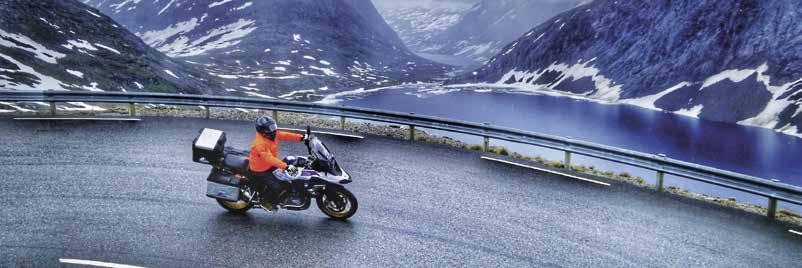
www .e d elweissbik e.com NEW YEAR, NEW ADVENTURES! SCAN ME
BMW OWNERS NEWS | January/February 2024 108




Introducing the WunderLINQ Handlebar control of your phone Motorcycle performance and fault data Phone charging and mounting blackboxembedded.com by
Chartered Clubs Are the Constant In the Training Equation
By Ted Moyer #100360
Every third Saturday of the month, our local club meets for its traditional monthly meeting. Recently, we’ve had 50 or so riders gather at a dealership for coffee and doughnuts. Next come the business reports from the President, Treasurer, and Secretary, and eventually we get to the good stuff: Who has been riding where, what roads are ahead, and who wants to go! A similar exercise happens each week as a smaller subset of retired members meets up on Wednesday mornings and answers the call of the open road. I imagine this ritual is repeated hundreds of times each month across the country as Chartered Club members gather and practice the art of motorcycling.
Many clubs have a safety czar or ride captain that reviews the rules of the road before every ride. Hats off to BMW Riders of the Emerald Coast President Jon Kagan, who routinely inserts a safety message into each club meeting and plays a short video clip from YouTube reminding everyone that motorcycle skills are perishable. It’s an example of one individual doing what they can to keep skill development and rider training top of mind.
Jon and every ride captain or safety czar out there have come to a very important realization that safety and skill development happen at the most local level. Ad campaigns and Public Safety Announcements are fine and dandy, but until individual riders have decided to act and improve their skills, nothing happens. If we are to be successful in saving lives, the message must come from within at the local level.
It’s the reason the Foundation believes strongly in the Clark Luster Safety Training Grant for Groups. This program allows groups or clubs to submit requests for training subsidies for the skill development and rider training initiative of their choice. In the simplest form, get a group of riders together, specify the training and provider and you could receive funding from the MOA Foundation. It only takes one person in the group to organize a training event for the club and submit for the subsidy.
Of course, there is no magic formula that invents funds for the Clark Luster Safety Training Grant for Groups program. All Foundation programs are funded by fundraising activities and donations from people concerned about motorcycle safety. And, if the “go local” model works for training, why not for fundraising, too?
The BMW MOA and the MOA Foundation have partnered to make local giving more impactful, in essence, providing an incentive to donate—just like there is an incentive to receive training. Every dollar donated to the SafeMiles Endowment by a Chartered Club is matched by both the BMW MOA and the MOA Foundation to create three dollars for rider training. As a bonus, all Charted Club donations and the matching funds are placed in the SafeMiles Endowment, which is rapidly growing past $700,000 to fund the future of motorcycle education.
The Chartered Club Match is off to a great start for motorcycle safety. Fifteen clubs have donated over $30,000 and, along with the match, nearly $100,000 has been deposited in the SafeMiles account. But we have work to do with nearly 150 clubs and only 10% participating at some level.
Remember President Kagan and his monthly safety message? Jon agreed to pilot an improvement to the Chartered Club Program by allowing donations from any member to be collected throughout the year and credited to the Club Match program. Now, any member of the BMW Riders of the Emerald Coast can give at any time, including the convenience of a credit card transaction, and the club receives credit for those donations. The MOA and the Foundation then do their part to match those funds and grow the size of the SafeMiles Endowment.
The assumption is that local club members believe in their own safety and take pride in seeing their Chartered Club participate in the solution. If it works as intended, the MOA Foundation will offer a similar solution to all clubs who would like to participate. If you want a peek under the tent, visit bmwmrec.org and click on the “About Us” menu to see the donation page in action. Each of us is responsible for our skill development and safety when riding. With help from Chartered Clubs and tools from the Foundation, programs like the Clark Luster Safety Training Grant for Groups can make safer riders a reality. Thanks to every ride captain, safety czar, and Jon Kagan out there for challenging us to be better.
As always, we encourage you to ride safe.
BMW OWNERS NEWS | January/February 2024 110







BMW Motorcycle Club of Colorado BMW Club Motorcycle Riders of the Emerald Coast BMW Club Motorcycle Owners of Alabama BMW Club Motorcycle Riders of Western Colorado BMW Club Motorcycle Riders of Northeast Florida BMW Club Hoosier Beemers BMW Club CCBR BMW Motorrad Club Granite State Riders BMW Club New Jersey Shore Riders BMW Riders Club Laurel Highlands CHAMPIONS SUPPORTERS January/February 2024 | BMW OWNERS NEWS 111
Never ride alone
With Platinum Roadside Assistance and Tire Protection added to your BMW MOA membership, you’ll never ride alone again. BMW MOA’s 24/7 Platinum Roadside Assistance gets you to a repair facility fast and will even replace a punctured tire for free! All that for only $109 a year, which includes the cost of your MOA membership.
Join online at bmwmoa.org or convert your current BMW MOA membership by calling 864-438-0962. BMW MOA Platinum Roadside and Tire Protection, available exclusively for BMW MOA members.
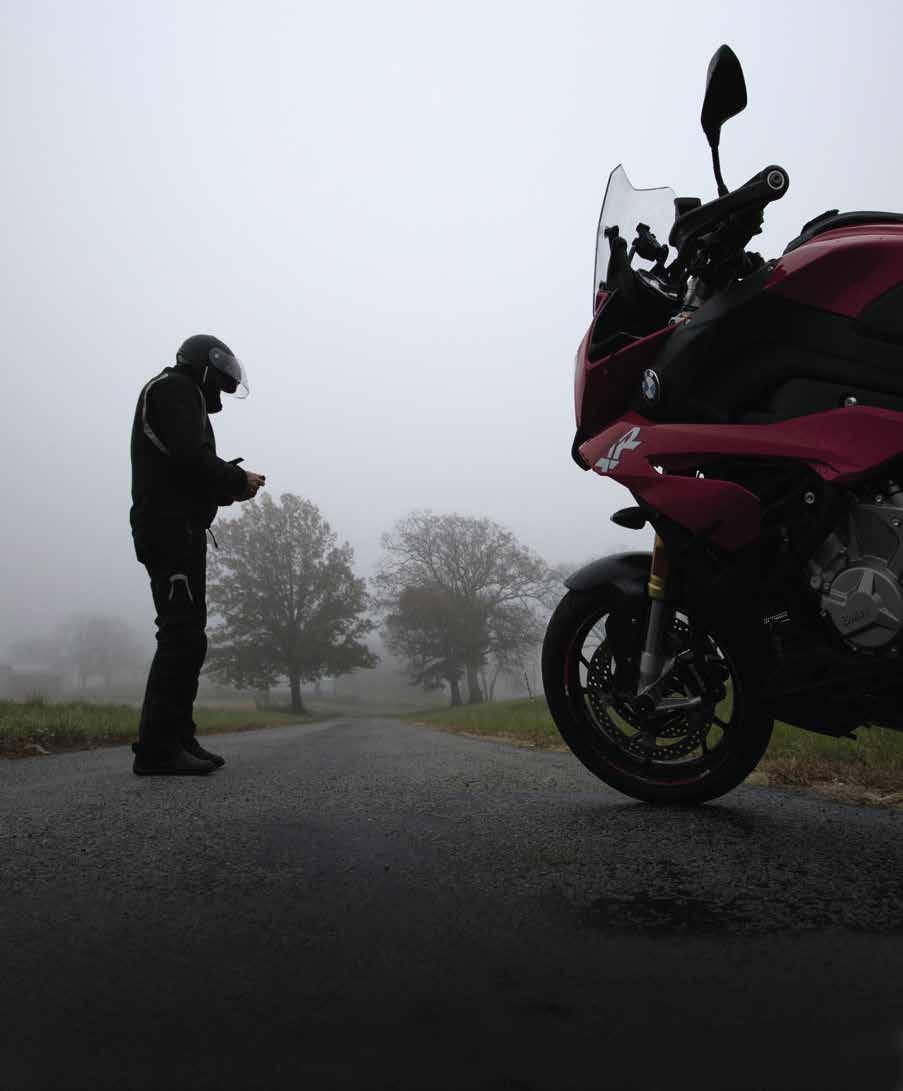




BMW OWNERS NEWS | January/February 2024 112

Three Times the Love for Motorcycle Safety
There’s a wild bunch of BMW riders in northern California. They’ve been riding and camping together since 1965. They pioneered the first 49er rally in 1971 and made history again in 2021 by donating $3,000 to the SafeMiles Endowment with a challenge to the MOA Foundation to make it count for the long-term future of motorcycle safety. Challenge accepted!
The MOA Foundation and the BMW Motorcycle Owners of America will match any chartered club donation to the Foundation’s SafeMiles program. Every dollar donated by MOA Chartered clubs is now worth $3 for the long-term future of motorcycle rider safety, education, and training.
Congratulations, NorCal. Your commitment to motorcycling and riders everywhere is now three times the love!
Visit bmwmoaf.org to find out more about the SafeMiles Endowment and how your Chartered Club can make a 3x difference.
January/February 2024 | BMW OWNERS NEWS 113
Foundation Grant Program Honors Paul Bachorz
By Ron Davis #111820
As the guy who gets to see all the copy that goes into BMW Owners News before it gets into your hands or on your computer screen, I can’t count how many articles I’ve edited from members who write glowingly about opportunities they’ve had to take some formal training. Young or old, whether it’s off-road, street or track courses, I’ve yet to read a story where the rider didn’t comment about how much his or her confidence and skills had improved by taking a class or workshop. And just as often, writers pay tribute to how much their decision to take some training was aided by making use of a Paul B. Rider Training Grant (formerly called the Paul B. Scholarship) from the BMW Owners of America Foundation.
Established in 2011, the Paul B. Rider Training Grants fund was established largely as a tribute to Paul Bachorz, who was a popular driving force in the BMW Motorcycle Owners of Vermont and a member of the Yankee Beemers. He was also a regular contributor to Owners News and an editor for a “Touring Tips” column. In both the MOA and the MOV, Paul was a vigorous proponent of MSF and all kinds of motorcycle training.
Following his untimely passing following a rally in Pownel, Vermont, his wife Judy was faced with the problem of what to do with all of Paul’s gear and motorcycles. Paul was sometimes called “Mr. Farkle,” and in fact, it was said Judy often wasn’t sure exactly how many motorcycles he had! Thinking of holding an auction to benefit the MOV, the then-president of the Vermont club, Muriel Farrington, suggested honoring Paul by donating the funds raised to the MOA Foundation to encourage rider education and training on a larger scale. “He was a very giving man” said Muriel, “and he deserved to be
remembered.”
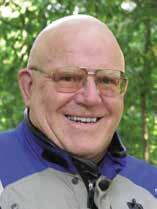
Working with Muriel, MOA Executive Director Ted Moyer thought the funds could best be used as seed money for what is now called the Paul B. Rider Training Grant program which could be offered to both members and non-members for training courses all over the country. The Foundation has supported the grant program annually ever since to support its mission of enhancing rider skills, safety and knowledge. Since its inception, a whopping $356,000 has been in awarded in grants to 1,600 riders!
Presently, the Foundation will award Paul B. Rider Training Grants of up to $200 for MOA members, or up to $100 for non-members (neither amount to exceed the actual cost of the training), toward the cost of participation in an approved training course. A committee comprised of three Foundation Board members will review all requests submitted and exercise broad discretion in approving training proposals. Individuals interested in receiving a grant should complete a submission form found on the Foundation website or download the pdf version and submit via email to paulb@ bmwmoaf.org. Requests must be submitted at least 30 days prior to the registration deadline for the training course selected and should contain a description of the training, including the training provider, cost, location and dates of the training. In no case will grants be approved for requests submitted after a training or rider education program has been completed. You can expect to be contacted by the Foundation within 10 days of submitting your scholarship request. Grants are limited to individuals and one grant per applicant annually.

BMW OWNERS NEWS | January/February 2024 114

January/February 2024 | BMW OWNERS NEWS 115
Donations Make the Difference
The BMW MOA Foundation is a 501(c)(3) non-profit organization dedicated to improving rider safety by providing funding for education and training programs that support motorcycling and its rich heritage. Achieving this mission is made possible via a generous donor community of motorcycling enthusiasts. Please consider joining that community now, as every donation helps create better trained and safer riders.
There are a variety of ways you can make a difference in the lives of motorcycle riders through education and training. Here are brief descriptions of donation methods that work well for the Foundation and have advantages for donors.
By Rik Lewis #217253
DIRECT CASH GIFTS
Cash, Check or Charge!
The MOA Foundation is registered as a designated charity in all 50 states and can legitimately accept cash donations from various sources. Of course, the most traditional method is a check for any donation amount mailed to the BMW MOA membership office in Greer, South Carolina.
The Foundation can also accept online donations made with a credit card. Visit bmwmoaf.org to donate online or call (864) 438-0962, and the membership team will be glad to help. Donations can be in any amount, large or small, and all gifts immediately impact the Foundation’s program for rider training. Most gifts of cash can be tax-deductible for the donor.
Donate a Little to Help a Lot
A very popular option for Foundation donors has been a recurring donation charged to a credit card. The Foundation uses a secure online platform that accepts donations on a regular interval, such as monthly or annually. This is a great way to have a significant impact with a small, monthly donation. Visit bmwmoaf.org to find out more and complete your donation.
Let Your Company or Employer Double the Impact
Many employers have community impact programs or matching donation programs that match individual donations to a charity of your choice, often doubling the impact of your donation. The donor may receive full tax credit for the matching gift. Check with your HR department at work to find out if your company has a matching donation program. The Foundation works with several matching platforms to make this a viable donation source.
Non-Cash Gifts That Help Today
Charities that accept non-cash gifts must have a use or outlet for the donation to be effective. The Foundation has equipped itself to accept a variety of non-cash gifts that can significantly impact its programs.
Interesting, Unique or Valuable Motorcycles
Motorcycles that can be sold and converted to cash are always accepted. Four motorcycles have been previously donated to the Foundation and converted to raffle prizes or fundraising projects. The Foundation also accepts motorcycles with historical significance for archival purposes. There are currently four motorcycles on display at the BMW MOA headquarters in South Carolina.
BMW OWNERS NEWS | January/February 2024 116

If you have a motorcycle that could use a new lease on life, contact the Foundation for options to donate the vehicle and make a lasting impact.
Real Estate
Although donating real estate may sound complicated, it is a relatively simple donation if you own property that is not mortgaged, has appreciated in value, and you no longer need or use it. You can deduct the fair market value of your gift and eliminate all capital gains taxes. Plus, you have removed the asset from your taxable estate. Real estate can also be used to fund a charitable remainder trust or a charitable gift annuity. Members of the Foundation Board of Directors can speak to you about real estate donations and effective donation strategies.
Securities, Savings Bonds and Monetary Instruments
There can be significant tax advantages to donating stocks and other securities that have appreciated in value. You should always consult a tax professional to determine the exact benefit, but the Foundation is equipped to accept donations of stocks, securities and other monetary investments.
Charitable Lead Trusts
Several types of Charitable Trusts exist, but the most popular is often a Charitable Lead Trust that provides income to the charity for a period of time before the income-generating assets revert back to family members, usually at a significant tax savings. Every situation is unique, but your tax professional and a Foundation representative can provide guidance and discuss the unique advantages of Charitable Lead Trusts.
IRAs, 401(k)s and Other Retirement Funds
Simply designating the Foundation as a beneficiary of an Individual Retirement Account, 401(k), or other retirement asset is an easy way to make a difference in the lives of motorcyclists. Retirement funds are some of the most heavily taxed of any estate asset and often the best asset to give to charity. You simply complete a beneficiary designation form to direct all or a percentage of what remains after your lifetime. It is that simple! The company that manages your retirement fund can provide you with a beneficiary designation form, or it may be on the company’s website.


January/February 2024 | BMW OWNERS NEWS 117
LEGACY GIVING AND LIFETIME GIFTS
Life Insurance Proceeds
You can make a gift of a new or existing policy, which results in a current income tax deduction, by designating the MOA Foundation as a beneficiary. It is often a simple process to make the Foundation the owner of a policy or change a policy’s beneficiary designation.
Bank or Brokerage Accounts
It’s very easy to complete “Pay on Death” or “Transfer on Death” instructions to include the BMW MOA Foundation as a beneficiary. Your banker or broker will inform you of the procedures to complete your arrangement.
Charitable Gift Annuity/Charitable Remainder Trust
Charitable annuities or trusts pay an income to the donor for a designated period before releasing the remainder of a person’s estate as a charitable gift. These are typically more advanced and giving strategies, but the Foundation can help to structure a Charitable Gift Annuity or Remainder Trust along with your Estate Planning professional.
Retained Life Estate Trust
You can transfer the deed of your personal residence or farm to the Foundation now and keep the right to live in and use the property for your lifetime. You will receive a current charitable deduction in an amount based on your age and the value of the property.
Specific Dollar Value in a Will
A bequest through your will or living trust is the most frequently completed planned gift. You have the joy of planning your bequest now, but you do not actually make your gift until after your lifetime. You may leave property or a specific dollar amount from your estate.
Percentage of Identified Asset Value
Instead of a specific dollar amount, some donors choose to leave a percentage of their estate. A similar process to designating a dollar value, donating a percentage of your estate allows for fluctuation in estate value and does not disadvantage any of the beneficiaries of estate giving.
ALTERNATIVE SUPPORT OPPORTUNITIES
Foundation Fundraising Raffles
The Foundation has enjoyed an exciting and successful raffle-based fundraising program, including the “Superstakes,” the “Completely Vintage Raffle’ and the “One Ticket & You
Pick It” raffle. Tickets are available during specific time periods with great odds of winning for MOA members. Proceeds from these fundraising events support current year programs and cover overhead expenses so that all charitable donations are used specifically for Foundation mission programs.
AmazonSmile
Every purchase you make at Amazon.com could benefit the MOA Foundation. Through the Amazon Smile program, Amazon donates 0.5% of eligible purchases to a charity of your choice. You simply need to designate the BMW MOA Foundation as your charity and perform your normal shopping at smile.amazon.com. You can also visit the Foundation website at bmwmaof.org and click the Amazon logo. To date, the Foundation has received more than $4,256 from the AmazonSmile program.
M4 Motorcycles
BMW MOA member Joe Tatulli created the M4 Motorcycle brand to increase the visibility and awareness of motorcyclists on the road. Purchases you make at m4motorcycles.com can include a donation amount to the MOA Foundation. Use the coupon code MOAFOUNDATION when you check out to generate a donation to the Foundation.
ALWAYS CONSULT AN ESTATE PLANNING OR TAX PRO
Tax laws and charitable giving eligibility changes frequently. Donors considering complex giving strategies should seek guidance from estate planning or tax professionals. You may contact any Foundation Board of Directors member listed on the “IN THIS ISSUE” page of BMW Owners News to discuss potential donations. All information discussed or provided to the Foundation’s personnel will be considered confidential.
YOUR SUPPORT IS APPRECIATED MORE THAN YOU MAY KNOW
Your gifts to the MOA Foundation have a powerful, lasting impact on the MOA community. The Foundation Board of Directors is composed of a group of committed volunteers who believe in the importance of training every motorcycle rider. Most members are also donors in some way, and your support of the MOA Foundation is profoundly important to each of our volunteers. The Foundation and its Directors would be grateful if you donate now or begin your planning process for future donations. The lives of motorcyclists depend on it!
BMW OWNERS NEWS | January/February 2024 118
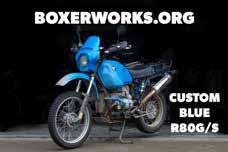








Order your subscription at www.roadrunner.travel RoadRUNNER COMPARISON: YAMAHA TÉNÉRÉ 700 vs KTM 990 ADVENTURE DEC’21 HOLIDAY BUYERS GUIDE • FREE TANKBAG MAPS www.roadrunner.travel TOURINGMOTORCYCLE & TRAVEL SHAMROCK TOUR WINSTON-SALEM, NORTH CAROLINA NEVADA NEW ZEALAND DECEMBER 2021 HOMETOWN RIDING North Carolina Shamrock Tour® NEVADA Black Rock Desert Glaciers Rainforeststo NEW ZEALAND BMW R18B AND R18 TRANSCONTINENTAL Subscribe Today! The Only Magazine for Motorcycle Traveling! REDVERZ.COM 72 0 21 3 8287 This Season Take Adventure ToTheNextLevel THEATACAMAEXPEDITIONTENT
FOUNDATION BOARD
tom gary
I am retired from Norfolk Southern Corp, a major railroad and logistic company. Over my 38-year career, I’ve held several management jobs, ending with corporate responsibility for automotive operations and damage prevention. I have also served in many volunteer leadership roles, most notably as president of a credit union in Roanoke, Virginia. Additionally, I currently serve as a Planning Commissioner for York Township, Michigan, where I reside. I serve the MOA Foundation as President, with responsibility for the operations and strategic direction of the organization.
I believe it is a rare opportunity to serve in a volunteer capacity that directly serves the members of an organization in a way that literally can save lives. Like many riders from the ‘60s and ‘70s, training was you and a buddy in parking lot, if at all. I am passionate to not see that repeated, and it gives me great satisfaction to be able to use my business skills to raise money to further the Foundation’s mission of advancing rider safety, education, and training. I believe skill development and safety are totally fundamental to riding a motorcycle, and it gives me great joy that the Foundation is impacting riders in a positive way.
I became an MOA Life Member in 2000 when I was encouraged to join the organization by a fellow member soon after purchase of my first BMW. I currently have three BMWs with the newest being a 2019 R 1250 RT.
steve martin
MOA Foundation Vice President
Over the years, I have served on many local and regional boards, including that of a local homeless shelter, a tri-state Economic Development organization financially promoting business growth and development of new businesses, and a regional membership organization supporting the Printing Industries of America, as well as church boards and other general business boards.
As vice president of the MOA Foundation Board of Directors, I rely on my passion for motorcycling and my experiences with other boards to support the work of our foundation.
As a rider with more than 50 years of experience and a former MSF Rider Coach, I am dedicated to helping as many riders as possible have a safe and fun motorcycling experience. I have seen firsthand the results of motorcycle crashes that could have been avoided with proper training, and I support motorcycling as a lifelong learning process. Working with our Programs Committee, I have the pleasure of creating and evaluating programs that will help riders be safer.
I became an MOA member in 1995 after buying my first BMW motorcycle. I currently ride an R 1200 RT and an R 1250 RS and have traveled more than 300,000 miles on BMW motorcycles.
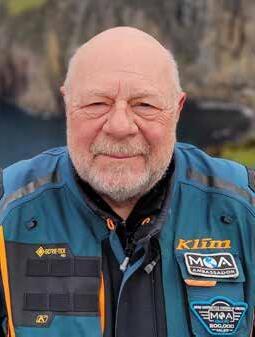
 MOA Foundation President
MOA Foundation President
BMW OWNERS NEWS | January/February 2024 120

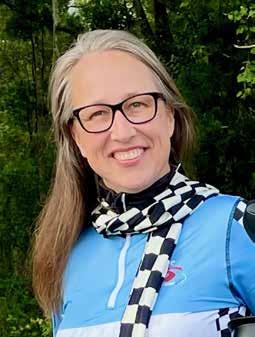 Dan Finazzo MOA Foundation Treasurer
Dan Finazzo MOA Foundation Treasurer
As a practicing engineer for more than five decades, my focus has always been on numbers, regardless of whether I am performing calculations for life safety, system, and equipment performance requirements or simply balancing the project budgets. Numbers are always in the background when making sure things are done correctly.
Being a part of a team of like-minded volunteers with the MOA Foundation is very satisfying to me–just like the project teams I have worked with in my past. As part of a team focused on the Foundation’s goals and aspirations, our desire is to provide funds to motorcycle riders to improve their riding skills.
As a Foundation, we are a conduit to solicit and obtain funds and to disperse those funds in a responsible manner. Ensuring those funds are managed properly and accounted for takes the efforts of several individuals, both within the Foundation and the MOA. I enjoy working with the Foundation Board as we continue to grow the organization while at the same time raising the skill levels of all riders from beginners to those more experienced.
I became a member of BMW MOA in 2005 a few years after purchasing a 2002 K 1200 LT. Over the years, I have owned many BMWs but currently own two sidecar rigs along with an R 1250 RT that can fall over—unless I put my foot down!
tammy bakke
MOA Foundation Director
In 2016 with the desire to do something brave, I decided to learn to ride a motorcycle.
After a morning of lessons on my boyfriend’s 2011 Ural Retro with him instructing me from the sidecar, I took an MSF course and soon purchased a 2003 Triumph Thunderbird. Several years later, I now own a BMW F 750 GS and an R 1200 GS and regularly ride both on and off-pavement near my home in Valrico, Florida.
My service to the Foundation began when I answered a call for volunteers in BMW Owners News. After experiencing how professional motorcycle training impacted my own safety and confidence, my hope was that I would be able help more riders see annual rider training as their most important upgrade.
Being invited to serve as a director on the board has further allowed me to use my marketing background to help connect riders with affordable skills development opportunities. I am also motivated by a desire to rally those with the means to donate to the Foundation’s Safe Miles Endowment–our long-term initiative to permanently fund future rider training.
January/February 2024 | BMW OWNERS NEWS 121
FOUNDATION BOARD
david dunn MOA Foundation Director
David has been riding motorcycles since college except for a 15-year break while raising his kids. He came back to riding in 2004 while living in Vermont when he purchased a 2002 R 1150 RT and joined the MOA.
David has served on many non-profit boards and was elected multiple times to chair a large school board. He has donated his time toward helping many charities from United Way to Habitat for Humanity and Rotary. He is also a Paramedic (18 years) and now teaches EMS in the Lehigh Valley.
David came onto the MOA Foundation Board because of his EMS experiences. While responding to motorcycle accidents, he saw riders who failed to wear proper gear, failed to negotiate corners, or avoid obstacles and who had over-run their abilities. He realized that skills training could help all riders–from beginners to long-term enthusiasts. He believes that assisting the Foundation in raising money for skills development grants will help reduce motorcycle accident statistics.
David currently rides a 2020 R 1250 GS. He loves long distance touring, motorcycle camping and splitting his time between riding and working EMS at rallies. David said, “I look forward to growing the Foundation into a self-sustaining organization that supports rider safety, education and training. One day, I hope every rider participates in annual training events, no matter their skill level.”

I live in Pensacola, Florida, with my wife Sarah and am the Executive Director of the Naval Aviation Museum Foundation supporting the operations of the National Naval Aviation Museum.
I began riding in west Tennessee and bought my first motorcycle in 1983. Around 1992, a growing family and my career sidelined me until 2009 when I began to ride regularly again. Today, I enjoy sport touring on my R 1250 RT.
The Foundation’s mission is dedicated to preserving the rich heritage of motorcycling by advancing rider skills, education, and training. Through education and training, we are able to improve a rider’s skill and proficiency which will improve the rider’s experience.
I began serving the Foundation as a volunteer supporting the planning and development of the Foundation’s Historical Archive. This support was natural with my role at the Naval Aviation Museum Foundation. After a year as a volunteer, I was invited to be a member of the Foundation’s board. I was honored to be considered.
Being a Board Member these past two years has allowed me to be a part of the Historical Archive project, while also serving on the Fundraising Committee and also serving as the Board Secretary. Each of these roles have touched on aspects of our mission to train and educate riders of all experience levels and hopefully enabling them to gain proficiency at make riding fun!
 Marshall "Marty" martin
MOA Foundation Director
Marshall "Marty" martin
MOA Foundation Director
BMW OWNERS NEWS | January/February 2024 122
Jim Nyffeler

Jim serves on the MOA Foundation’s Legacy Committee. He is driven by a desire to raise awareness about the benefits of ongoing motorcycle training.
As he entered retirement, Jim’s interest in volunteering for the Foundation was sparked during a conversation with the late Chuck Manley, a former director on both the MOA and the MOA Foundation boards. Chuck’s passion was an inspiration, so Jim stepped forward as a volunteer and was later invited to serve on the board of directors.
An endorsed motorcyclist since 1993, Jim’s first bike was a Honda Pacific Coast. He currently rides a 2017 R 1200 RT and a G 310 GS. He is a member of the Knights of the Roundel #333.
Jim encourages every rider to seek additional skills development at least annually and is honored to help hundreds of riders to utilize the Paul Bachorz Individual Training Grant and the Clark Luster Group Training Grant to obtain professional rider training at a reduced cost.
walton rogers
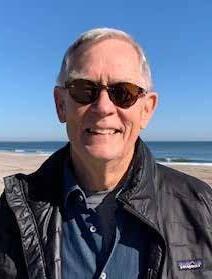
I was one happy rider when I did not crash or damage my R 1150 GS during a training class at the BMW Performance Center in Greer, South Carolina, several years ago. Later that day, during a conversation with MOA event host Bob Aldridge about my experience and career activities, he asked if I would speak with Chuck Manley about the work I was doing. At the time, Chuck was the MOA Foundation President and was interested in building the SafeMiles Endowment by expanding their fundraising approach to potential donors. At that time, I had 44 years of experience as a financial professional reminding people to bring their checkbook to meetings. Several months later the current Fundraising Director rotated off the Board, and I was asked to bring some new ideas to the donors.
While I was pleased to help, the hook was the Foundation’s Mission to advance rider safety, education, and training. I enjoy getting better at an activity and know motorcycle skills are both perishable and renewable. The MOA Foundation awards grants to riders who take safety and training courses. Those grants are possible because donors believe that safe riders have more fun and may ride well into their 80s. Age does not define when we stop riding, perishable skills do.
The SafeMiles Endowment needs your donations to be able to provide training grants in perpetuity. I hope to meet many of you in 2024 – remember to bring your checkbook.
I discovered the BMW MOA Foundation after joining the MOA in 2014 when I wanted to attend the MOA National Rally in St Paul, Minnesota. My current ride is a 2017 R 1200 RT.
MOA Foundation Director
MOA Foundation Director
January/February 2024 | BMW OWNERS NEWS 123

A TIME TO QUIT?
By Jon DelVecchio #208163
Just before it happened, I remember thinking things couldn’t get much better. It was my first springtime ride into the Pennsylvania mountains with a bunch of friends. I was in sync with my wicked fast KTM touring bike, and my internal voice kept shouting, “Wow, this feels so good!”
I was in the lead as we reached what is known to us as “ludicrous speed.” That term was first quoted by a joker in our club to describe what comes after riding “a bit fast” in the twisties. The phrase has a sarcastic way of suggesting that we may not be using the best judgment, but we’re having too good of a time to care.
After a stop for ice cream at Waltz’s in Salladasburg, we were
rapidly moving west down Route 973. Endless curves unfolded before us. As I came around the last right hander and headed downhill towards a T intersection, I quickly did the math in my head, and it wasn’t adding up. I was going too fast to stop. At least that’s what I thought at the time.
Many riders have probably felt panic after making an error. The best outcomes after messing up may include brilliant or ugly recoveries, but saves, nonetheless. I didn’t save it.
Traveling at over 100 ft/sec, a stop sign peeked at me through some trees and was approaching fast. Even though my tires were in good shape, this unforgiving beast of a motorcycle didn’t have ABS. I was on my own and failed miserably.
BMW OWNERS NEWS | January/February 2024 124
When both tires simultaneously locked up from my over braking, I knew my fate. Down I went, sliding quite a distance through a well-traveled rural intersection. The bike was trashed. I suffered some minor injuries and had to endure the shameful ride home for three hours on the back of my pal’s GS.
I initially came out of this disaster smelling like a rose, replacing the KTM with my first BMW! A few weeks later a Jeep crossed the centerline and crashed into me on the Beemer. Once again, I found myself sliding across the asphalt.
At that point, I started getting worried. My previous 15 years had some suspenseful moments with plenty of situations that could have led me to quit motorcycling altogether. However, these two serious and closely timed events deeply concerned me. I didn’t ride for an entire month and promptly sold off one of my bikes, replacing it with a sports car.
I recently enjoyed an episode of Ken Hill’s podcast focused on quitting the sport of motorcycling. His message was aimed at track day riders. Listening along, I couldn’t resist the urge to apply his sage advice to street riders facing this dilemma after a close call or crash. How is it that some people can regain confidence while others cannot?
While the ultimate decision to quit riding rests upon each individual, the following advice might help you determine when it’s time to stop or keep going.
Through my coaching, I preach that confidence equals knowledge plus experience. But at what point is that not enough? Certainly, knowledgeable and experienced people still crash. Things can get terrifying in an instant. It is this reality that tends to instill paralyzing fear in people.
While I’m sure many others have had similar thoughts, the following are mine as I considered my two-wheeled future.
Was it worth it to me?
Whether you believe it or not, motorcycling is a hazardous activity with a thin margin for error. Part of our success relies on things outside of our control, such as the behavior of others and environmental threats. Sometimes we make serious mistakes and have only ourselves to blame.
Riding a motorcycle isn’t rational either. Within the first hour of a beginner class, new riders are told that motorcycling is inherently dangerous. To do it is risky. While most students continue and pass these courses, some decide it’s not for them. Those that drop out aren’t willing to accept the exposure and vulnerability. I contemplated why I rode in the first place. Why keep doing it after banging myself up and getting spectacularly embarrassed?
First of all, it’s fun. Firing up the engine and riding off is exciting. Motorcycling is also challenging. It’s easy to ride a motorcycle, but to do it well requires a seemingly endless amount of skill development.
For those that like to travel like I do, motorcycling is a great way to go. Experiencing wanderlust is more fulfilling from a motorcycle seat.
While one-up riding is a solo activity, motorcycles bring people together in many ways. The BMW Motorcycle Owners of America is one fine example.
Knowing there are safer hobbies, could I really give all of this up after my alarming incidents? It’s not the only way to make friends and have a good time. People would understand if I walked away, right?
What are you doing?
If your confidence gets shaken, consider what actions might build you back up. Reducing risk takes effort.
Begin by setting specific goals that address any shortcomings or persistent worries. Keep learning by discussing techniques with others, enrolling in a skills course or trying a different style of motorcycle like a dirt bike.
Comparing yourself to others is a poor point of reference. Especially when it comes to speed. Others may be more skilled or willing to take higher risks. Don’t ride faster than you are comfortable. Slowing down goes a long way toward restoring confidence.
Someone considering hanging up the keys forever should think about these things. If the rewards outweigh the risk, ride on. If not, take a break and step back. This separation may help determine whether or not you truly want to continue.
For me, as my unfortunate summer came to a close, the motorcycles in my garage got more attention. I heard the road calling. I started taking rides again on my battle worn BMW and began to think about motorcycles all the time.
After adjusting my mindset and selling the sports car, everything was right back where it belonged.

Jon DelVecchio, #208163, began riding shortly after starting a family—not the typical stage in a person’s life to jump on a motorcycle. The obvious need for self-preservation fueled skill development and eventual MSF coaching certification. After years of riding twisties with friends, he was hooked on sport riding and began studying advanced techniques. Now that the kids are grown, Jon has time to share his experience with fellow riders so they too can have more confidence and enjoyment in the curves.
January/February 2024 | BMW OWNERS NEWS 125
TRAINING SUCCESS stories

here for the benefits!
I chose to join the MOA because of the great benefits that are offered. One of my favorite benefits is the 15% discount at the BMW Performance Center. I am scheduled to attend a women’s off-road class there later this year that I am really looking forward to. It will be great to meet fellow women adventure riders and learn the skills to become more confident and capable which will allow me to go more places off-road. Once I complete this class, I hope to take on more advanced rides like BDRs and enjoy some great adventures together with my husband on our motorcycles.
I am 5’2”, which is on the short side for someone who wants to ride an adventure motorcycle. I looked at several bikes, but all were too tall for me, and I wasn’t able reach the ground comfortably. I was so
excited when I realized BMW made a F 750 GS low suspension model which is perfect for my needs. BMW is one of the few companies who realize that there are short riders out there who want to experience the joys of riding an adventure bike.
I started out riding on the back of my husband’s bike but wanted to experience the thrill of riding my own. I’m very grateful to have found my F 750 GS, which allows me to do this. Now, my husband and I enjoy riding and going on adventures together and are able to go places we couldn’t before while riding two-up on his bike.
Amanda Taylor #232752 Belmont, Ohio
WELL WORTH THE COST
I was lucky enough to attend the West38Moto Level 1 training offered last summer during the Paonia, Colorado, BMW rally. I found the instruction to be excellent, with very clear communication and encouraging comments. The instructor made a point of determining each student’s prior riding experience and other activities that crossed over to heavy adventure bike use.
The stepwise approach to skill building with exercises before the trail ride was well thought out. I would highly recommend training with them. It was well worth the cost.
Scott Robinson #234651

BMW OWNERS NEWS | January/February 2024 126
I Love the performance center
I first attended the BMW Performance Center as a part of a five-part plan that I laid out to become an adventure bike rider. After having grown up riding enduro bikes back in the 1970s, my goal was to learn about modern adventure bikes and eventually get good enough to go on one of those great trips to distant lands that you hear about in podcasts and on YouTube.
I decided to attend a two-day, off-road course at the Performance Center as the second step of my journey. To prepare, I watched as many videos or video clips as I could find of what the course was like and eagerly anticipated my class date. In the meantime, I invited a childhood friend who also liked motorcycles to join me for the class. He lives in Atlanta, so it would be a short trip for him to get to Spartanburg. He agreed to go, and now the anticipated “fun level” rose even higher.
We arrived the day before our class and drove by the Performance Center to scope out the place. It looked just like in the photos and videos, and it looked great. We had yet to learn what we were getting ourselves into.
On day one, we headed to our classroom after coffee and greetings in the dining/break area. There were 11 of us, and we were a group of guys that looked to be in our 50s–I was 57. The chief Instructor introduced the other instructors and had us each introduce ourselves, and then he told us what we could expect there.
We would have classroom time to explain what we would be doing–sometimes in the indoor classroom and sometimes in the outdoor classroom–and then we would do (or attempt to do) what we just discussed. Slow riding, faster riding and braking, small and large hills, DEEP sand, DEEP gravel, ruts, logs and on and on. We covered each challenge by discussing the theory and then performing under the watchful eye of the instructors.
I have now been to the Performance Center three times and brought my son for the teen automobile course. I love the Performance Center.
I attended a two-day, off-road course and two other private days with Ricardo Rodriguez. I am happy that I have done all
of them, but the private instruction was the most enjoyable by far.
In addition to the Performance Center, as a part of my original five-part plan, I attended another course from another organization that claimed to be an “immersion” course that would teach off-road skills. Although not my intent, attending this other course allowed me to see and appreciate the difference you get at the Performance Center.
At the “other” course, the instructors would say something like, “Okay, we’re going to ride up this rocky hill, so everyone get in line and ride up the hill…ready go.” They offered little or no meaningful instruction on how to meet the challenge.
At the Performance Center, the instructor explains the physics of what your bike will be doing, what your body position needs to be, what your throttle control needs to be, and more before saying “go” on any challenge. The Performance Center method made all the difference in the world.
The other thing I like about the Performance Center is its emphasis on Challenge by Choice. The “other” course did not
promote that idea, and there was more of a peer pressure, “come on, everyone else is doing it” mentality, which I believe to be improper and dangerous.
In our two-day course at the Performance Center, very few people performed every challenge all the way to the end. Still, everyone seemed very happy with what they got from the course.
I left the two-day course in an ambulance and still went back for the two private sessions, so that alone is a great testament to my belief in what the Performance Center can do for a rider.
Ricardo and I are now lifelong friends, and I hope to get to the Performance Center again sometime soon. Even if I don’t, I will be eternally grateful for the things that I learned there. I know for a fact that they have helped me on all the adventures that I’ve had on my own R 1250 GS that I purchased because of the great experience I had at the two-day course.
Eric Beal #226319 Nocona, Texas

January/February 2024 | BMW OWNERS NEWS 127

committed to continuous learning
I didn’t hop on a motorcycle until I was 52, getting my license in December of 2018. What I lacked in early riding experience, I’ve made up for with a commitment to continuous learning. From the very beginning, I vowed to be the safest rider I could be, and that meant investing in annual training.
Since 2019 I’ve taken a variety of rider training courses including the Total Control Intermediate, Advanced L1, MSF Dirt Riders course along with several track days. In 2022, I joined Yamaha Champ U online and attended their Champ Street course a year later which really honed my skills.
One of my biggest challenges was making consistent tight U-turns. I struggled with them for a while, but the Champ Street course fixed that in a single session. Champ Street also helped me refine skills that are crucial for road riding, not just slowspeed maneuvers like some of the other advanced training courses focus on. As a bonus, we got to do a few laps on the racetrack with our bikes.
I may not have the years of riding experience that some do, but I’m making up for it by investing in formal training. I believe that’s the key to staying safe on the road. After all, it’s never too late to learn and grow as a rider.
Daniel Teng #226961 Danville, California
let’s ride!
I recently retired and wanted to get a new motorcycle that would allow me to continue to hone my meager adventure riding skills, while at the same time being great transportation to ride long distances around the U.S. and Europe visiting family and friends.
In August of this year, I purchased a 2021 R 1250 GS Rallye, my first BMW, and it has exceeded my expectations. After purchasing the GS and adding crash bars and lots of other shiny bits, I drove from North Carolina to Oklahoma to take some off-road riding courses at DART with Bill Dragoo and his team. Isn’t that what you’re supposed to do with a
new adventure bike? Crash it in dirt, gravel, rocks, mud, and sand, then pick it up and try, try again?
DART was a great experience; the curriculum, personalized instruction and real time feedback were top notch. My riding improved significantly, and I’m appreciating more and more the capabilities and versatility of my R 1250 GS. I’m looking forward to participating in the BMW MOA community going forward. Let’s ride!
Cheers!
Richard Strong #226204 Harlingen, Texas

BMW OWNERS NEWS | January/February 2024 128
My Education has Been Priceless
I first signed up for a one-day, on-road class at the BMW Performance Center. I enjoyed it so much, I joined the MOA and went back again for a one-day, off-road class a short time later.
Since my class at the Performance Center, I’ve taken additional motorcycle training courses, including a two-day Champ School course at the MiamiHomestead track, a two-day N2-ChampSchool ATP (Advanced Training Program?) at NCBike in Garysburg, North Carolina, with two of these classes receiving sponsorship from the Paul B. Grant from the MOA Foundation which helped to offset some of the cost.
The education has been priceless, and I mean that literally. I have learned and put into practice techniques that were taught that make me safer on the road and off. I now always cover the brake lever with two fingers. I now practice emergency braking weekly. The coaches at the BMW Performance Center drilled these things into us and encouraged us to seek out more training. I sincerely appreciate everything they do.
My experiences were amazing, one and all, so positive and encouraging. Wendy helped me a ton with my offroad riding. I’d never been offroad before that day and by the end of the day we were navigating all sorts of cool obstacles. Yeah, I dropped the bike a few times, but she helped me pick it back up, and we kept on riding.
This coming weekend I’m going to Carolina Motorsports Park to do a track day there to practice what I’ve been learning, and this time I’ll be on something more appropriate for the racetrack.
Learning and improving your riding is not only lifesaving, it’s super fun, and I strongly encourage everyone to take training at least once a year. Even if you don’t think you ride fast or don’t think you’ll learn anything, I assure you that you will learn a ton and you’ll feel great for having done it and gaining this experience.
James Lopez #230860 Denver, North Carolina

January/February 2024 | BMW OWNERS NEWS 129
ARE YOU CRUSTY?
Depending on where you live, you’re probably familiar with the phenomenon of off-season “rusting” to some degree. Winter tends to reduce our saddle-time, and riders in the far north may end up forfeiting parts of autumn and spring, too. As temps climb out of the frozen abyss, riding resumes, but this can involve considerable awkwardness. Our bodies don’t seem to remember what our minds recall—and expect. It can take a surprising number of outings to get back into the groove we inhabited pre-hiatus. When we’re rusty, coordination doesn’t return instantly or to the level where we left it and certain muscles have atrophied with disuse, not to mention the flexibility losses that set in during hibernation. Ridingrelated cognitive faculties have dulled as well; regaining
sharpness and concentration stamina takes time and perseverance. Of course, all these deficits stand in sharp contrast to pent up anticipation and excitement! It’s not uncommon for rider enthusiasm to exceed rider patience, prudence, and competence early in the re-entry process, resulting in especially unfortunate mishaps just as liberation seems finally within reach.

Now zoom out to what may be a less welcome vantage point. Instead of the season of the year, this vista includes the season of our life. Age brings another type of decay, with waning physical and mental abilities at a more fundamental/global level. It takes greater effort to simply maintain the same level of fitness—or merely slow our descent. Motivation and vitality can ebb as
THE RIDE INSIDE
BMW OWNERS NEWS | January/February 2024 130
both cause and effect of increasing bodily limitations. Vivid awareness of our mortality reduces our tolerance for risk, regardless of any associated potential rewards. We can find ourselves, wittingly or unwittingly, retreating from challenges, and possibly even activities we had previously enjoyed without hesitation. This is a partial definition of clinical depression, by the way, and a seriously foreboding development.
For a motorcyclist like me who’s moving into the early autumn of life and contending with the inevitable dip in riding acumen that follows winter’s restrictions, it’s a double whammy. That could be discouraging, even demoralizing, and one might be tempted to “go gentle into that good night,” when it’d be better to “rage against the dying of the light” (thank you, Dylan Thomas). I’m going to call this condition “crustiness,” and it goes beyond normal spring rustiness. The antidote is pursuing lifelong learning in multiple domains, but here we’ll focus on those related to riding. Accumulated crust interferes with such pursuit and completely precludes it if there’s enough buildup. Crust compounds the deterioration described above, whereas forcefully scraping crust off—deliberately opening ourselves up to new learning and investing in our own perpetual development—is rejuvenating.
Crustiness often accompanies advanced aging, but it’s an attitude folks can adopt long before they’re truly up against the aches and stiffness and fog of—er—seniority. Take, for instance, the person who eschews rider training because they’ve done without it over decades of motorcycling and haven’t died. They’ve jettisoned curiosity about what they might not know and think they’ve got it all figured out, at least well enough. One of the most common experiences among riding school trainees is the discovery that what they thought they knew, or were actually able to do, turned out to be problematic and in need of change. (Dodging the necessity of growth and change is at the heart of crustiness.) Maybe they hadn’t yet encountered a situation that required a better approach, so this deficit wasn’t apparent. But such an event might be right around the corner tomorrow and impossible to predict. Or maybe they had already dealt (incompetently) with exactly such a situation, but didn’t realize the problem was their technique, not “the tires” or some other consideration that was, at most, only a tiny, peripheral factor in their accident. They may have also thrown up their hands and treated it as an outcome impossible to avoid, since they didn’t know how to handle it and couldn’t imagine a workable solution. Such a failure of imagination does not mean a solution didn’t/doesn’t exist. If all we’ve ever practiced are the procedures involved in our routine riding through familiar settings, we cannot possibly be prepared for something anomalous, especially if that something appears suddenly; “good enough” skill is
only good enough until the unexpected proves it isn’t. All of us can only do quickly and reflexively those things we’ve done often and recently, regardless of what we may grasp in theory. To believe otherwise is to have delusions of grandeur. Take it from a clinical psychologist, that’s not hyperbole.
The argument that I don’t need rider training because I’ve survived all these years without it just doesn’t hold water. I’ve been a motorcyclist for over half a century, yet I still learn ways to improve my riding with every exposure to instruction, whether it’s in the form of a riding school, written explanations and advice, online videos, or feedback from more advanced riding buddies. I also learn by doing drills in parking lots and empty stretches of road, practicing techniques I may already “know” conceptually, but which I’m always dismayed to find my body quickly “forgets” without continuous repetition; muscle memory can fade rapidly. Then there are those disturbing discrepancies between what I believe I’m doing on the motorcycle and what I’m actually doing. It’s quite humbling to be excited about the dramatic lean angle I achieved, only to see myself in a much more upright posture in the GoPro recording [wince!]. There are many ways we can be mistaken about our own level of mastery. Expert guidance corrects those misconceptions and fills in the blanks we didn’t even realize were there. It’s quite possible, as the saying goes, for someone who’s ridden for 20 years to have really just ridden their first year 20 times, advancing no further than whatever they initially figured out about the most rudimentary operation of a bike’s controls. I know that was definitely true of me.
I learned to ride a motorcycle (years before I was legally licensed to do so) on the straight, level roads of Central Florida and didn’t have the slightest idea how to manage the curves and slopes of the Appalachian Mountains when I relocated to East Tennessee at age 24. I’d never had any instruction beyond the (literally) 60-second explanation I got when the dealership delivery guy dropped off my first bike: “That’s the clutch, that’s the brake, that’s the gear-shift. Oh yeah, there’s another brake down there. Good luck!” I miraculously avoided any collisions, aside from the numerous soil samples I took while riding off-road, and remained a solitary motorcyclist until about seven years after my relocation, when I took the MSF’s Basic Rider Course alongside a friend I’d cajoled into buying a motorcycle so I’d have a companion. Yes, I had already learned some of the fundamentals on my own in the school of hard knocks, but I fixed several bad habits and got intrigued by the way riding techniques could be conceptualized and systematized, and how beneficial this proved in my own post-training experience. I took their
January/February 2024 | BMW OWNERS NEWS 131
“
CRUSTINESS OFTEN ACCOMPANIES
ADVANCED AGING, BUT IT’S AN ATTITUDE FOLKS CAN ADOPT LONG BEFORE THEY’RE TRULY UP AGAINST THE ACHES AND STIFFNESS AND FOG OF— ER—SENIORITY.
“
advanced course and learned more, and eventually found a local group to join—riders with vastly more skill than I possessed, who were kind and generous in tutoring me. They convinced me to come along to a track school, and I was hooked. I learned more in that one weekend than I’d learned in the two preceding decades. I had zero aspirations to race, but the track had so many advantages over the street: its handy ambulance crew, extensive run-off zones, and lack of oncoming traffic. Also, the magic of repetition allowed me to engage the same corners over and over again, working out my strategy and technique, and watching my lap times tumble. I wasn’t exactly trying to go fast; speed simply arrived as a byproduct of smoother, more effective control inputs. By the end, much higher speeds felt safer—and actually were safe—than the lower speeds I’d managed at the start.
Since then, I’ve had the benefit of a dozen other formal rider training experiences, most on racetracks, but some involving on-road time. All have been deeply enriching, although I’ve learned first-hand how essential practice is to maintaining gains. There’s a natural entropy that reverts us back to pre-training patterns unless we wear in new grooves by doing what we learn, again and again. The best riders I know still practice basic skills regularly, despite their superlative abilities; that’s how they got those abilities and how they hang onto them. Foregoing training and practice only makes sense if your personal goals include a) embracing mental and physical decline, and b) rigidly denying the possibility (fact!) you don’t already know everything about piloting a motorcycle. Get real. Get training. Then practice to make it stick. It’s work that feels like play. Grab a partner; they’ll thank you afterward. Better yet, set up a monthly skill drill gathering with your whole riding group.
Back to the issue of crustiness. Research evidence is abundantly clear: the best ways to stave off psychological decline—at any age—are to stay physically active, nurture our relationships, and keep learning. Motorcycling offers us countless ways to do all three. Even if you can’t get to a riding school because of the expense or distance, there are plenty of online options that cost little or nothing and will undoubtedly teach you things you didn’t know you didn’t know. In the series of podcast interviews with riding instructors I launched last year (see bmwownersnews.com/ category/moa-media/), I spoke with several who have developed extensive home training programs. Check out Greg Widmar’s MotoJitsu YouTube channel, books, and app (see motojitsu.com), Jon Delvecchio’s Cornering Confidence course (free to MOA members at streetskills.net), and Champ U, a curriculum developed by Nick Ienatsch and the crew at Yamaha Champions Riding School (ridelikeachampion.com). Champ U’s Core Curriculum is available to MOA members at a drastically discounted price ($39.95 instead of $99.95), which can then be recouped
THE RIDE INSIDE
BMW OWNERS NEWS | January/February 2024 132
with an MOA Foundation rebate, making it ultimately free (register via bmwmoaf.org).
All of these include clear, convenient, inexpensive, interesting lessons with integrated drills and exercises to convert conceptual knowledge into bodily proficiency. They are excellent ways to de-crustify, especially with a study buddy.
If you’re still holed up waiting for winter weather to relent, go ahead and immerse yourself in these now for relief from cabin fever, at least mentally. Then, when the world outside thaws, catch up on the physical applications of all that knowledge as you ease back into riding. Your access to the drills and exercises won’t end just because you’ve finished watching the lectures and demonstrations. Forget about trying to pick up where you left off last fall, you’ll jumpstart 2024 with tangible improvements.
One final tip: The MOA Foundation offers on-request scholarships to every MOA member for bona fide rider training (not lessons from Joe down the street in his driveway, but any legitimate formal instruction). These scholarships cover costs up to $200 annually, meaning you can snag that money year after year, just by asking for it ahead of time and showing proof you subsequently completed the training. Visit bmwmoaf.org for more information on the Foundation’s mission and multifaceted support for rider education.
No, good rider training isn’t too expensive, or too far away, or just stuff you already know. It’s big fun in itself, and it makes the riding that follows both safer and more enjoyable. There’s really no good reason to stay crusty.

Mark Barnes is a clinical psychologist and motojournalist. To read more of his writings, check out his book Why We Ride: A Psychologist Explains the Motorcyclist’s Mind and the Love Affair Between Rider, Bike and Road, currently available in paperback through Amazon and other retailers.
Over 40 essays, features, reviews, profiles and memoirs focusing on the two-wheeled life from the author of the acclaimed Shiny Side Up.
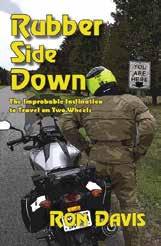
I’ve enjoyed Ron Davis’s columns and stories for a long time…he does what all the best motorcycle writing does: he makes you wonder why you aren’t out there riding your own bike, right now, except during the long Wisconsin winter, when his work simply helps you stay sane until spring.”
—Peter Egan, Author of Leanings 1, 2 & 3
The best books on motorcycling and adventure travel
ISBN 978-1-890623-74-6, Softcover 252 pages, $19.99 SRP


TOUR DATES 2024
MAY 4 - 12
AUG 24 - SEP 1
SEP 28 - OCT 6
COUNTRIES
Croatia, Slovenia, Bosnia and Herzegovina
BMW-ON-square-ART.indd 2 15/11/2023 10:17
RIDE SAFE
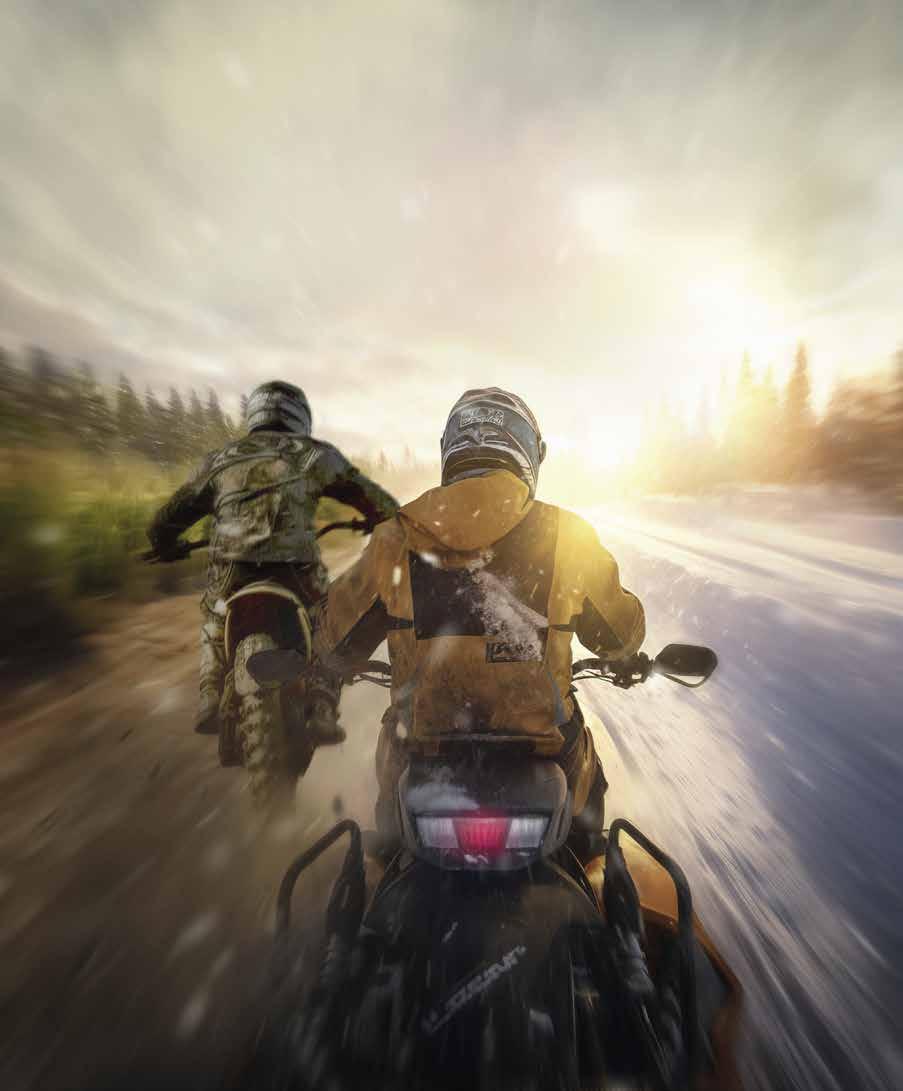
inValuable tips for riding in all seasons
BMW OWNERS NEWS | January/February 2024 134
Get trained!
With the Clark Luster program for groups and the Paul B. program for individuals, the MOA Foundation is there to reimburse you part of the cost of your training programs. Whether it’s a track day training session or a beginner’s course, training helps you develop your skills to handle both the mundane (tight U-turn in a parking lot) and unpredictable (DEER!) with aplomb. Advanced courses will teach you collision avoidance techniques as well as better turning and braking techniques.
Keep track of the weather
Poor weather conditions can reduce traction and visibility, making your ride more complicated than you expect it to be. Putting the ride off a day isn’t a bad idea, but if you can’t, ensure you have the right gear and your bike is in top condition to handle the inclement weather.
All the gear—all the time
Your gear protects you from head to toe from the elements as well as those unfortunate, unplanned fly-and-slides we all know can surprise us at any time. Use a DOT-approved helmet with face/eye protection, a sturdy leather or reinforced textile jacket with shock-absorbing armor, pants or overpants with armor, over-the-ankle boots and gloves. Whether it’s hot out or cold, there is gear suited to your riding style and climate conditions. Use layers to stay comfortable throughout the day no matter the weather.6
T-CLOCS
Inspecting your bike before you ride is an easy way to help prevent unexpected delays and other problems. Using T-CLOCS (Tires & wheels, Controls, Lights, Oil & fluids, Chassis & suspension, and Side stand up) is a great mnemonic to remind you of this quick inspection process.
Traffic laws are for you, too!
It may be news, but all those traffic laws we expect the cagers to obey apply to us motorcyclists, too! According to the Insurance Institute for Highway Safety (IIHS), over 6,000 riders were killed in crashes in 2021—14% of all motor vehicle crash deaths—and excessive speed was a factor in as many as a third of those crashes. Ride at or near the speed limit—conditions allowing—and use your turn signals.
Don’t drink and ride
According to the IIHS, 29% of riders who died in crashes in 2021 had a blood alcohol concentration at or above 0.08% — and for single-vehicle crashes, the statistic was 43%! If you are going to enjoy alcohol, do it at the end of your riding day, not during it.
Be visible
Don’t assume car and truck drives see you. According to the Hurt Report, 75% of crashes involving motorcycles cite not seeing the motorcycle as a contributing factor. Stay out of drivers’ blind spots (especially those massive semis!), always have your headlight on, consider adding auxiliary driving lights, wear bright colors (statistically speaking, a white helmet is best), use gear with reflective materials at night and be diligent about using your turn signals.
Ride defensively
Defensive riding means anticipating problems and hazards—“seeing” them in your mind’s eye before they can actually happen in front of you. Sand, oil, gravel and other materials in the road will compromise traction; bumps, potholes and debris can upset your stability. Cross railroad tracks at as close to a 90° as possible. Remember it takes about 30 minutes of steady rain to wash oil and other soaked-in materials off road surfaces, so think hard about delaying your ride if it starts raining.
Don’t tailgate
Experts recommend staying four seconds behind the vehicle in front of you, saying this gives you plenty of time to stop or swerve as appropriate in a suddenly hazardous situation. Always be running escape routes in your mind, especially when you’re in heavy traffic. Don’t forget highway shoulders are often littered with gravel and other debris.
First aid & CPR—be prepared!
Take at least a basic first-aid kit along with you on every ride, and know how to properly use its contents. Visit your local Red Cross office (or their website, redcross.org) and find out how to take a basic first aid course. Consider taking the CPR course as well, as best practices for emergency CPR have changed in the last 20 years.
Check in with your people
Let’s face it—many BMW riders enjoy being alone on the open road, unencumbered by the schedules of anybody else. Keep your people, whether they be friends, family or coworkers, in the loop by sharing the basics of your riding plans. Check in by phone, text or email on a daily basis and let them know who to call if you stop checking in. If you are riding with friends, be sure they know how to contact your next of kin should you be involved in a crash or have a health crisis on the road.
January/February 2024 | BMW OWNERS NEWS 135
1. 2. 3. 4. 5. 6. 7. 8. 9. 10. 11.
Welcome our newest MOA members
Witold Adamczyk Rock Island, IL
Harshdeep Ahluwalia Coatesville, PA
Ali Ahmadi Bellevue, WA
Sam Ansmink Amsterdam
Dario Antignano Longwood, FL
Stuart Atnip Casper, WY
DeAnna Axelson Saint Paul, MN
Bryan Baker Tyler, TX
Jacob Balsiger Jefferson, OH
Julie Bankert Grand Junction, CO
Lewis Barnes Seaton, SA
Zach Bartelstone Flourtown, PA
Paul Beil Collierville, TN
David Berquist Chesapeake, VA
Bernard Berry Chicago, IL
Kurt Bezoenik Southworth, WA
Elias Billington Brookings, OR
Tom Binford Pelham, AL
Bertilus Bornelus Orlando, FL
Michael Boyd Owensboro, KY
Robert Bradford Mims, FL
Courtney Braun Bend, OR
William Britt Montpelier, VA
Dave Brown Lakewood, CO
Thomas Brozek Downers Grove, IL
Wayne Brunner Lehighton, PA
Joe Buchak Gilbertsville, PA
Louis Burch Baltimore, MD
John Burr West Lafayette, IN
Jeffrey Carter Oklahoma City, OK
Michael Carver Mesa, AZ
Edward Chick Chicago, IL
Steven Christensen Lakewood Ranch, FL
Clayton Churchill Brownfield, ME
Igor Cibotari Huntley, IL
Michael Clark Archbald, PA
Stan Clement Trevor, WI
Chuck Collene Bucyrus, OH
James Cowdery North Yarmouth, ME
Albert Cox Steelton, PA
Brian Crenshaw Edgewater, MD
Joao Crus Austin, TX
Gary Dahl Kyle, TX
Chris Dearing Winchester, VA
Joseph DeFrancesco Holland, PA
Andre Desima Chesterfield, VA
Edward Devorak Edison, NJ
Jeffrey Diffenderfer Gulf Shores, AL
Earle Dixon Cherokee, NC
Gregory Dlling Chesham, BKM
Gaetan Dubuc Laval, QC
Jonathan Dunn Portland, OR
Nick Dutton San Jose, CA
Dave Ebert Inman, SC
Larry Eckman Brooklyn Park, MN
Gerald Ehrenstein Amherst, NH
Don Ellington Coppell, TX
Eric Elliott Wyckoff, NJ
Norwin Elsasser Redford, MI
Ivan Evtimov Mount Prospect, IL
John Fajdich Dyer, IN
Tim Fara Rock Hill, SC
Manfred Feldmann Rhinelander, WI
Giovanni Ferlaino Oklahoma City, OK
Erik Fischer New Park, PA
Terry Fischer Surrey, BC
Patrick Fitzgerald Hurley, NY
Chuck Flagg Sparks, NV
Ray Flowers Toledo, OH
John Foxhoven Saint Marys, OH
Ronald Freidhof Bettendorf, IA
Mark Fryover Hiram, ME
John Gage New York, NY
Beth Galloway Belwood, ON
Jeffrey Gantnier Charlotte, NC
John Gelosi Wurtsboro, NY
Joseph Gibson Barrington, IL
Brian Gluck Sparta, NJ
Don Goldstein Queensbury, NY
Lincoln Gomes Greer, SC
Edwin Gonzalez Hoffman Estates, IL
Bob Grady Hope Valley, RI
Steven Graham Gilbert, AZ
Geoffrey Green Fort Collins, CO
Eric Greenawalt Mechanicsburg, PA
Terry Gress Ripon, WI
Jerry Guistwite Hanover, PA
Carl Hagen Fallon, NV
Edward Hamel Markham, ON
Kirk Hansen Bayside, WI
Jon Hartwig Grayling, MI
Chris Harwood Zeeland, MI
Eric Haupt Greenville, SC
Bryan Hawley Harleysville, PA
James Hawthorne Sioux City, IA
Michael Hazelrigg Hindman, KY
Jill Heath Kennebunk, ME
Elin-Mari Heggland Westport, MA
Jeremy Henson Stirling, ON
Tabitha Holmes Cary, NC
Blake Hottle Los Angeles, CA
Scott Houseknecht Auburndale, FL
Jim Hughes Johnson City, TN
Jang Hwang Huntington Beach, CA
Emily Irwin Toms River, NJ
Ivan Ivanov Silistra
Noah Jacob Birmingham, MI
Ernie James Yucca Valley, CA
Rob Jay Norfolk, VA
Jon Jeffreys Albany, GA
Eric Jensen Schaumburg, IL
Zachary Johnson Panama City, FL
Mark Johnson HIghlands Ranch, CO
Gregory Johnson Stafford, VA
Larry Johnson Memphis, TN
Trent Johnston Carbondale, IL
Bryan Kenney North Grovnersdale, CT
Chris Kim Sunnyvale, CA
Kevin Kinard Dauphin, PA
Chris Klement Boerne, TX
Christopher Krier Palm Harbor, FL
Zhidong Lai Clover, SC
Victor Langarica Tamarac, FL
Paul Larson Apopka, FL
Allan Laxdal Coombs, BC
Rob Lee Arlington, VA
Donald Lemmon Reynoldsville, PA
Donald Lettner Louisa, VA
Tracey Link Franklin, OH
Jason Link Franklin, OH
Hank Liu Toronto, ON
Scot Longyear Terre Haute, IN
Gerry Lozano Loveland, OH
Alexander Madigan Roswell, GA
Diego Maldonado Rey Miami, FL
Paul Manning Prattville, AL
Ramon Marion Chesapeake, VA
Philip Martin Westport, MA
Steve Masciotti Charlestown, RI
George Masden Mill Hall, PA
Eric Matherne Portsmouth, VA
Jeff May Bulverde, TX
Alexander McBride College Station, TX
Coleman McDonald Berkeley Lake, GA
Blake Mcelroy Grimsby, ON
Ryan Melicker San Jose, CA
John Meyer Winnetka, IL
Darren Millard White Rock, BC
Peter Monshizadeh Overland Park, KS
John Morgan Fort Myers, FL
BMW OWNERS NEWS | January/February 2024 136
“A love for motorcycles and cars inspired me to study mechanical engineering, which eventually led me to a career as a mechanical engineering professor at the University of California, Riverside.
Back in Europe, I was enjoying local scooters and small motorcycles. Finally, I graduated to a nice BMW motorcycle. I always appreciated everything about motorcycles, from sound, to clutch and throttle, to vibrations and even smell. It is pure joy. What I love about my BMW is basically everything. The size fits me perfectly, design is beautiful, it is easy to ride, controls are responsive and it is super comfortable. Looking forward to many miles of road and off-road riding.
“Looking forward to enjoy the membership in BMW MOA.”
– Marko Princevac #235573

Kevin Moses Herndon, VA
Bill Mueller Blissfield, MI
Bryan Napier Stevensville, MD
Brad Nelson Colorado Springs, CO
Greg Nielsen Bentonville, VA
Robert Nigro Shrewsbury, NJ
Curtis Nugent Black Mountain, NC
Terence O’Donnell Franklin, NC
Brian Olson Dunedin, FL
Oshea Omary Salinas, CA
Michael O’Neill Pepper Pike, OH
Lee Padilla Laughlin, NV
George Palumbo Cumming, GA
Steve Pantalone Mountain Top, PA
Claude Pardo Kelowna, BC
John Pattaras Atlanta, GA
Joseph Pepitone Beavercreek, OH
Jon Perlman Cold Spring, NY
Wilmer Pierson Oceanside, CA
Eric Pincus Salem, MA
Peter Pinsak Nazareth, PA
Nicholas Pisciotta Arlington, VA
Marc Poland Bakersville, NC
Shivaprakash Poojary Simpsonville, SC
Christopher Pouliot Concord, MA
Steve Prather Austin, TX
Bryan Raabe Green Bay, WI
Charlie Radford Mohnton, PA
George Raduano Lutherville, MD
Heather Reece Moore, SC
James Rhoades Lake Frederick, VA
Bill Richards Jacksonville, FL
Michelle Richards Munford, TN
Carlos Rivera Lawton, OK
Gordon Robinson Hillside, NJ
Antonio San Martin Augusta, GA
Wesley Sassaman Scottsdale, AZ
Michael Saulsbury Lexington, KY
Howard Schemmel Mayfield Heights, OH
Brett Schexnider Greenacres, WA
Brian Schlotfeldt Malvern, PA
Samuel Schmidt San Diego, CA
John Schultz Enid, OK
Chester Schultz Amherst, VA
Brent Seher Hendersonville, NC
Terry Seip Wellesley, ON
Caleb Seymore Littlestown, PA
Manuel Sibert Atlanta, GA
Wieslaw Skarzynski Carpentersville, IL
Bill Spangler Blue Hill, ME
Phil Spence Bailey, CO
Michael Stephens Wellford, SC
Mark Stevens Saco, ME
Johan Straub Eureka, MT
Craig Swenson Grand Junction, CO
Andre Tal Mississauga, ON
Paul Taylor Arlington, MA
Jeff Taylor New Palestine, IN
Nicholas Tenney Las Vegas, NV
Kurtis Thrasher Reno, NV
Eric Tolstoy Terrebonne, OR
Alfred Torres Collierville, TN
Wilfrido Tovar Saint Joseph, MI
Stephanie Townsend Loveland, CO
Huerta Tribble Indianapolis, IN
Pat Tucker Keller, TX
Curt Tucker Hensley, AR
Nicholas Tulloh Derby, DBY
Wes Turnbull Midlothian, VA
Richard Umstead Bessemer, AL
Stephen Urban Basking Ridge, NJ
Peter Valencia da Silva Greer, SC
Peter van Bavel Austin, TX
Rickey Varga Califon, NJ
Anthony Verno Westville, NJ
Derik von Recum Portsmouth, RI
Nancy Wagner Sheboygan, WI
Buddy Walton Riverside, MO
Micah Waterman Enterprise, AL
Martin Watson Kilgore, TX
Daniel Weaver Alpena, MI
Gail E. Webster Manhattan, KS
Jim Weikel Monmouth, OR
Gary Weiss Mishawaka, IN
George Wick Ford City, PA
Rick Willette Wakefield, RI
David Williams Richland Hills, TX
Ojay Woods Clearwater, FL
John Wray Flower Mound, TX
John Wright Springboro, OH
Chih Liang Wu Alhambra, CA
Walied Zekry Queensville, ON
David Zeledon Trevose, PA
January/February 2024 | BMW OWNERS NEWS 137
BMW Owners Anonymous Rescues
Larry Stonestreet #21583
I’ve had several encounters through the BMW Owners Anonymous book.
The one that stands out most is when I got a call from an MOA member whose /5 had lost its transmission about 40 miles away. He had the bike towed to my house, and we assessed the issue. He was an 80-year-old fellow who had travelled from the east coast on his /5. I had a spare /6 transmission available and after an evening meal we pulled the old transmission. I had a spare room, and he spent the night comfortably.
The next morning, I fixed breakfast and by 11:00 had the transmission in place with a modification to the neutral switch wiring, and he was on his way. I shipped his old transmission back to his house, and he called to confirm he had a safe trip home.
Very satisfying use of the BMW Owners Anonymous book!
Chloe Carson #43186
In the fall of ‘89, we got a call from a young German man from Berlin who was touring our country after graduating from a university. His /7 needed a good servicing, nothing major, and he stayed with us for a couple of days.
We all sat transfixed in front of the TV, watching the fall of the Berlin Wall. Our guest was as surprised and interested as we were; Bill and I got a really good back story to the proceedings.
Mike Chapman #79967
My book came in handy in 2005 while in the “Tail” area.
While I was riding my 92 RT, my friend’s dad was on an ‘01 Fatboy. The FB devel oped a transmission issue. So, I got out my book and called a local listing. He went the distance for us for sure. He brought a trailer, helped us load up the bike and took it to a shop he trusted. The guy got right on the bike and got it fixed for us.
Gray Buckley #27846
With the 1995 Durango Rally a few days away, I received a call from a 29-year-old Frenchman who had flown to St. Louis to pick up a “buy now and trade in later” bike from the local dealer.
Arriving in Denver the rider realized a part in his final drive had gone south. BMW of Denver had a two-week backup. The rider bought the correct part but needed space to install it. He spent two nights and a day with us and with my talented wife’s novice motorcycle mechanical talent, installed the new part. A few days later we met in Durango at the rally. He was enjoying it (an understatement).
At sunrise on Saturday, he rode back to Denver, picked up his brother who had flown from France, and carried him back to Durango for the closing ceremony. His observation: In France a motorcycle rally would have 200-300 people. Riders didn’t take long trips due to poor quality road surfaces.
He finished his trip up and down the west coast and returned to St. Louis to return/sell the bike back then returned to France. The BMW Owners Anonymous book works.
Don’t Leave Home Without It
Using the Anonymous App allows you to access lists of BMW Motorrad Dealers and Chartered Clubs across the United States. Once you’re logged in, you can access the traditional AB listings, provided by MOA members who have opted in to the Anonymous universe. Filter by state and city to find MOA members near you willing to help or just get together for a cup of coffee.
Find the new Anonymous App in the Apple or Google Play stores by searching “BMW MOA Anonymous” and take the Anonymous Book with you on your smartphone.

BMW OWNERS NEWS | January/February 2024 138



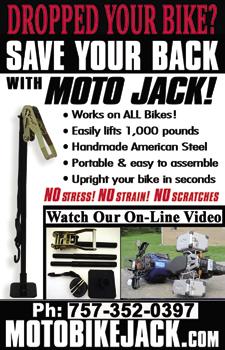



www.beemerboneyard.com ORDER ONLINE 24/7 – M/C, Visa, Discover, Paypal 973.775.3495 M ‐ F 12 ‐ 5PM Enter code BMWMOA in source code box @ checkout & click “apply” Used Oil‐Head, K‐Bike & Hex‐Head Parts – 50% of New or Less New Maintenance Parts & Tools – WAY BELOW Retail Prices NO BACKORDERS – ORDERS SHIP IN 24 HOURS 10% BMW MOA Discount Online Orders Only Beemerbon e yar d .co m Liqui‐Molyoil ‐ oil, fuel & air filters – 12/24K maintenance kits – brake pads & rotors – fuel pumps – Hall sensors – repair manuals & dvds–tools – fuel line disconnect sets – fuel injection controllers – exhausts – batteries & chargers –master cylinders & rebuild kits – starters – spark plugs & wires – cables – radiator fans – alt belts – fender extenders – Carbtune carb/TB synchronizers Join the Adventure! United Sidecar Association members embrace the cycling lifestyle and share their adventures in the club’s full-color magazine, The Sidecarist Find out how you can join us. Click here, or go to Sidecar.com. Fuzeblock Choose Constant or Switched Power No crimping, No external relay, Compact size HEATED CLOTHING • POWERLET RAM MOUNTS • BMW SPECIFIC TOOLS AUXILLIARY LIGHTING • MUCH MORE... WWW.CYCLENUTZ.COM/MOA CYCLENUTZ.COM
2024
1/11/2024
BMW RIDERS OF NORTHEAST FLORIDA WINTER RALLY Live Oak, Florida rallychair@bmwnef.org
1/27/2024 - 1/28/2024
CLUB RIDE AND CAMPOUT AT CLEAR LAKE STATE PARK Kelseyville, California president@bmwnorcal.org
1/23/2024 - 2/25/2024
MOA PREMIER TRAINING WITH RYAN AUSTIN Long Beach, California membership@bmwmoa.org
2/24/2024 - 2/25/2024
CLUB RIDE AND CAMPOUT AT PLASKET CREEK Big Sur, California president@bmwnorcal.org
3/21/2024 - 3/24/2024
DEATH VALLEY CAMPOUT Furnace Creek, California president@bmwnorcal.org
4/6/2024
2024 RTE NORTHWEST TN, EAGLE BOAT TOUR & BOYETTE’S EAT CATFISH Tiptonville, Tennessee captrehkopf@gmail.com
4/14/2024 – 4/28/2024
IMTBIKE CELEBRATION TOUR OF SPAIN FOR BMW MOA MEMBERS Madrid, Spain tours@imtbike.com
4/19/2024 – 4/21/2024
HILL COUNTRY HANGOUT 2024 Kerrville, TX makowski.michael@gmail.com
4/19/2024 – 4/21/2024
MOA GETAWAY AT FONTANA Fontana Dam, North Carolina membership@bmwmoa.org
4/26/2024 – 4/28/2024
MOA GETAWAY AT THE BREAKS Breaks, Virginia rides4fun@bmwmoa.org
4/27/2024
TEXAS NATIONAL PICNIC Jacksonville, Texas detbmw@gmail.com
5/3/2024 - 5/5/2024
GEORGIA MOUNTAIN RALLY Hiawassee, Georgia rally@bmwmcoga.org
5/9/2024 – 5/12/2024
L’INTER 2024 BMW MOA FRENCH CONNECTION Aspres-sur-Buëch, France bmwmoa.fc1980@gmail.com 5/16/2024 – 5/19/2024
DOWNEAST RALLY ‘24 Poland, Maine bob.cohen@bmwmoa.org

5/16/2024 – 5/19/2024
25th ANNUAL EUROPEAN RIDERS RALLY Burkesville, Kentucky ridersrally@bmwmcon.org
5/20/2024 – 5/24/2024
SMOKY MOUNTAIN MAGIC TOUR Fontana Dam, North Carolina becky.smith@bmwmoa.org
5/31/2024 – 6/2/2024
47TH ANNUAL HIAWATHA RALLY Houston, Minnesota hiawatharally@gmail.com
6/7/2024 – 6/9/2024
SQUARE ROUTE RALLY 2024 Sabillasville, MD bmw2.org/srr
6/13/2024 – 6/16/2024
RIDIN’ TO REDMOND NATIONAL RALLY Redmond, Oregon membership@bmwmoa.org
7/18/2024 – 7/21/2024
52ND ANNUAL TOP O’ THE ROCKIES RALLY Paonia, Colorado lowrtax@gmail.com
8/23/2024 - 8/25/2024
2024 HOPEWELL ROAD RALLY Athens, Ohio samrbooth@yahoo.com
9/6/2024 - 9/8/2024
53RD ANNUAL WISCONSIN DELLS RALLY Wisconsin Dells, Wisconsin dellsrally@gmail.com
9/13/2024 - 9/15/2024
TUG HILL TURNOUT Lowville, New York camdengroup@icloud.com
9/19/2024
FOURTH ANNUAL LAUREL HIGHLANDS WEEKEND - SPONSORED BY THE BMW MOA Somerset, Pennsylvania gsjay@kaplitz.com
10/28/2024 – 11/9/2024
BMW MOA DAY OF THE DEAD TOUR WITH MOTODISCOVERY info@motodiscovery.com
WHEN & WHERE
BMW OWNERS NEWS | January/February 2024 140




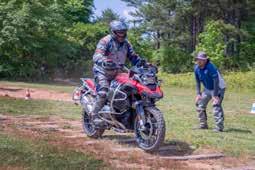

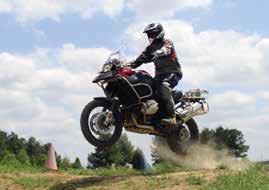

April 19-21, 2024 Kerrville, Texas Online r egistration January 1, 2024 - April 5, 2024 - $45 per person. After April 5$55 onsite by cash or check only. General questions can be directed to Mike Makowski [makowski.michael@gmail.com] or Bill Edwards [edwardsw@gvtc.com]. We look forward to seeing you in Kerrville! https://sabmwra.org/hch2024/ Hill Country Hangout 2024 2024 PREMIER TRAINING! 2024 DATES: APRIL 5 APRIL 25 MAY 17 SEPT. 27 OCT. 25 NOV. 15 Register today at bmwmoa.org January/February 2024 | BMW OWNERS NEWS 141 SQUARE ROUTE RALLY 2024 June 7-9 - YMCA Camp West Mar - Sabillasville, MD •Great venue with tent camping & bunkhouses •Bratwurst / hot dog dinner on Friday night •T iki Bar featuring German Oktoberfest Beer • Adventure Riding Seminar / Speakers • Amazing Saturday rides! • BBQ dinner + Live Bluegrass Music on Saturday night • Door prizes & Rally Awards bmw2.org/srr




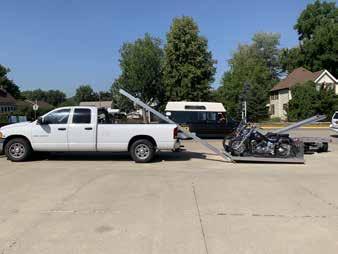
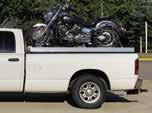

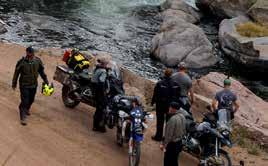


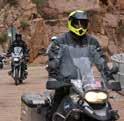



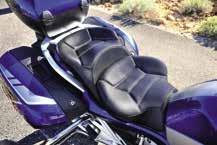



BMW OWNERS NEWS | January/February 2024 142 New gear, downloadable catalog updated website & more specials online! Darien Jacket Messenger Bags Triple Digit Glove Covers aero_bmwon_May23.indd 1 4' x 8' Pullout Drawer Under Deck MOTORCYCLE CARRIER 2 - 4 Wheel Air Ride Cargo Carrier for Bikes, Trikes, SXS, Golf Carts, Wheel Chairs • 2 Point Mount to Pickup, 5th Wheel, Travel Trailer, Motorhome, Car, Jeep, SUV • Drive On One Side to Load, Drive Off the Other Side to Unload with Pullout Self Storage 8' Ramps, 24"High • 12 V Power Loader Available in Lieu of Pullout Ramps • YouTube: Sturgis Gerry Piercey 30-40 videos and movies MOUNTAINMASTER.NET 623-451-7121 "DAY-LONG" TOURING SADDLES By Russell Support Suspension System 4917 Shasta Dam Blvd. Shasta Lake, CA 96019 (800) 432-9566 info@day-long.com www.day-long.com Help us help our vets. DONATE TODAY. MOTORELIEF.ORG 5-day Relief Rides on BMW GS ADVENTURE BIKES at no cost to participants. Have a bike you no longer need? DONATE A BIKE of any make or model. Motorcycle Relief Project (MRP) HELPS VETERANS with Post Traumatic Stress Disorder (PTSD) DECOMPRESS, VETERANS RECOVERY. connect with other and take meaningful steps toward GET UNSTUCK,
Managing Editor BILL WIEGAND | bill@bmwmoa.org
Art Director KARIN HALKER | karin@bmwmoa.org
Digital Media Editor WES FLEMING | wes@bmwmoa.org
Associate Editor RON DAVIS
A ssociate Editor JOSE ABILES
Yamaha Champions Riding School, Berinie Stukenborg, Tom Gary, Joe Marsala, Joe Lusso, Gary Loomis, Matt Rowe, Sammy Turner, Bruce Booth, Riley Armstrong, Karl Zuercher, Bill Stranahan, Wes Fleming, Mark Novack, Mark Barnes, Reece Mullins, Dustin Silvey, Kandi Spangler, Ed Housewright, Tami Bakke, Scott Lindroth, Mark Thompson, Bill Wiegand, Ron Davis, Ted Moyer, Rik Lewis, Jon DelVecchio, Amanda Taylor, Scott Robinson, Eric Beal, Daniel Teng, Richard Strong, James Lopez, Larry Sonestreet, Chloe Carson, Mike Chapman, Gray Buckley and Mike McCarary.
Advertising Director CHRIS HUGHES | chris@bmwmoa.org
Executive Director TED MOYER | ted@bmwmoa.org
Membership Associate TONYA MCMEANS | tonya@bmwmoa.org
Membership Manager PAULA FITZER | paula.fitzer@bmwmoa.org
Chief Operating Officer BECKY SMITH | becky.smith@bmwmoa.org
BMW MOA Headquarters
2350
Membership in
SC 29651 (864) 438-0962
Motorcycle Owners of America is open to all riders, regardless of brand affiliation. Although we are united by the BMW marque, adventure-minded motorcyclists will find a home here. Join today by visiting bmwmoa.org or call one of our friendly membership associates at 864-438-0962.
Hwy. 101 South, Greer,
BMWMOA.ORG ADVERTISING INDEX Adaptiv Technologies 47 AdMore Lighting 21 Adriatic Moto Tours ..............................133 Adventure New Zealand Tours 53 Aerostich-Rider WearHouse ..............142 Alaska Leather 119 Beemer Boneyard 139 Beemer Shop, The .................................109 Best Rest Products/Cycle Pump 47 Bing ............................................................140 Black Box Embedded 109 Boxer Works Service .............................119 Capital Cycle.............................................. 53 Cyclenutz 139 Edelweiss Bike Travel ...........................108 Euro Moto Electrics 109 Geza Gear .................................................139 Helmet Sun Blocker 119 HEX ezCAN 119 Hill Country Hangout ..........................141 Ilium Works 5 IMTBike Tours ........................................... 21 M4Moto 109 MachineartMoto 139 Max BMW ......................................................1 MOA Foundation Spring Raffle 9 MOA Platinum Roadside Assist........112 MOA SafeMiles 113 Morton’s BMW 53 Moto Bike Jack .......................................139 Moto Bins 47 MotoDiscovery ......................................... 37 Motorcycle Relief Project 142 Mountain Master Truck Equip ...37, 142 Overseas Speedometer ........................ 37 Pacific Moto Tours 37 Portugal Motorcycle Tours .................. 37 Progressive Insurance BC Redverz .....................................................119 Re-Psycle BMW Parts ............................. 47 Roadrunner Magazine 119 Rocky Creek Designs.................................7 Ron Davis - Rubber Side Down 133 Russel Cycle Products ..........................142 Sargent Cycle Products 5 Sidecarist Magazine 139 Square Route Rally ...............................141 Touratech IFC Vanson Leathers ...................................... 53 Weiser Technik 14, 15 BMW ON (ISSN:1080-5729) (USPS: 735-590) (BMW Owners News) is published monthly by BMW Motorcycle Owners of America Inc., 2350 Hwy 101 South, Greer, SC 29651. Periodicals postage paid at Greer, SC and additional mailing offices. Opinions and positions stated in materials/articles herein are those of the authors and not by the fact of publication necessarily those of BMW MOA; publication of advertising material is not an endorsement by BMW MOA of the advertised product or service. The material is presented as information for the reader. BMW MOA does not perform independent research on submitted articles or advertising. POSTMASTER: SEND ADDRESS CHANGES TO BMW ON, 2350 Hwy 101 South, Greer, SC 29651 ©2023 by BMW Motorcycle Owners of America Inc. All information furnished herein is provided by and for the members of BMW Motorcycle Owners of America, Inc. Unless otherwise stated, none of the information (including technical material) printed herein necessarily bears endorsement or approval by BMW MOA, BMW NA, the factory or the editors. The editors and publisher cannot be held liable for its accuracy. Printed in the USA. Volume 54, Number 1,2. EDITORIAL CONTRIBUTORS SALES & MARKETING MEMBER SERVICES MEMBERSHIP January/February 2024 | BMW OWNERS NEWS 143
the BMW

TAILIGHT
A Mission From God
Mike McCrary (#148315) found Jake and Elwood at a service station in New England, far away from their Chicago homes.
LIFESTYLE COLLECTION

In our continuing efforts to bring innovative products and services to our membership, the MOA is excited to offer The Lifestyle Collection. For the first time, the MOA and Klim are offering co-branded apparel. Klim is the global leader in designing, developing and manufacturing, the most advanced technical riding gear and motor sports apparel for motorcycle riders.
Collection LIFESTYLE the
MOALIFESTYLE.ORG


America’s # 1 MOTORCYCLE INSURER 1-800-PROGRESSIVE | PROGRESSIVE.COM Progressive Casualty Insurance Co. & affiliates. I hear music. Like PHANTOM TELEPHONES THE PATTERN-LOVING BRAIN, SEEKING SIGNALS in the noise, RAISES ACOUSTIC GHOSTS OUT of the wind’s ROAR. ALL HIDDEN IN THE AIR and RELEASED by SPEED. from Season of the Bike by Dave Karlotski Quote in as little as 3 minutes America’s # 1 MOTORCYCLE INSURER 1-800-PROGRESSIVE | PROGRESSIVE.COM Progressive Casualty Insurance Co. & affiliates. I hear music. Like PHANTOM TELEPHONES THE PATTERN-LOVING BRAIN, SEEKING SIGNALS in the noise, RAISES ACOUSTIC GHOSTS OUT of the wind’s ROAR. ALL HIDDEN IN THE AIR and RELEASED by SPEED. from Season of the Bike by Dave Karlotski Quote in as little as 3 minutes


























 Above, An early fall sunset along Skyline Drive in the Blue Ridge Mountains of Virginia. Photo by Joe Marsala #233942.
Top right, My '01 R 1150 GS overlooking Shadow Mountain Resort in Estes Park, Colorado. Photo by Joe Lusso #121441.
Middle right, A stop along the road while riding near San Francisco Cahuacua, Oaxaca, in southwestern Mexico. Photo by Gary Loomis #193651.
Bottom right , Maclaren Summit on Alaska's Denali Highway as the first snow of the season sticks to the ground. Photo by Matt Rowe #220161.
Opposite page top left, Camping in Canada's Gros Morne National Park in Newfoundland. Photo by Sammy Turner #233782.
Opposite page top right, A shot from the Valley of the Gods near Mexican Hat in southeastern Utah. Photo by Bruce Booth #198658.
Opposite page lower left, Spoiled by my heated grips during one of my last rides of the season here in Wisconsin. Photo by Riley Armstrong #233520.
Above, An early fall sunset along Skyline Drive in the Blue Ridge Mountains of Virginia. Photo by Joe Marsala #233942.
Top right, My '01 R 1150 GS overlooking Shadow Mountain Resort in Estes Park, Colorado. Photo by Joe Lusso #121441.
Middle right, A stop along the road while riding near San Francisco Cahuacua, Oaxaca, in southwestern Mexico. Photo by Gary Loomis #193651.
Bottom right , Maclaren Summit on Alaska's Denali Highway as the first snow of the season sticks to the ground. Photo by Matt Rowe #220161.
Opposite page top left, Camping in Canada's Gros Morne National Park in Newfoundland. Photo by Sammy Turner #233782.
Opposite page top right, A shot from the Valley of the Gods near Mexican Hat in southeastern Utah. Photo by Bruce Booth #198658.
Opposite page lower left, Spoiled by my heated grips during one of my last rides of the season here in Wisconsin. Photo by Riley Armstrong #233520.
















 – Linda and Darrin Webb #225705
– Linda and Darrin Webb #225705




























































 Low Beams - yellow vs white.
Low Beams - yellow vs white.
























 By Dustin Silvey # 224778
By Dustin Silvey # 224778























































 Clockwise from top left, Within the new MOA Foundation Historical Archive as renovations continue. Right, An R nineT GS sits on a stand within the Historical Archive. Bottom left, Some of the MOA volunteers who stepped up to help with the Historical Archive build.
Clockwise from top left, Within the new MOA Foundation Historical Archive as renovations continue. Right, An R nineT GS sits on a stand within the Historical Archive. Bottom left, Some of the MOA volunteers who stepped up to help with the Historical Archive build.







































 MOA Foundation President
MOA Foundation President

 Dan Finazzo MOA Foundation Treasurer
Dan Finazzo MOA Foundation Treasurer

 Marshall "Marty" martin
MOA Foundation Director
Marshall "Marty" martin
MOA Foundation Director




















































